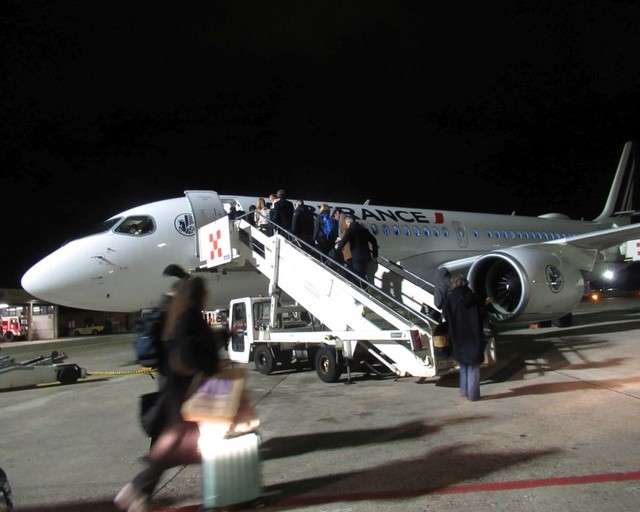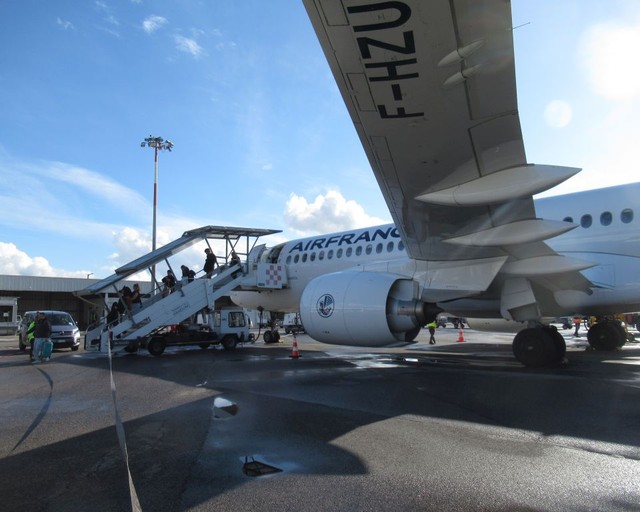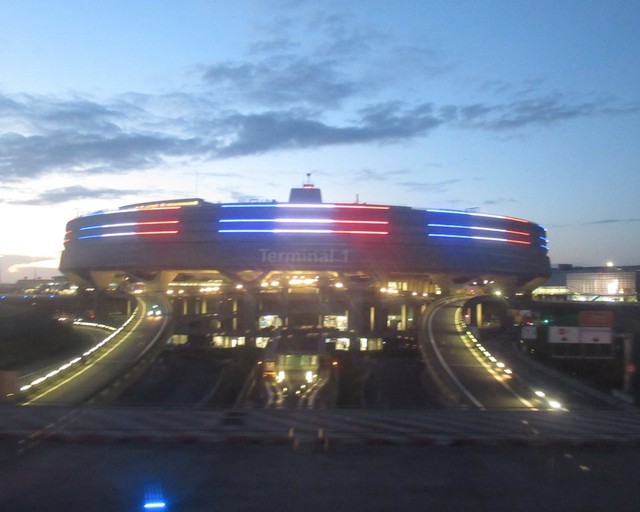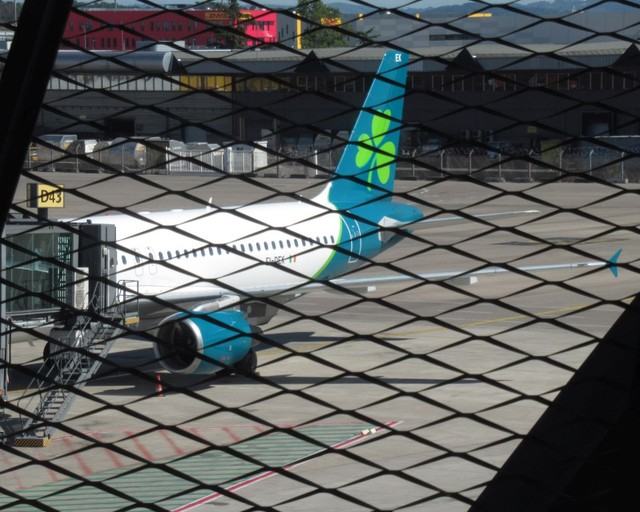This is my second black list leg in my vacation in Indonesia:
CDG - NRT : Air France (Boeing 777-300ER) Sunrise
NRT - DPS : Garuda Indonesia (Boeing 777-300ER) The island of Gods
DPS - JOG : Garuda Indonesia (Boeing 737-800) The city of the Ramayana
JOG - SUB : Sriwijaya Air (Boeing 737-800) A zero height volcano (You are here)
MLG- DPS : Wings Air (ATR72-600) The sulfur volcano You are here
DPS – ICN : Garuda Indonesia (Airbus 330-300) The calm of the morning (English version to be posted)
ICN – CDG : Korean Air (Airbus 380-800) Bad flight (English version to be posted)
This flight illustrates the instability of the Indonesian domestic air travel landscape, for I had initially planned to fly from Surabaya (SUB) to Labuan Bajo (LBJ) - the gateway to Komodo National Park – with Sky Aviation, on a route operated with Sukhoi Superjet 100, and partially described here in French. But when I tried to book tickets on SY through an Indonesian online travel agency I received this answer:
Thank you very much for visiting our site.
Further to your email, let us inform that Sky Aviation is not operated.
The airline would not serve any flight schedule anymore.
Could you inform your flight detail please. And we would check it for you.
We looking forward to you.
SY was bankrupt and all its flight had been suspended by the Indonesian Ministry of transportation. Merpati, which operated equally exotic Chinese made Xi'an MA-60 on the DPS-LBJ segment was also going down the drain. There went the SSJ100, the MA-60, and my visit to Komodo NP, because it had become impossible to travel from East Java to LBJ within the same day, which meant a compulsory night near DPS and a significant waste of time on both the way in and out. I had to do with this dragon of Komodo at the Bali Bird Park, and it became more convenient to leave Java from the small Malang airport, which had not been reported on FR so far.

Contrary to Sriwijaya Air, buying a Wings Air ticket is very easy on the website of its owner Lion Air. In hindsight, the standard check-in deadlines were not applicable in a tiny airport like MLG, and nobody asked me to produce the credit card used for buying our tickets.
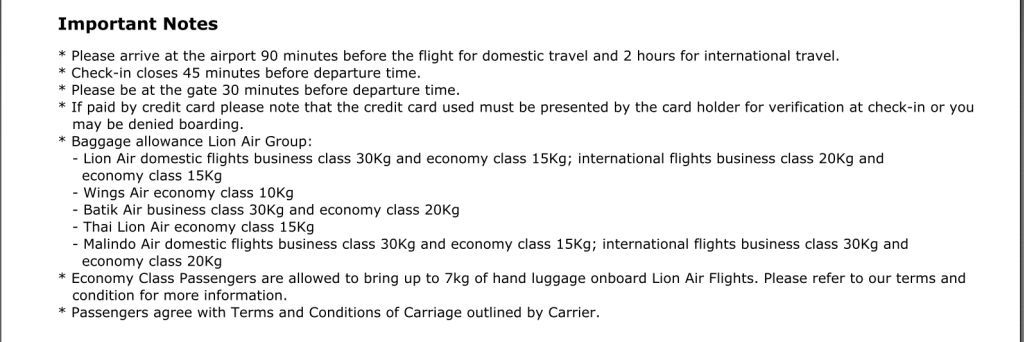
I could not know that in advance, and this FR starts with the arrival in MLG, by taxi from the city center, way ahead of time. The taxi driver had warned us against traffic jams which did not materialize: we saw on the way a festival which either had not yet, or was done taking all the space on that avenue. The ride cost us 55 040 IDR, plus 3 000 IDR entrée fee in the airport grounds, or roughly 5 USD for 13.4 km.

Malang is a small town, and is a very small airport. One day, there will be a modern terminal …
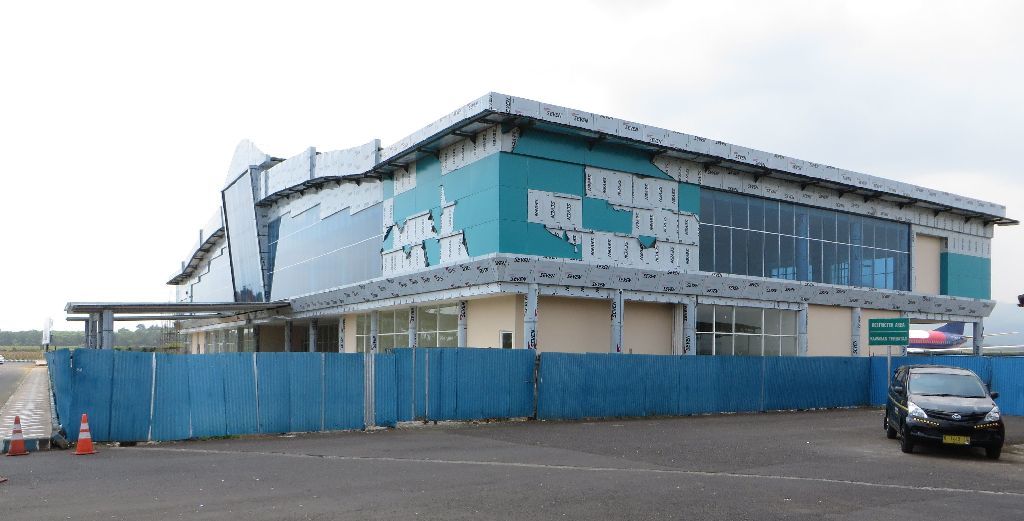
… but in August 2014, there was still only this tiny terminal typical of my favorite countryside airports.
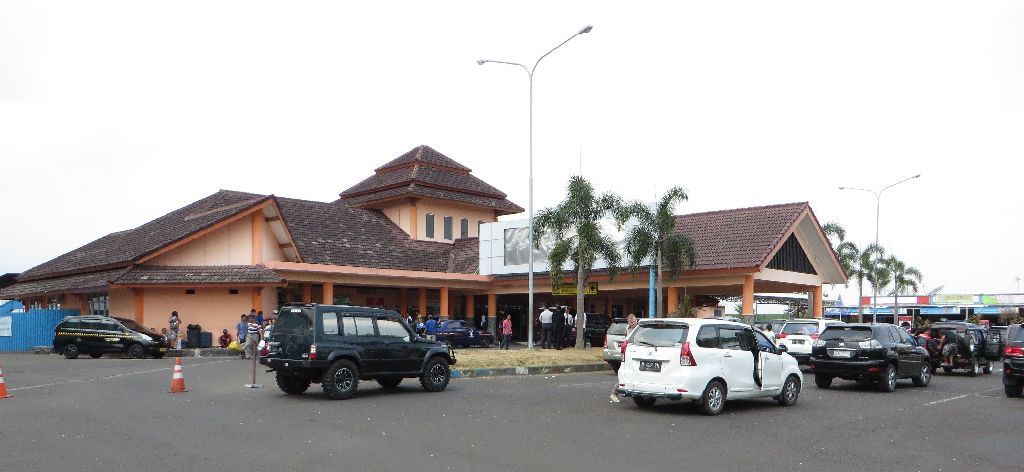
The parking lot was equally small
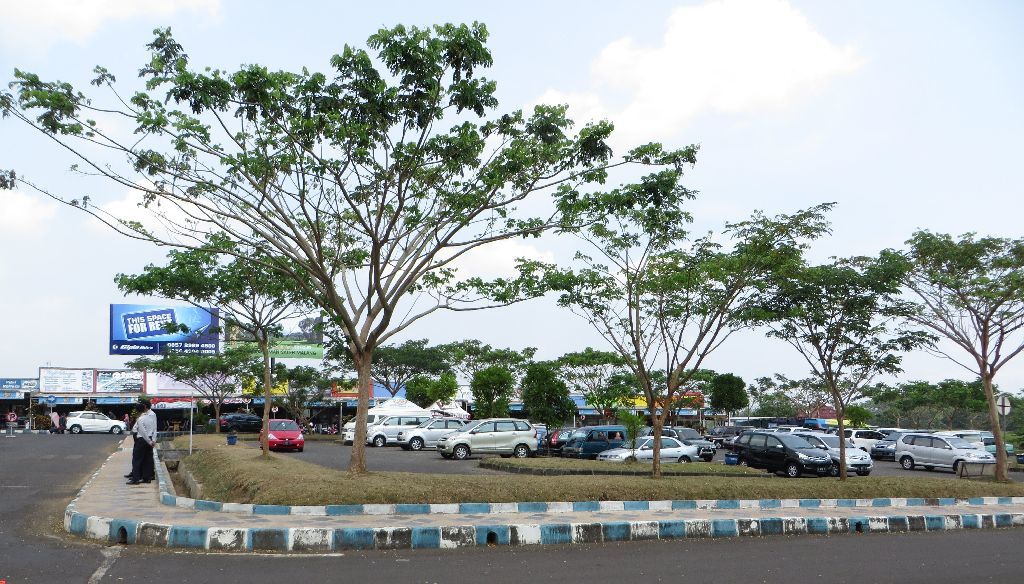
Like (apparently) everywhere in Indonesian airports, there is an initial cursory X ray check of the luggage before ou can enter the building; you have here a comprehensive view of the landside area, with the security check towards the airside area, background left.
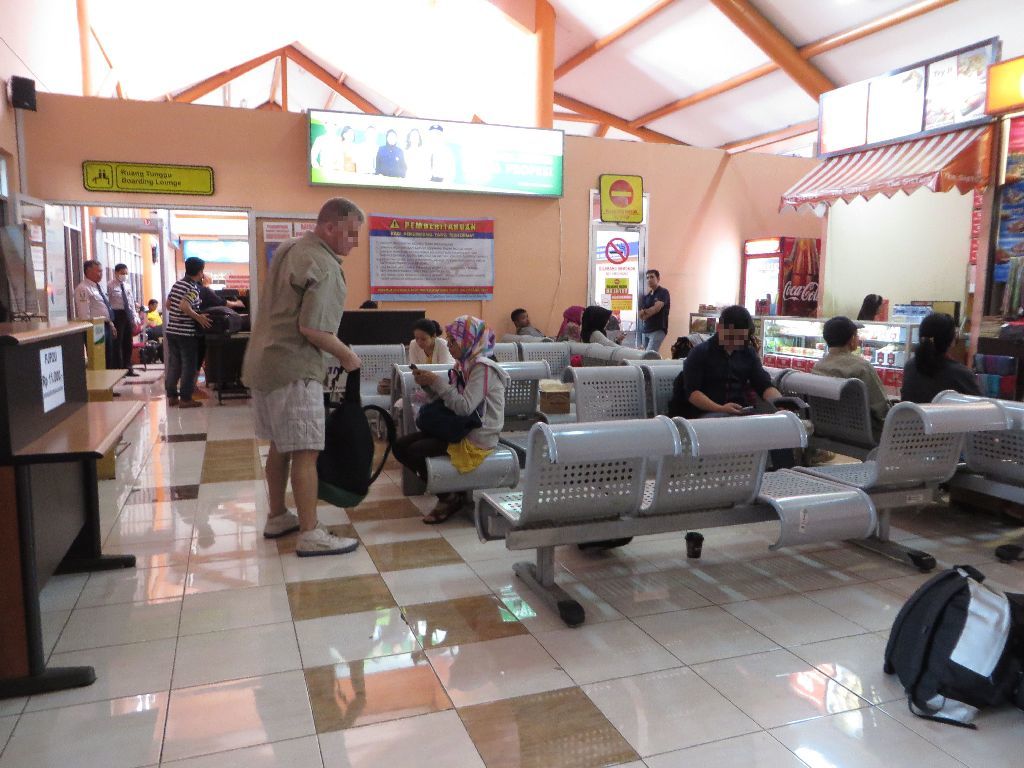
On the opposite side, there is a sandwich stand and the access to the only toilets for public use in the building, or possibly in the airport.
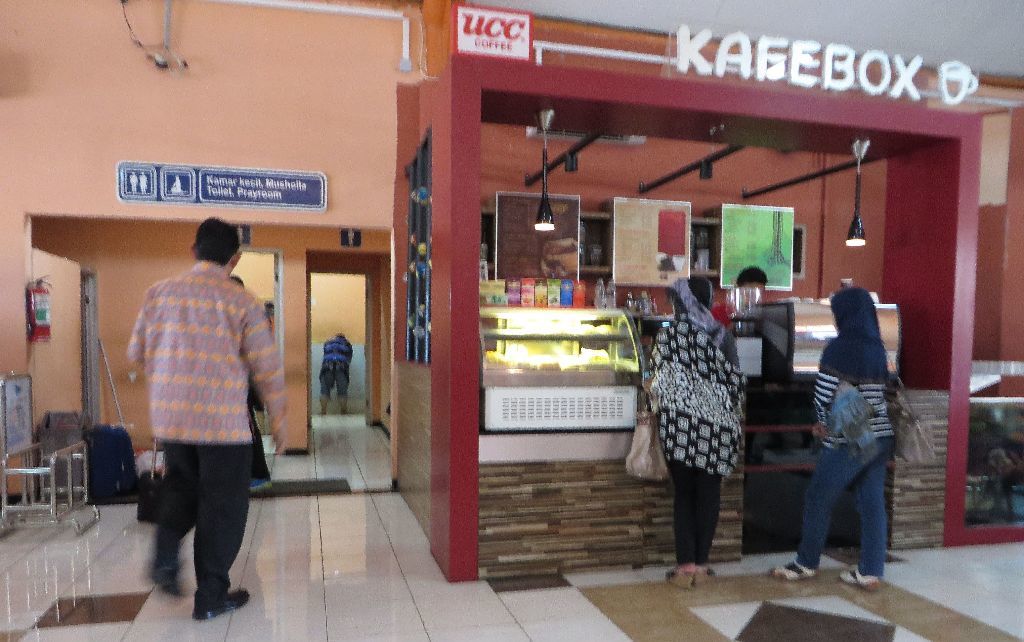
… and the check-in counters to the right of the first picture.
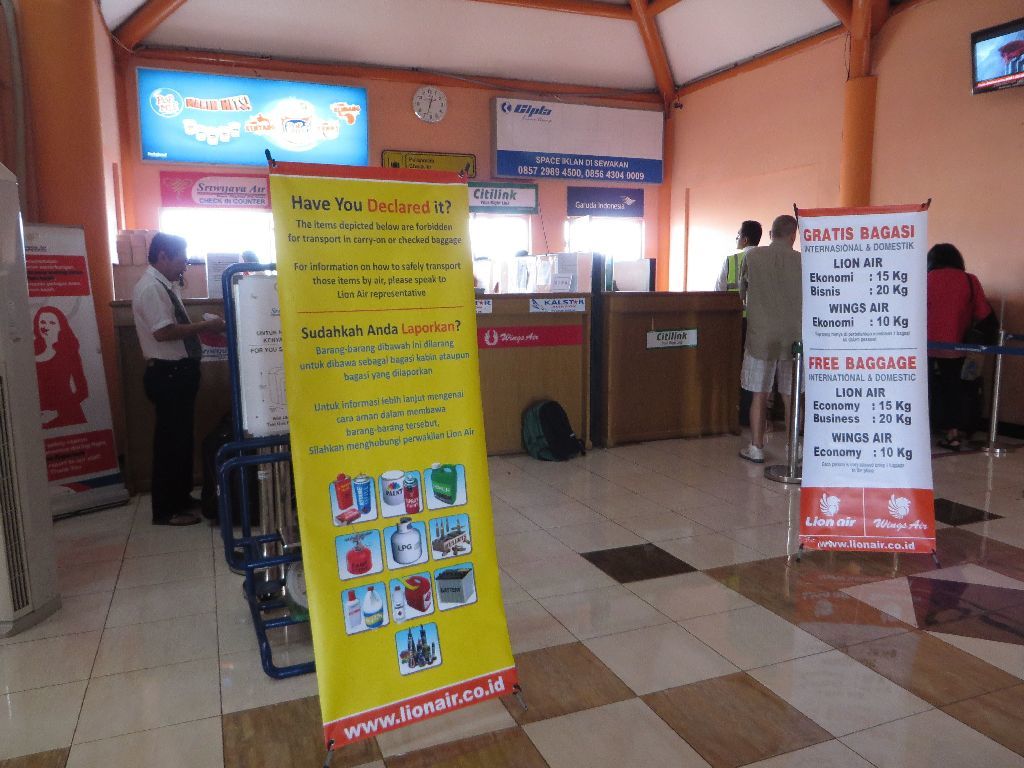
A 10kg checked luggage allowance, and a single hand luggage according to the panel on the right. The fee for extra checked luggage is nowhere to be found on the website of Wings / Lion Air, but I had found an order of magnitude in an Indonesian blog. I had thought that my laptop case would not count as a hand luggage, but I managed to squeeze the contents of our two daypacks into a single one. Not that eventually anybody seemed to be picky about that.
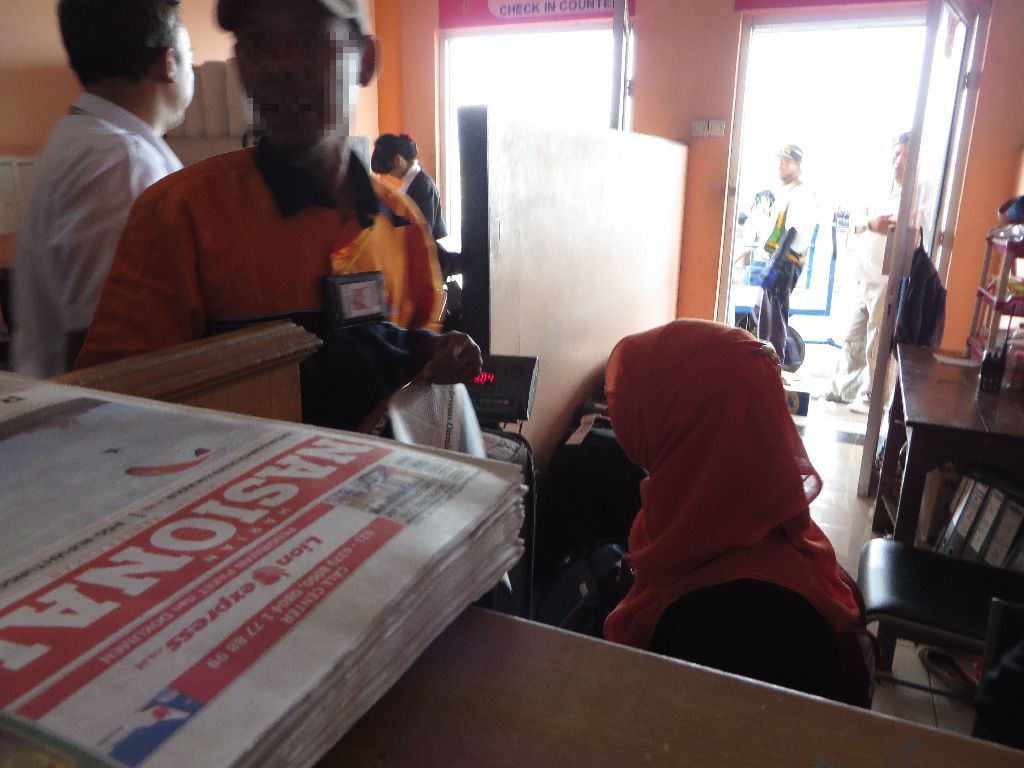
Check in with the smiling staff went smoothly. The first suitcase was slightly above 10kg – she made no fuss about a few hundred grams, and the other one reached the 19 kg mark. With an unchanging smile, she told me that there would be a surcharge and told me the rate: 11,000 IDR per kilo, i.e. around 0.50 USD! It was half what I had managed to find on the internet, and it was really not worth bothering about hand luggage optimization. She added: When you are back, do not wait in the line to give me the receipt.
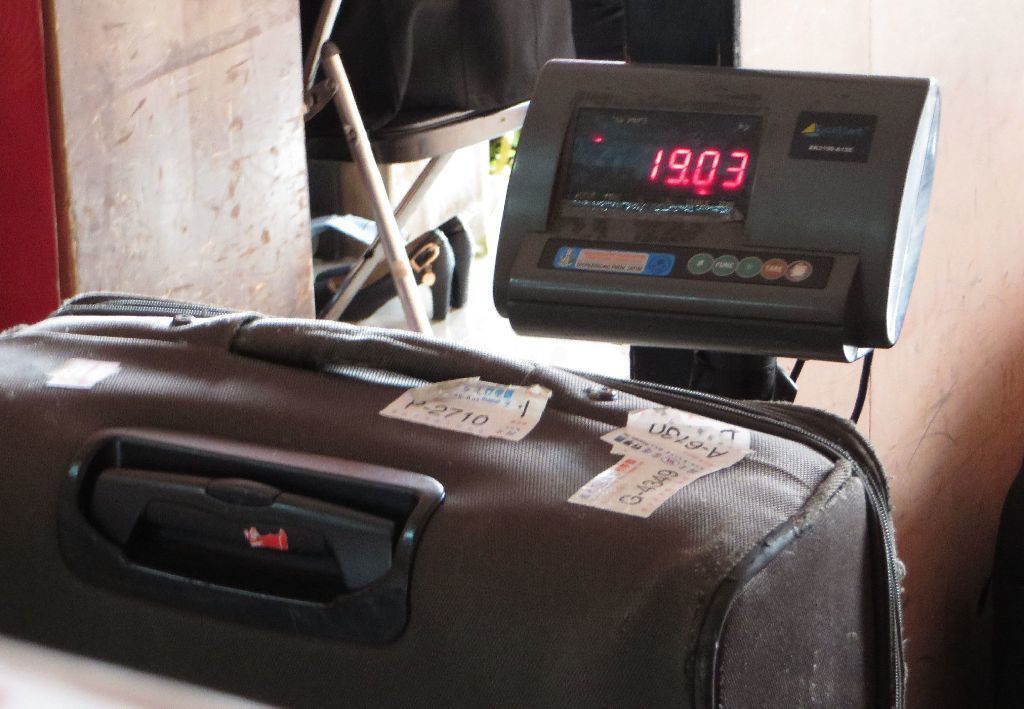
That whopping 4.50 USD surcharge had to be paid at Wings Air's ticketing counter outside the terminal.
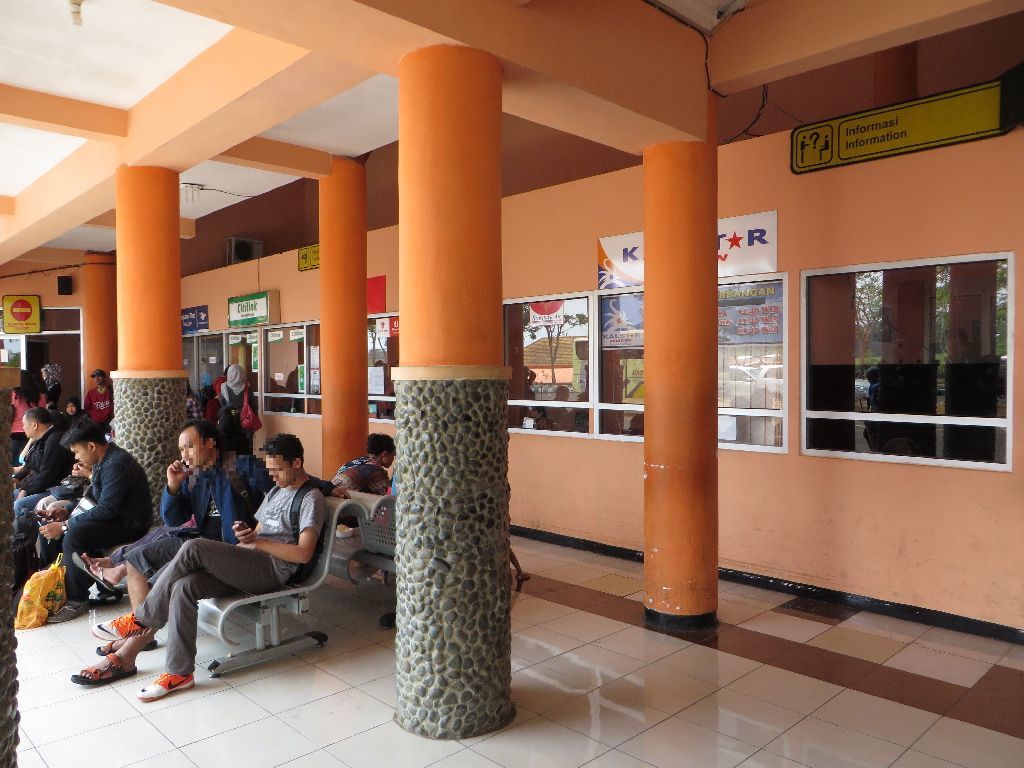
Nine kilos meant a 99,000 IDR surcharge: I gave a 100,000 IDR bill – the highest denomination in Indonesia,
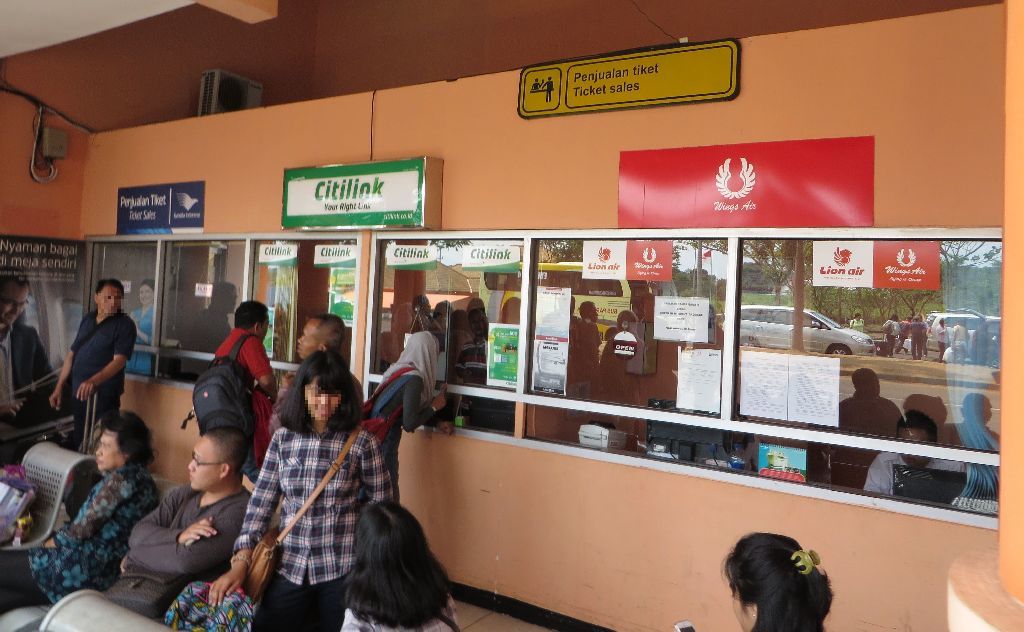
… and I received two copies of this stamped receipt, one of them stapled to my e-ticket printout which already had the checked luggage tag receipts. The ink was exceedingly pale, and I increased the contrast dramatically to make it legible here.

I returned to the check-in counter inside and instantly received the BPs which were ready. Note that although this was a Wings Air flight, these BPs bear a Lion Air logo and flight number: JT1841 instead of IW1841.
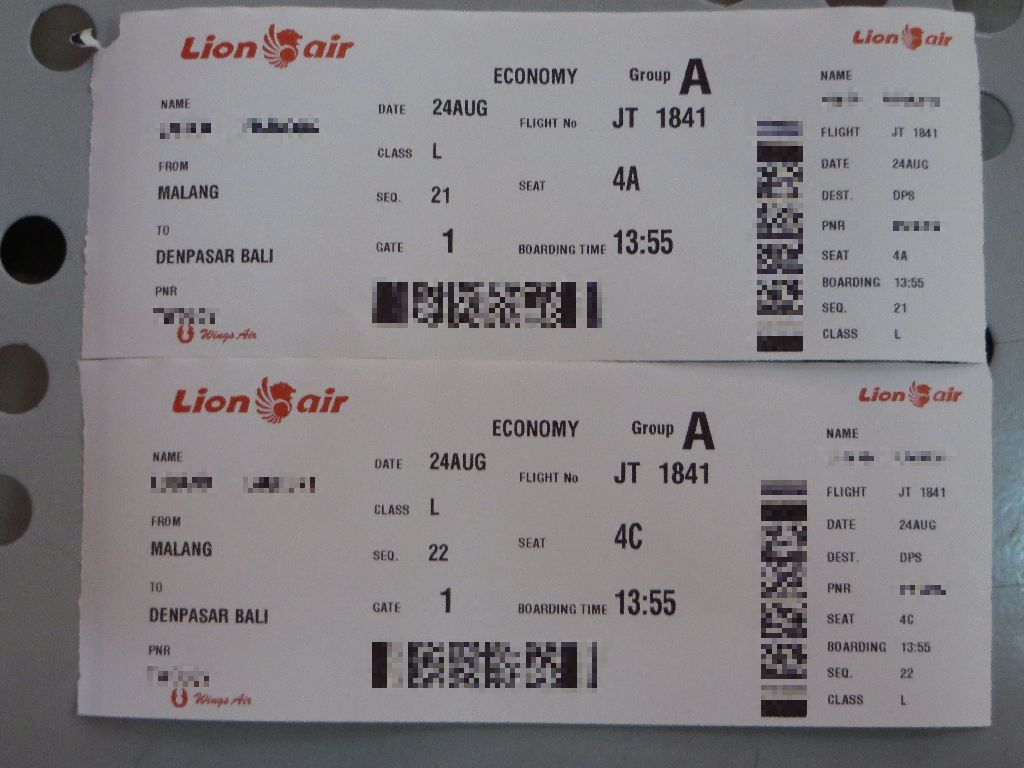
There was another even cheaper expense: the airport tax to be paid at this counter on the left. MLG is a tiny airport, and so is its tax: 11,000 IDR per passenger, i.e. 0.50 USD.
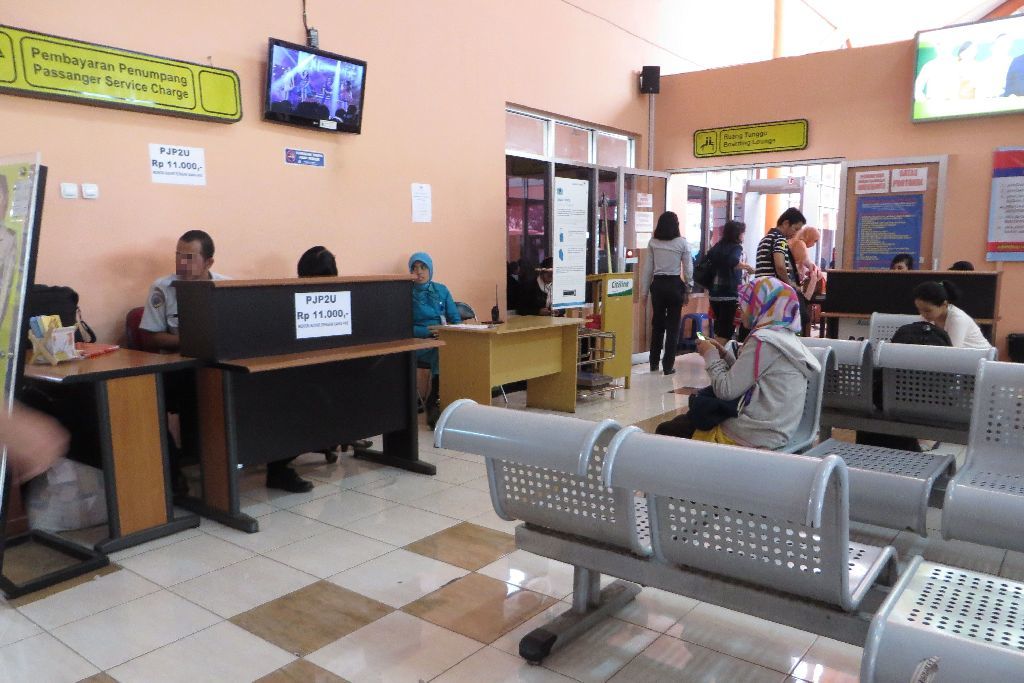

We went through the security check like a breeze. All staff on the ground (and in the air, for that matter), without a single exception, was efficient, courteous, friendly and even more smiling than their Taiwanese counterparts, which is a commendable feat.
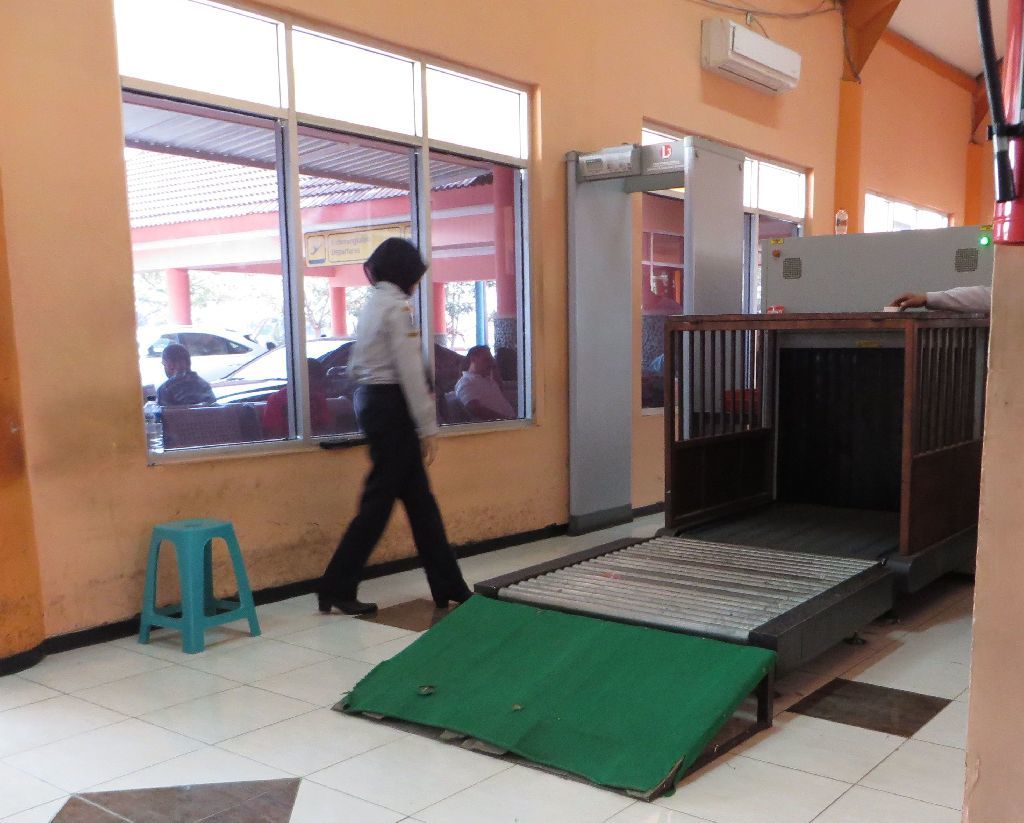
The airside area is a single room, with the same metal seats as landside. This is what the security check, with a curtain under the clock which could be drawn polling booth –like to search a passenger.
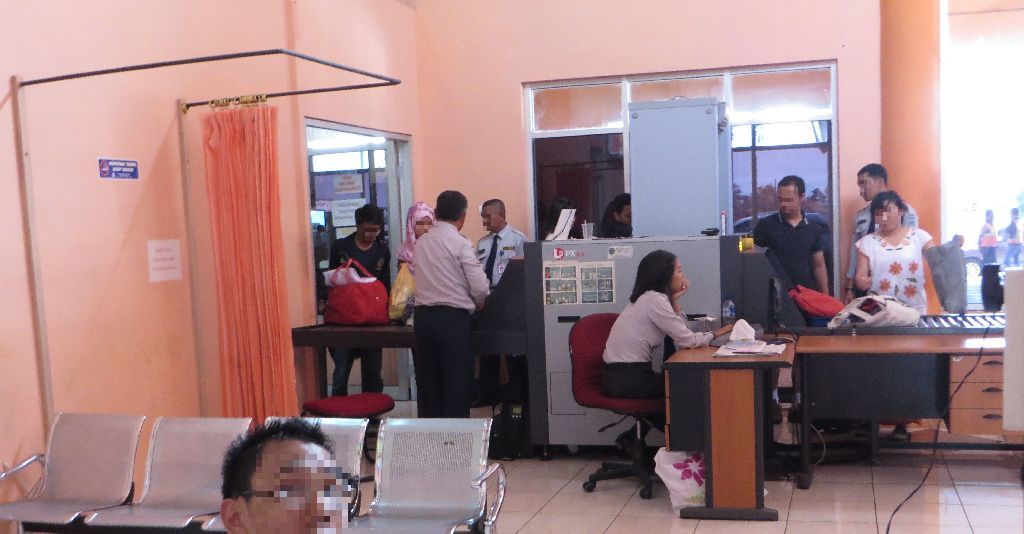
There are no toilets airside: you have to go back landside through a side door (and go through the security check again, but it is really fast and hassle-free).
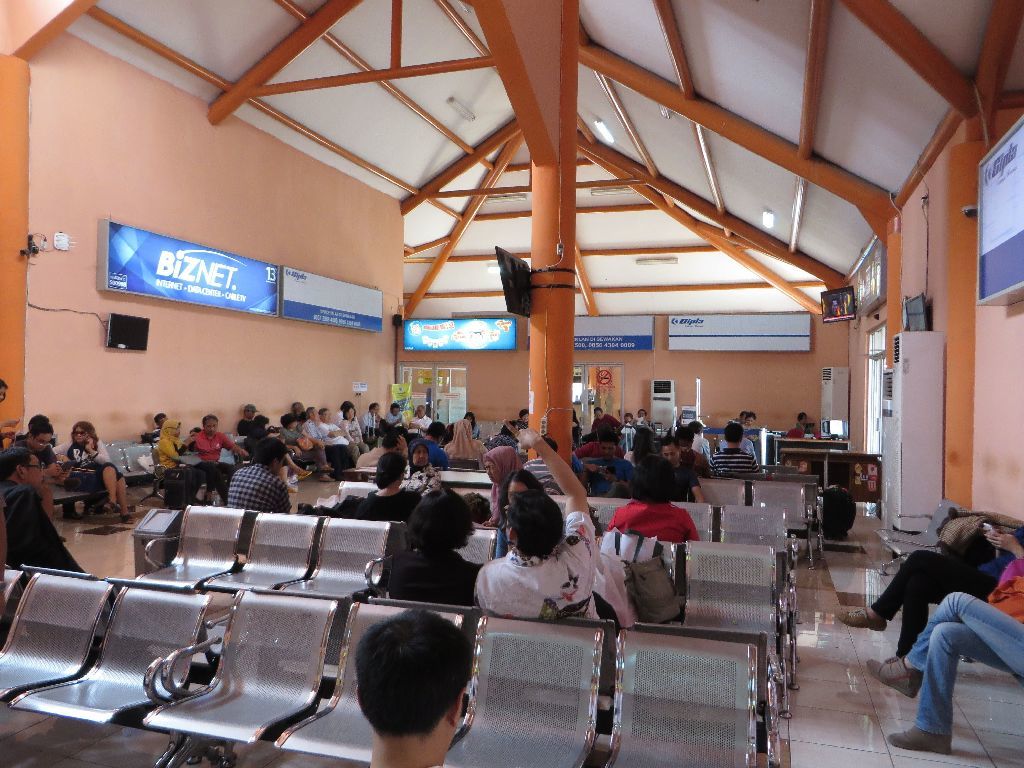
On the other hand, there are enough power ports for the needs of the passengers, on this pillar and on a similar one, and even a table where a student is studying his textbook.
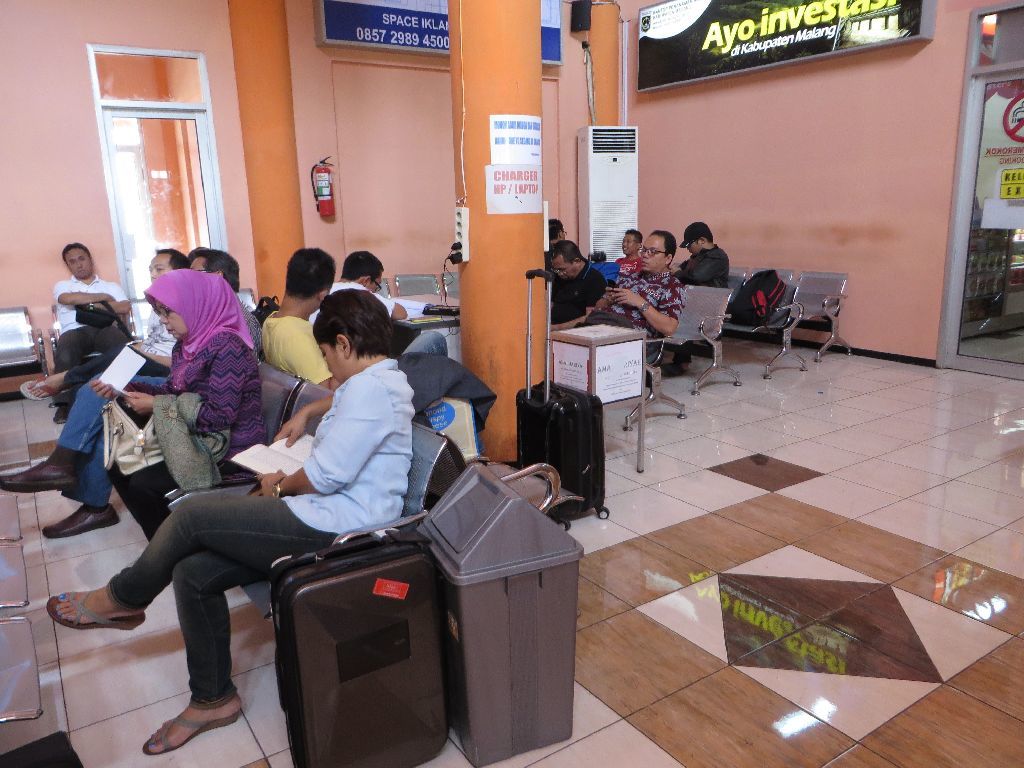
And there is a free wifi internet access
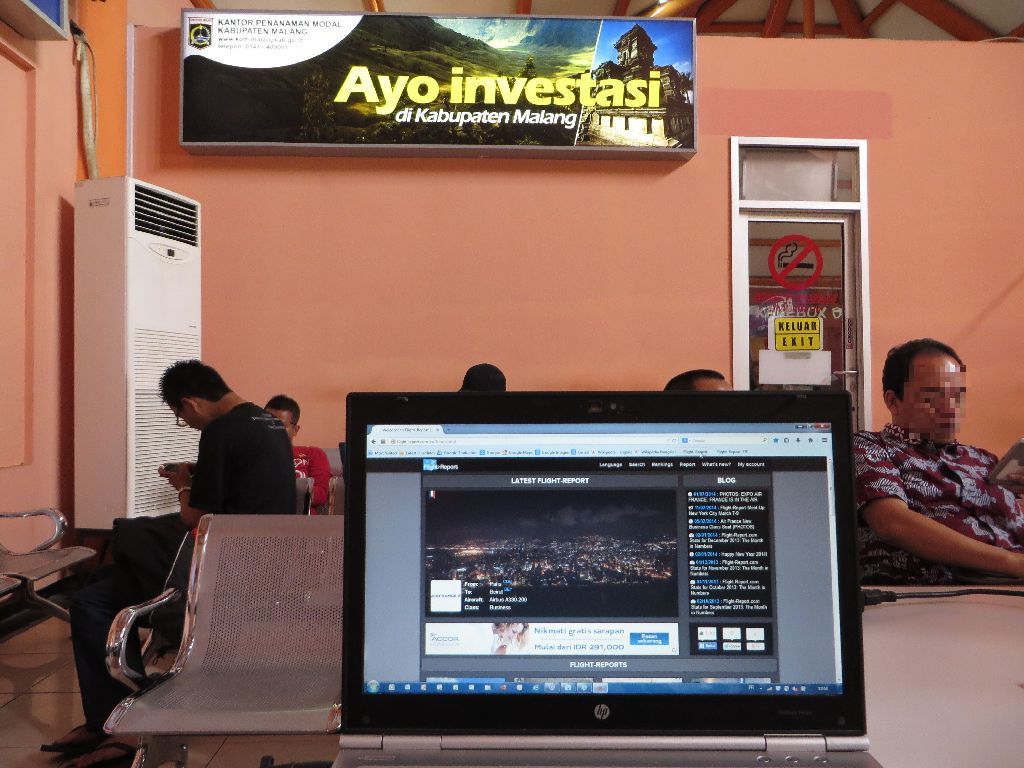
The furniture at the only gate of the airport is the cheapest and most worn kind that I ever saw in an airport.
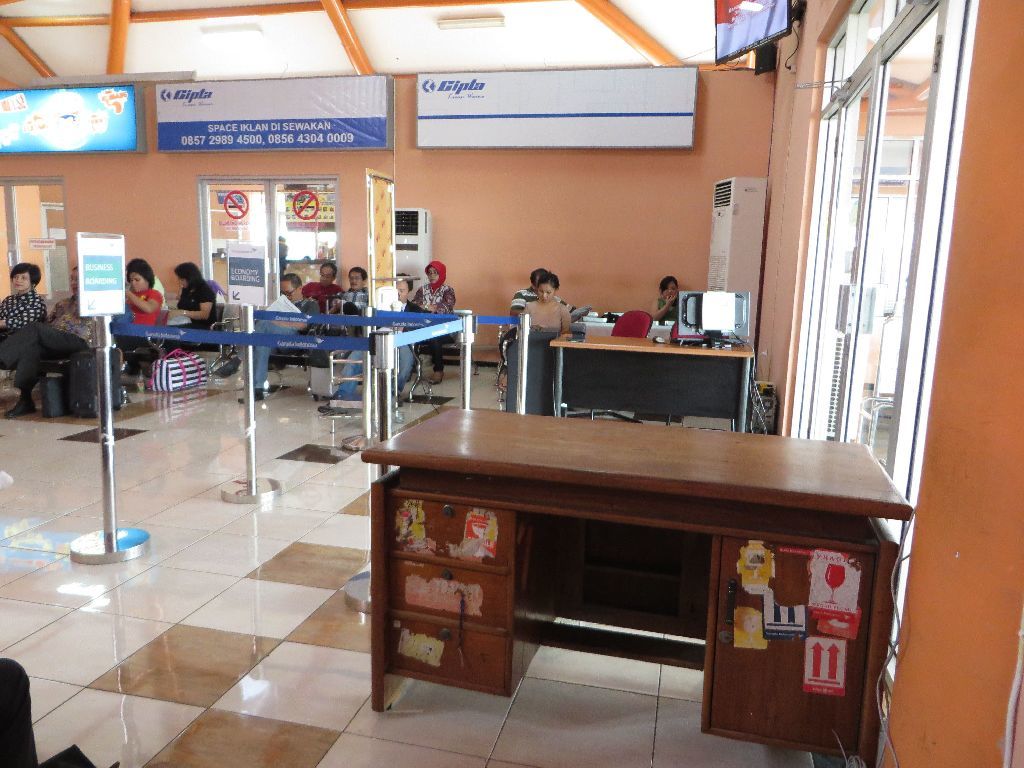
Arrival of the GA 738 operating the next flight to Jakarta. Note the pillar which will be somewhat in the way for taking pictures. MLG is not very plane spotter friendly, but I have seen much worse than that, and there is hardly more than a plane at a time on the tarmac.
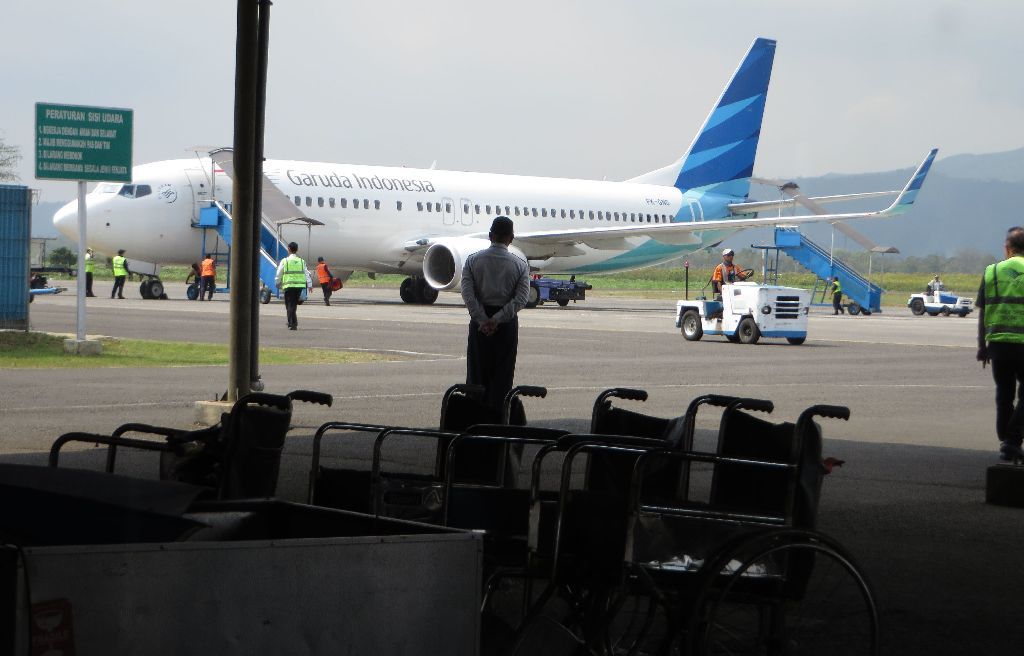
Boarding of the GA flight begins
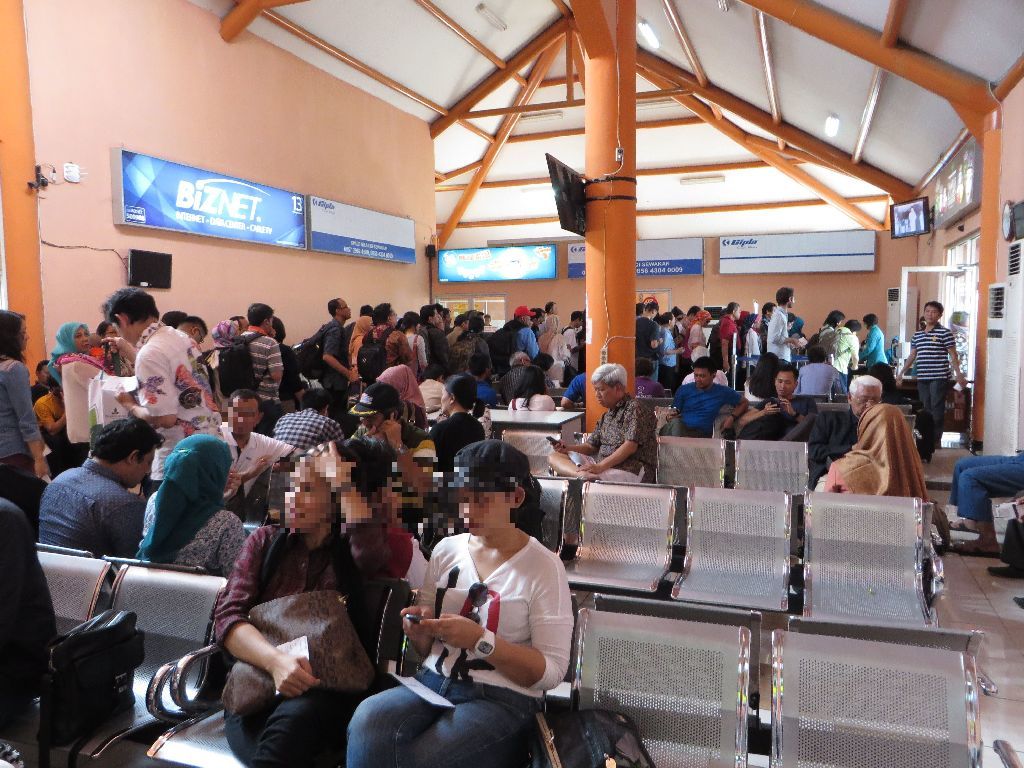
… and ends, and the airside room becomes suddenly a lot more empty and therefore quieter
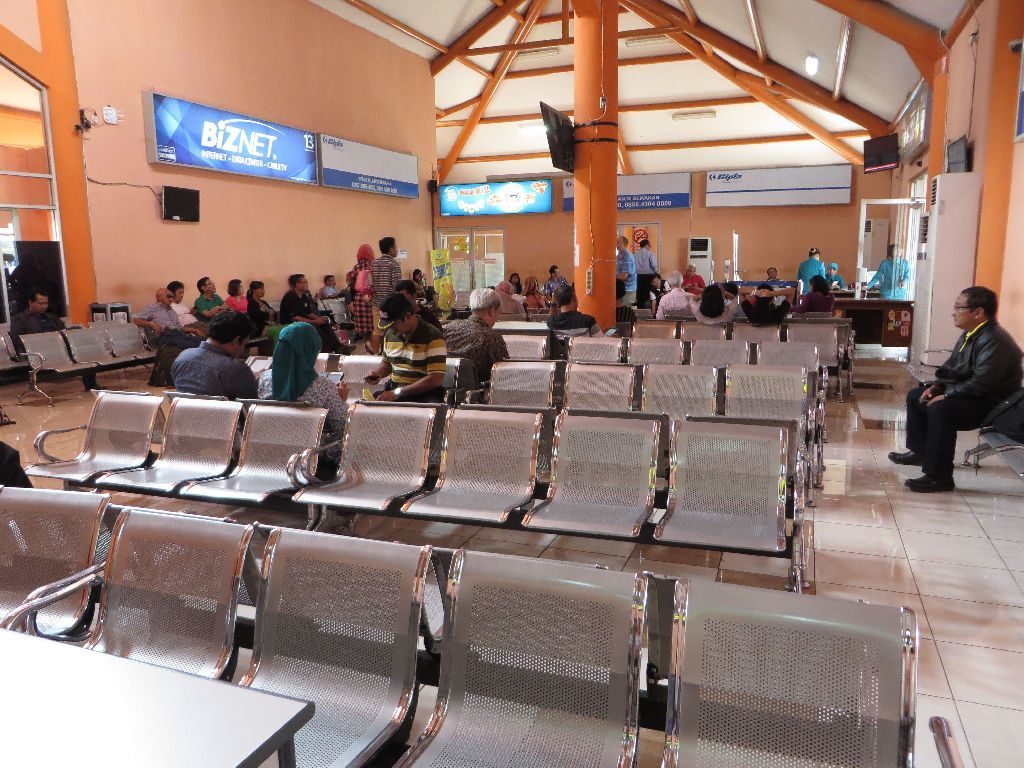
The last passengers board the 738
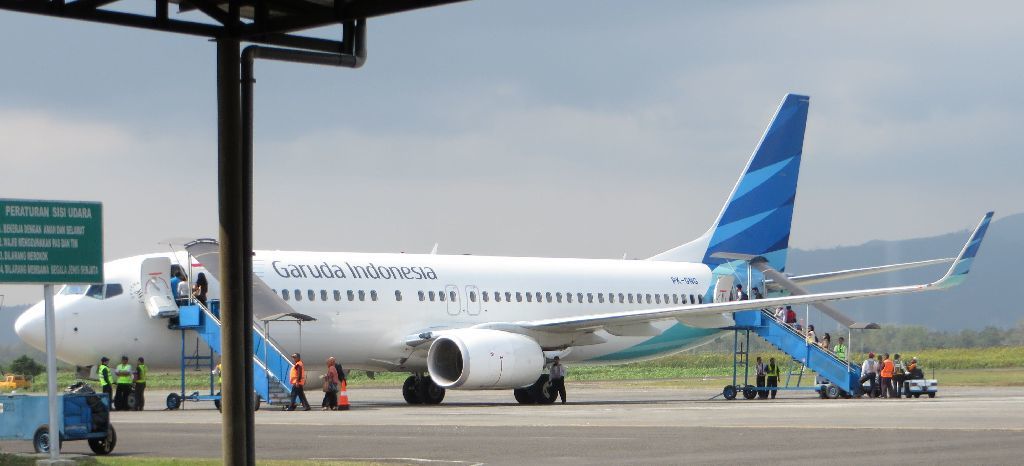
Pushback, in high contrast lighting conditions
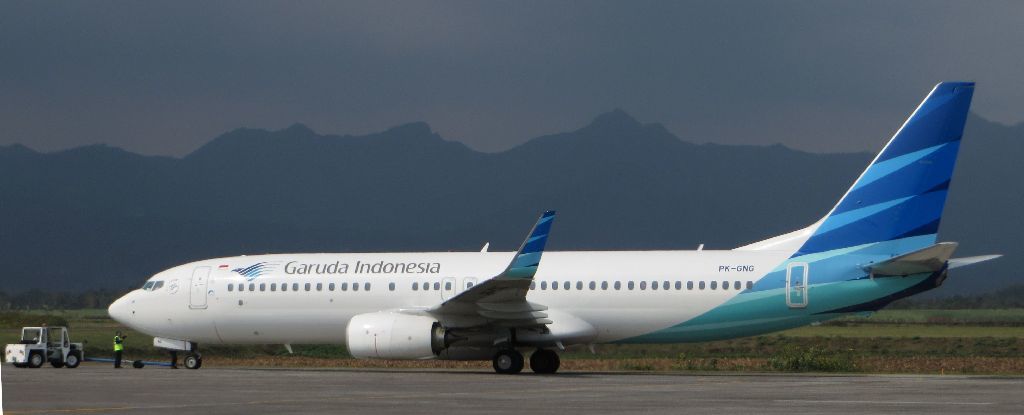

… and the plane taxies away
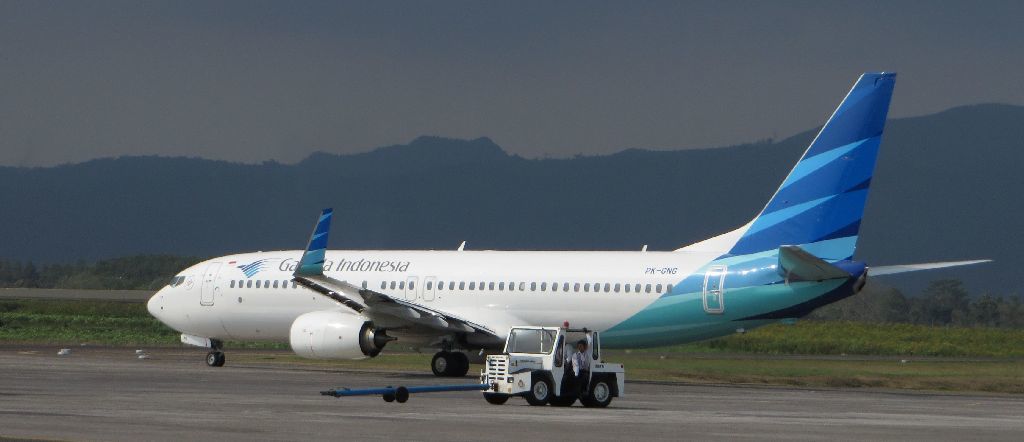
… turning there to reach the runway

… lines up

… and starts its take off run, taking to the air out of view from the gate
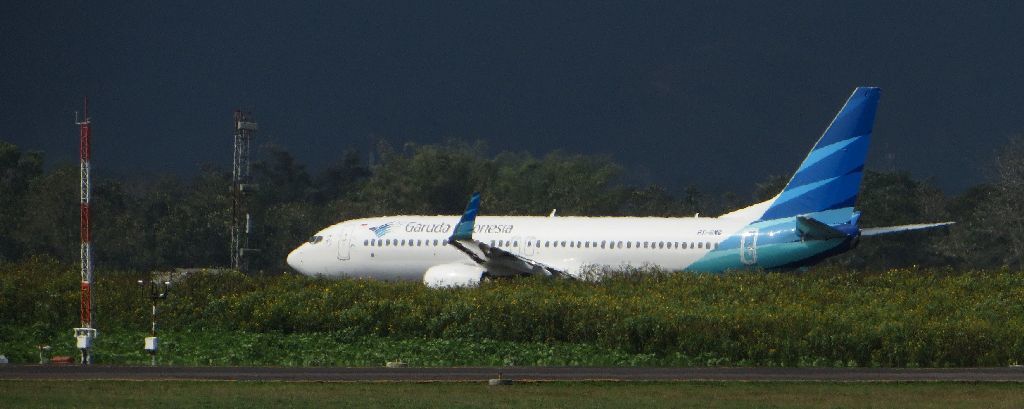
The Wings Air ATR72 arrives soon afterwards. It is 14:33, i.e. eight minutes after its scheduled departure time towards DPS. Punctuality is not the main characteristic of Indonesian domestic flights.
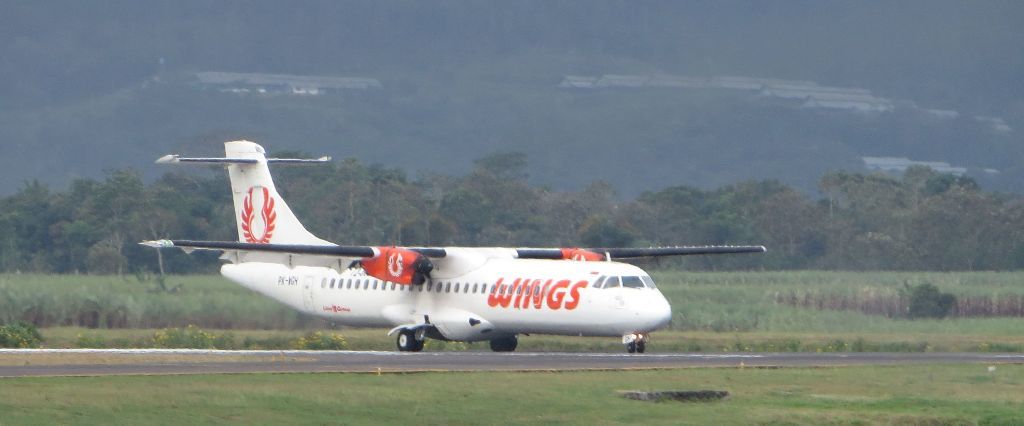
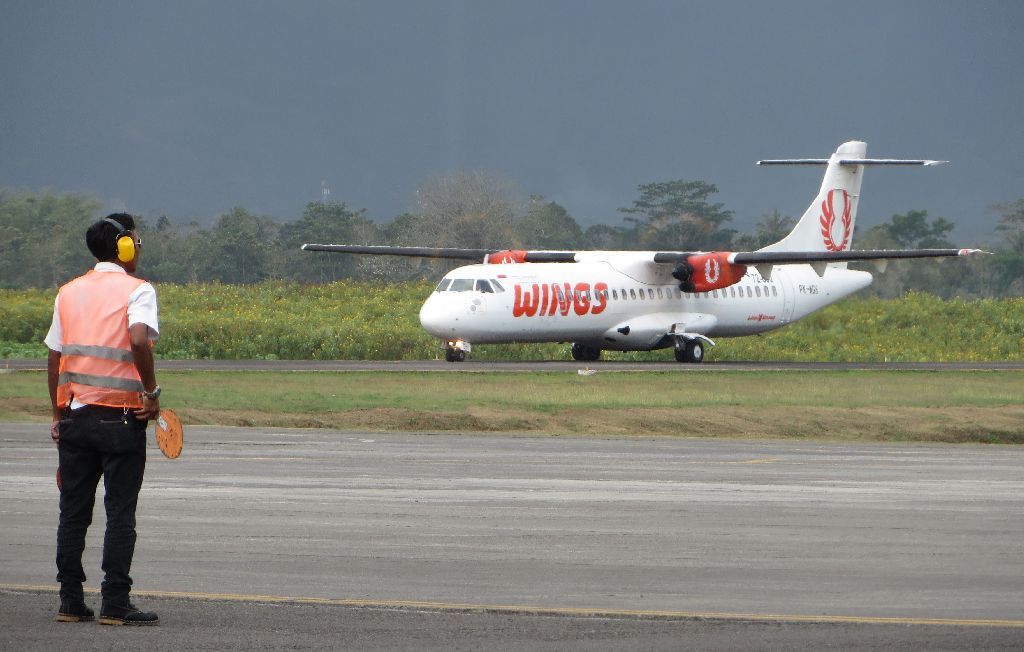
The parking position is already signaled

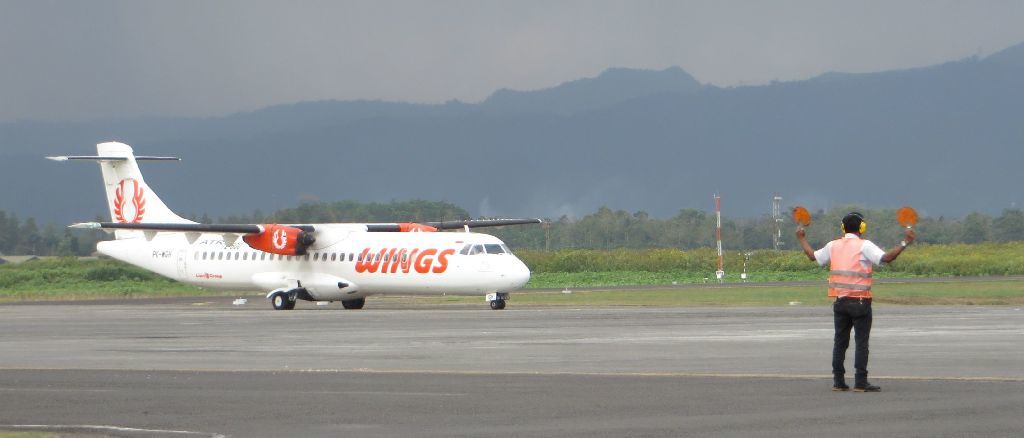
The staff comes up before the right engine has stopped.
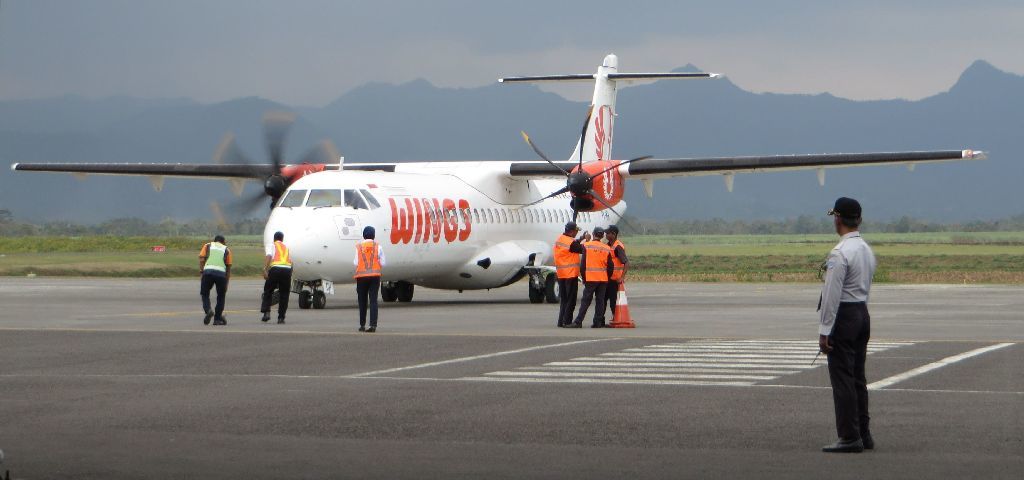
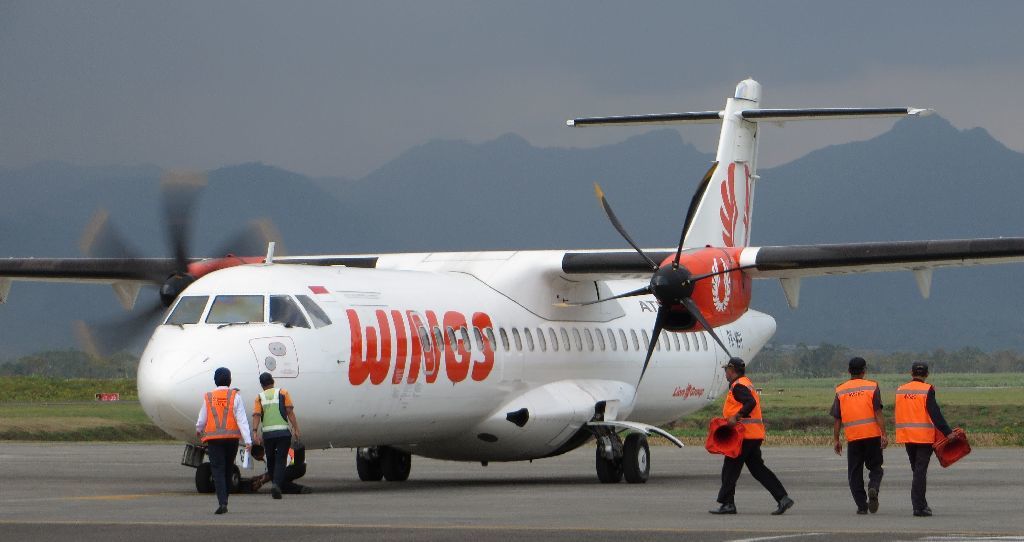
Opening of the luggage hold
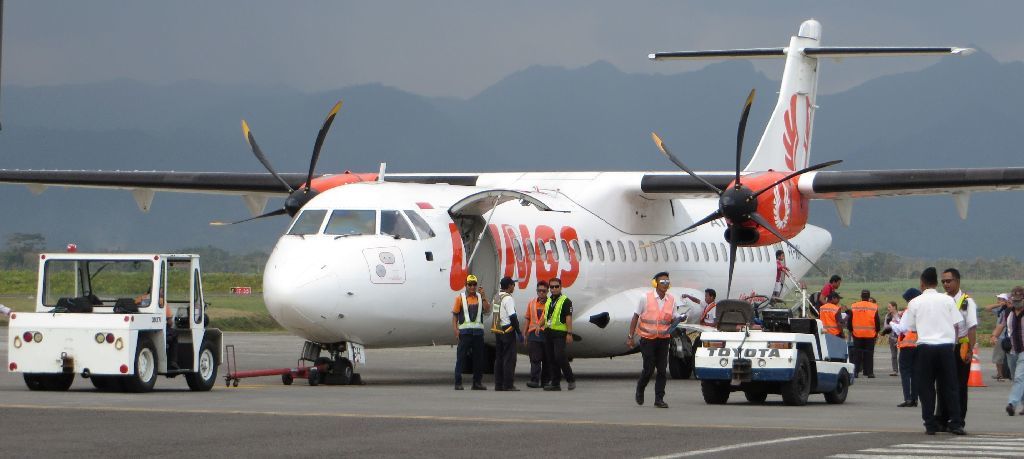
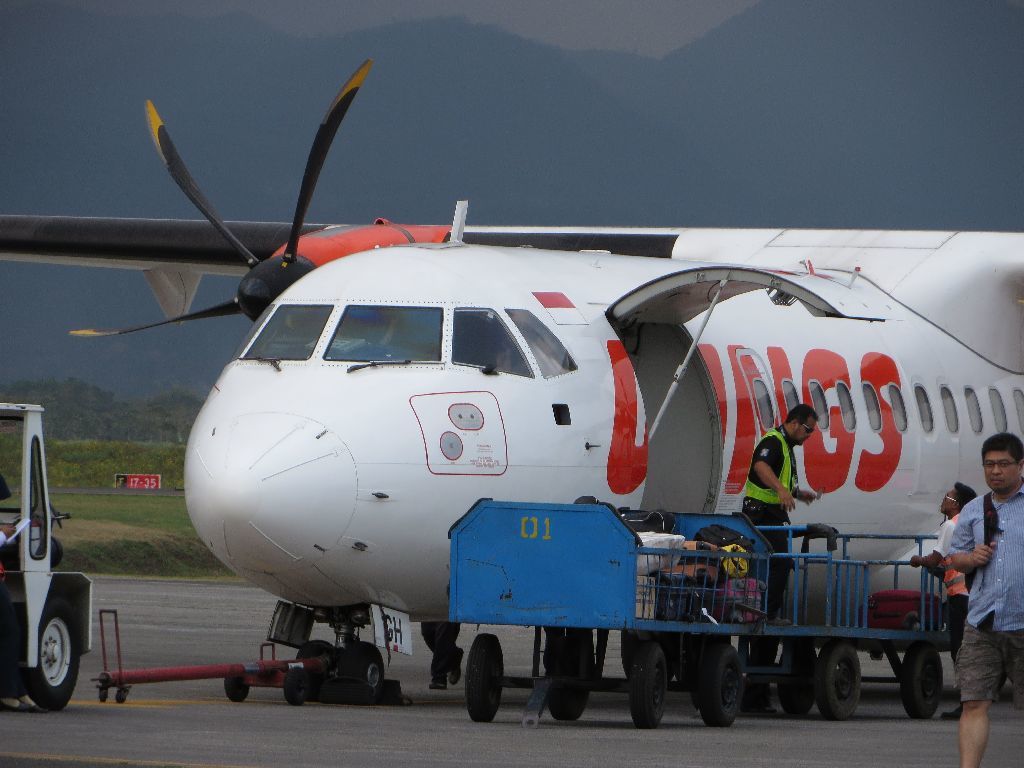
A close up on the right engine
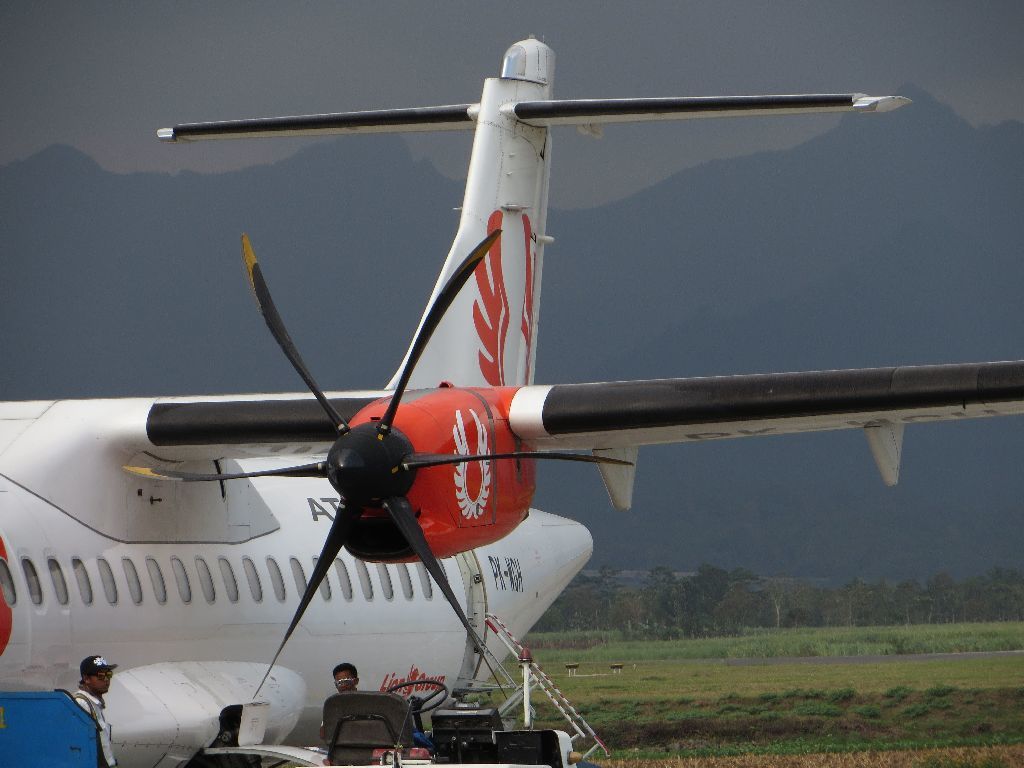
The passengers disembark. Note that the ground staff do not mind the least about taking pictures on the tarmac.
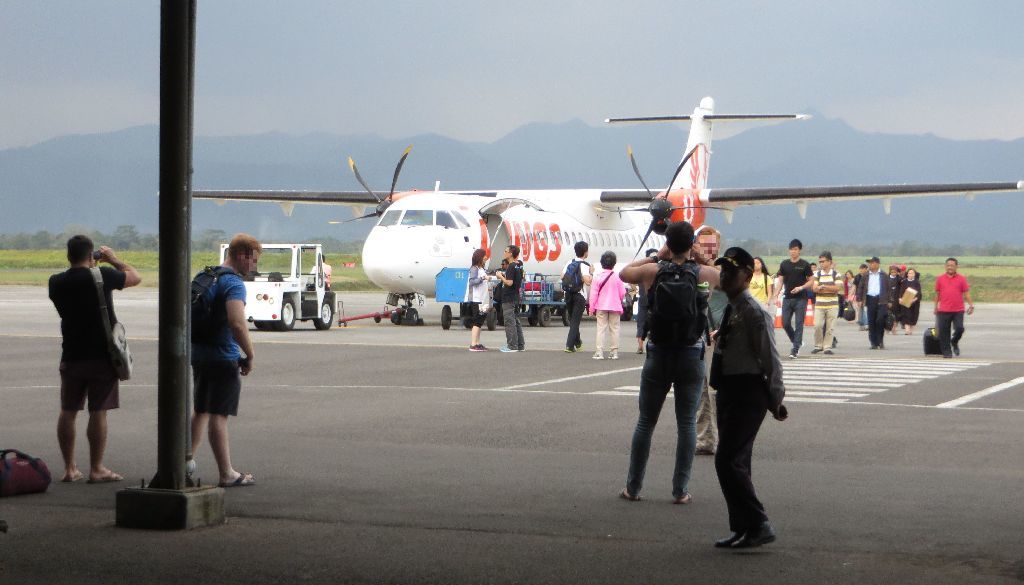
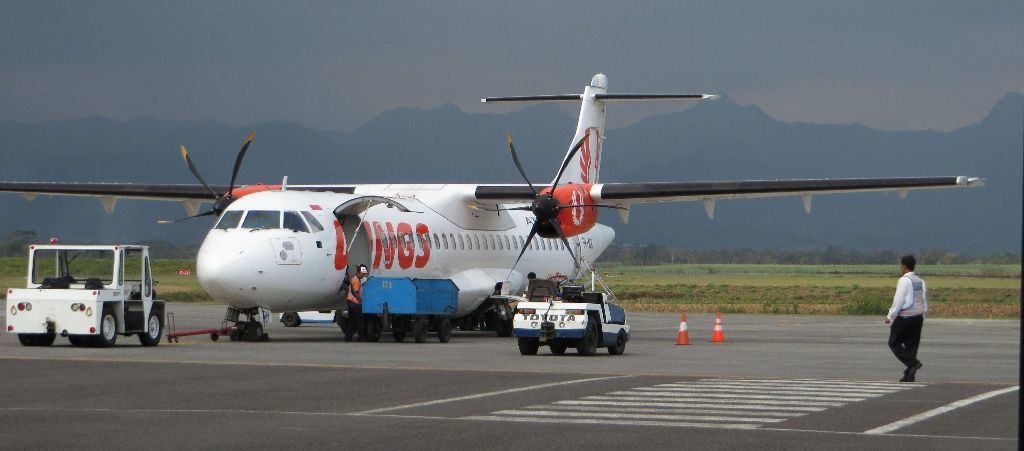
The tank truck comes in to fill her up
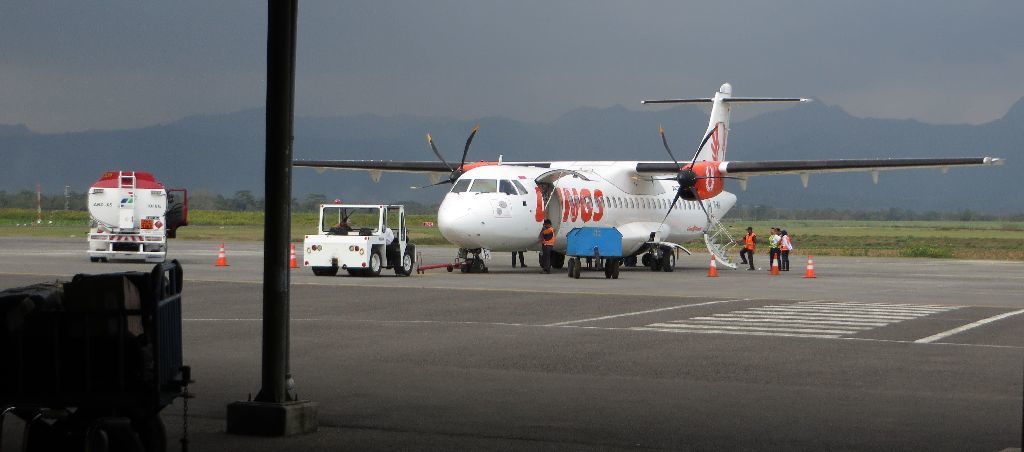
The luggage cart arrives; some wheelchairs are waiting for disabled passengers (there were none on that flight)
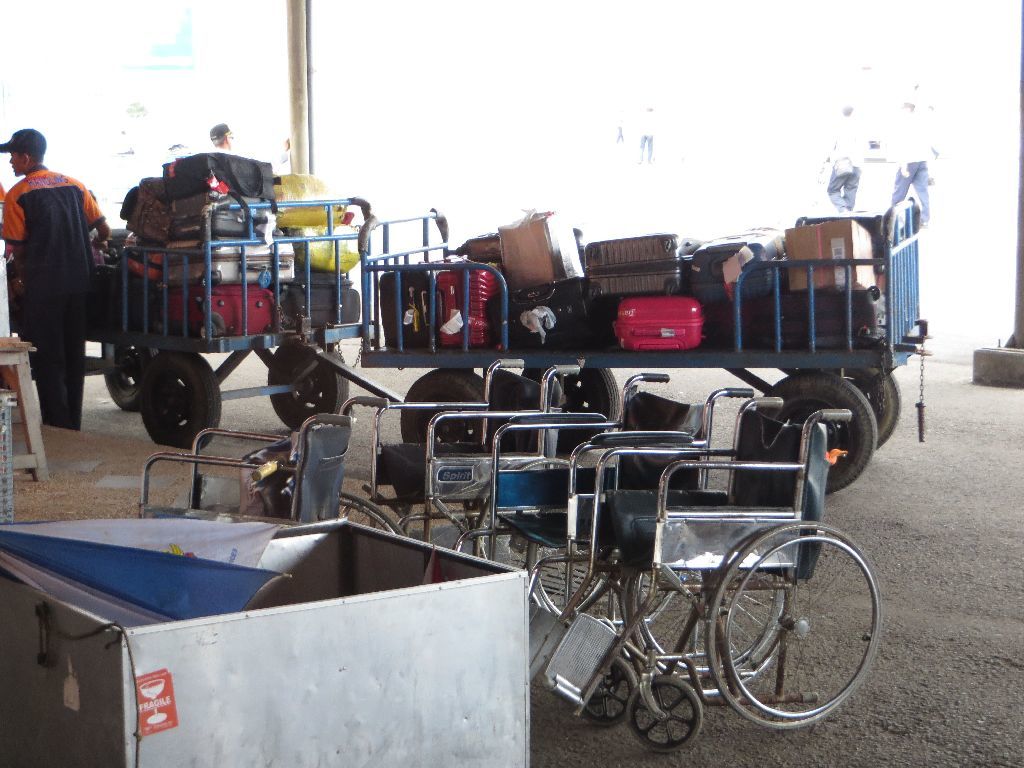
Our tunr to board
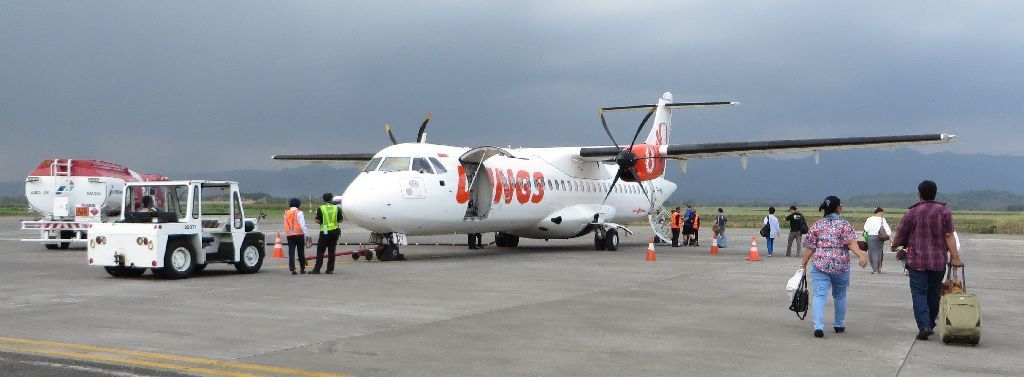
There is no taboo against walking under the wing in that country
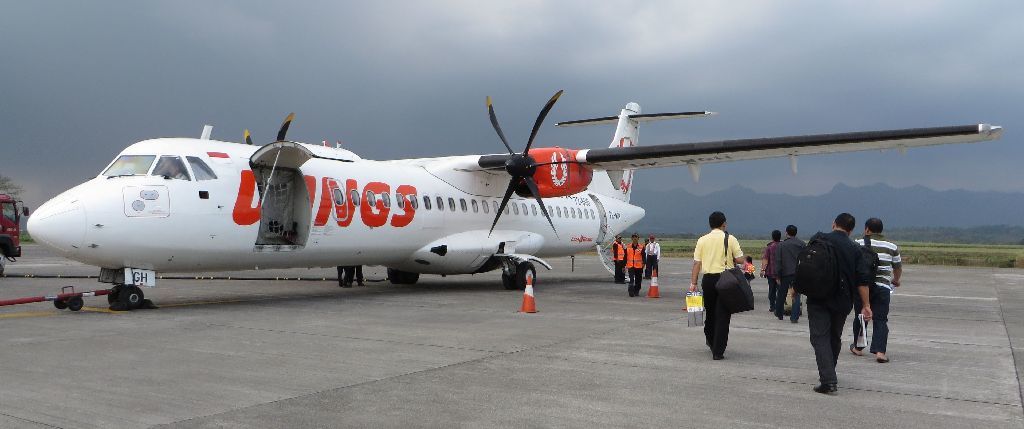
For registration number geeks, the star of the day was PK-WGH
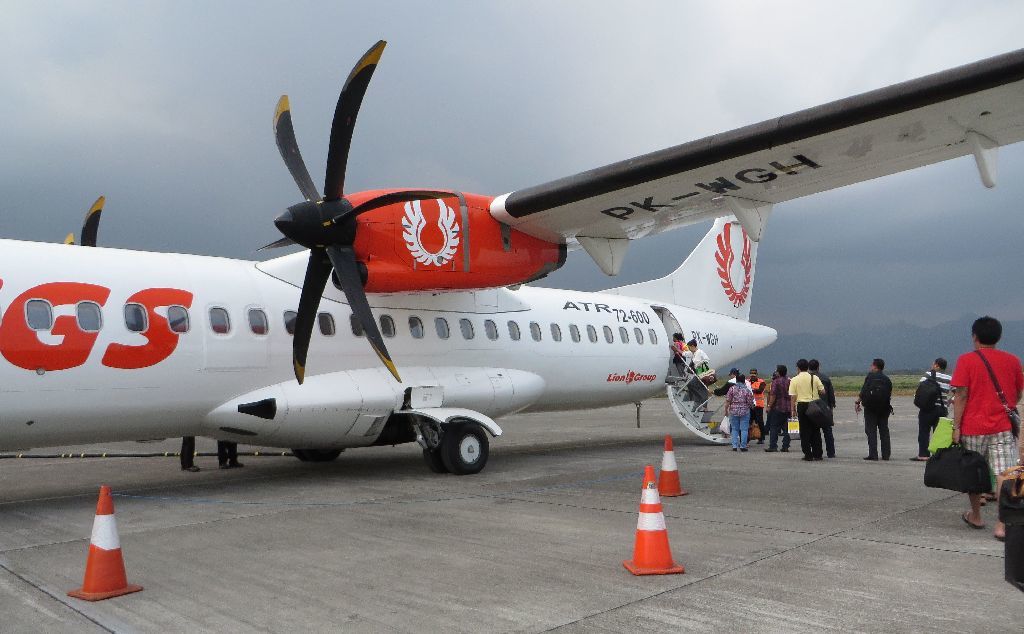
This being an ATR72-600, it cannot be very old.
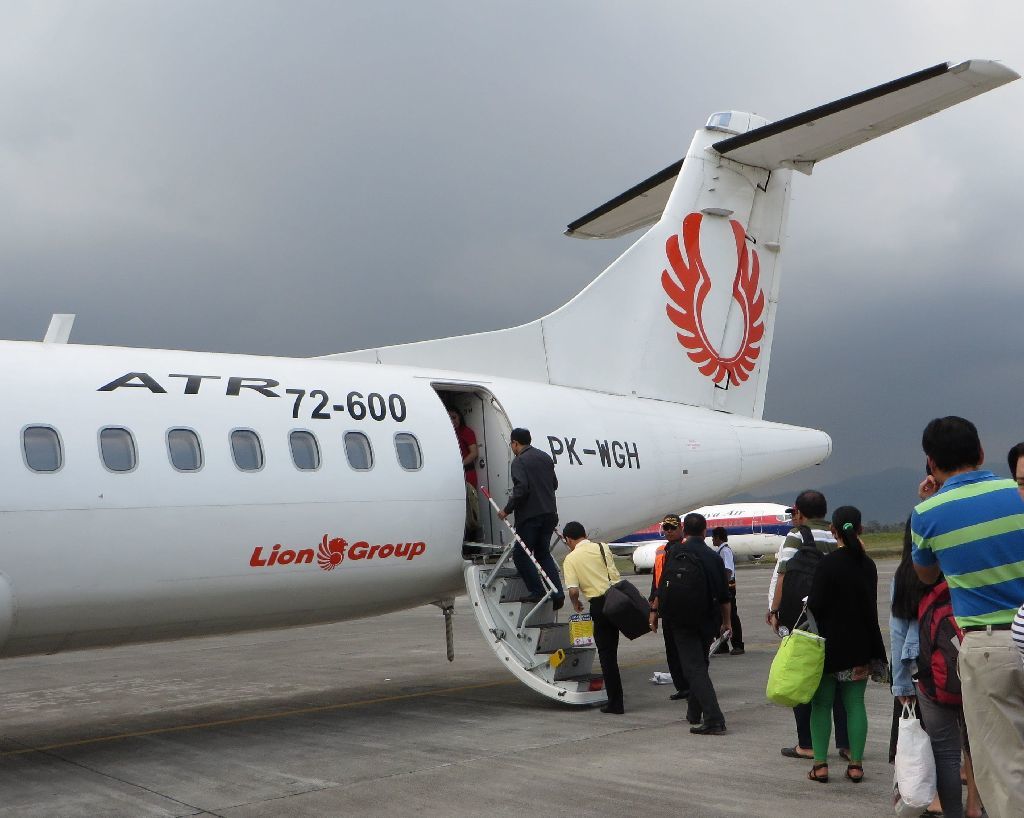
I missed the arrival of a Sriwijaya Air 737
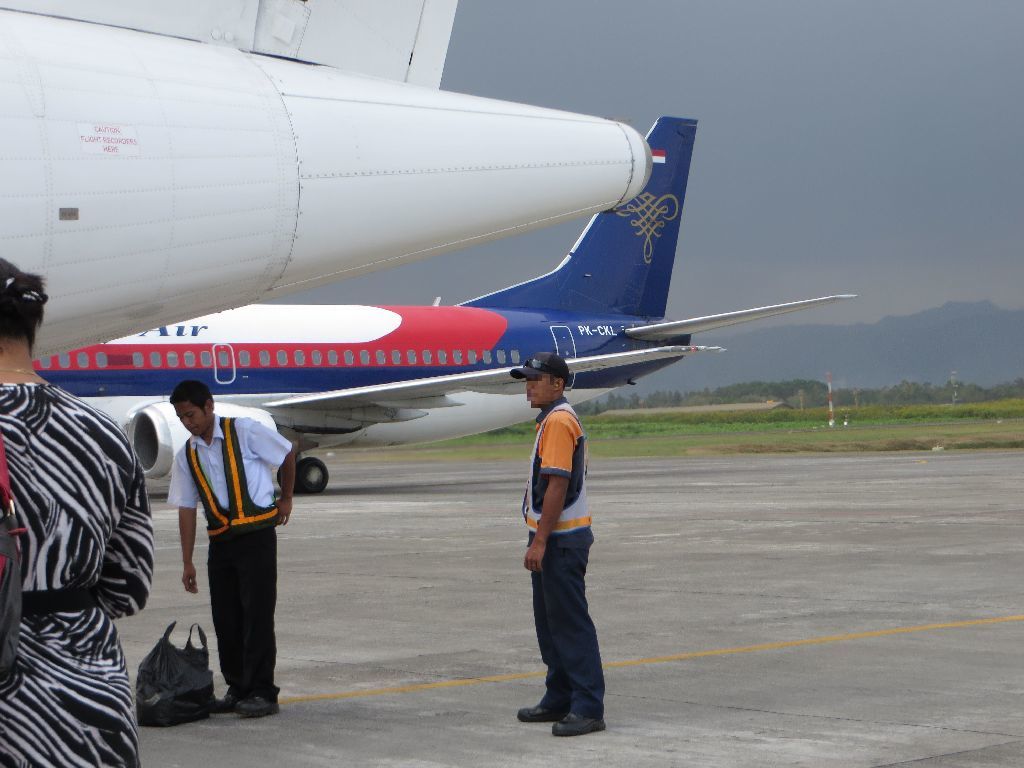
There is she, through a not very clean window of the ATR72
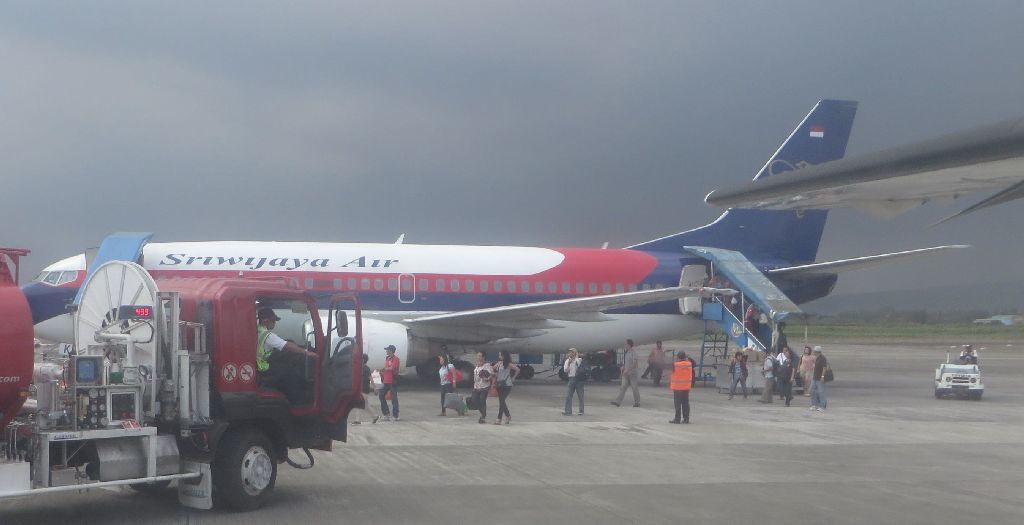
Another reminder of the parent airline
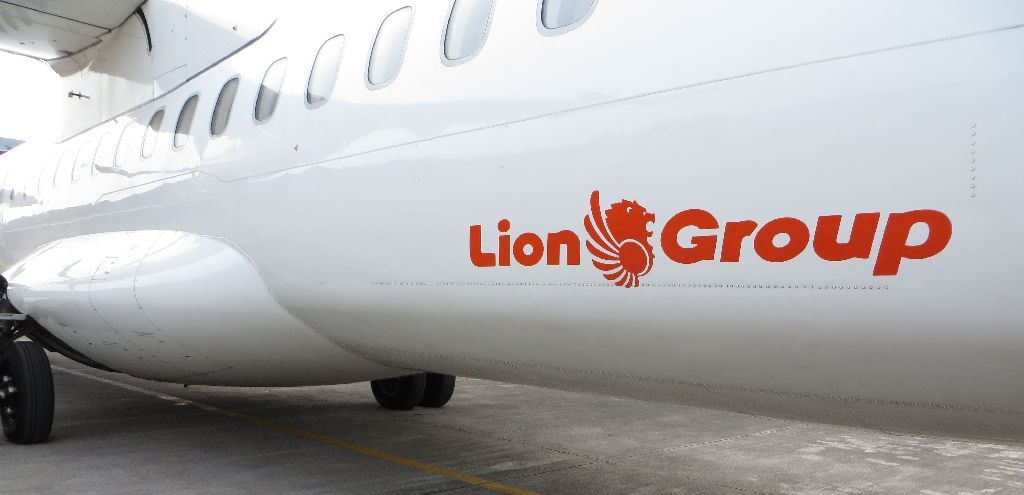
The seats are identical to those of Uni Air's equally new ATR72-600
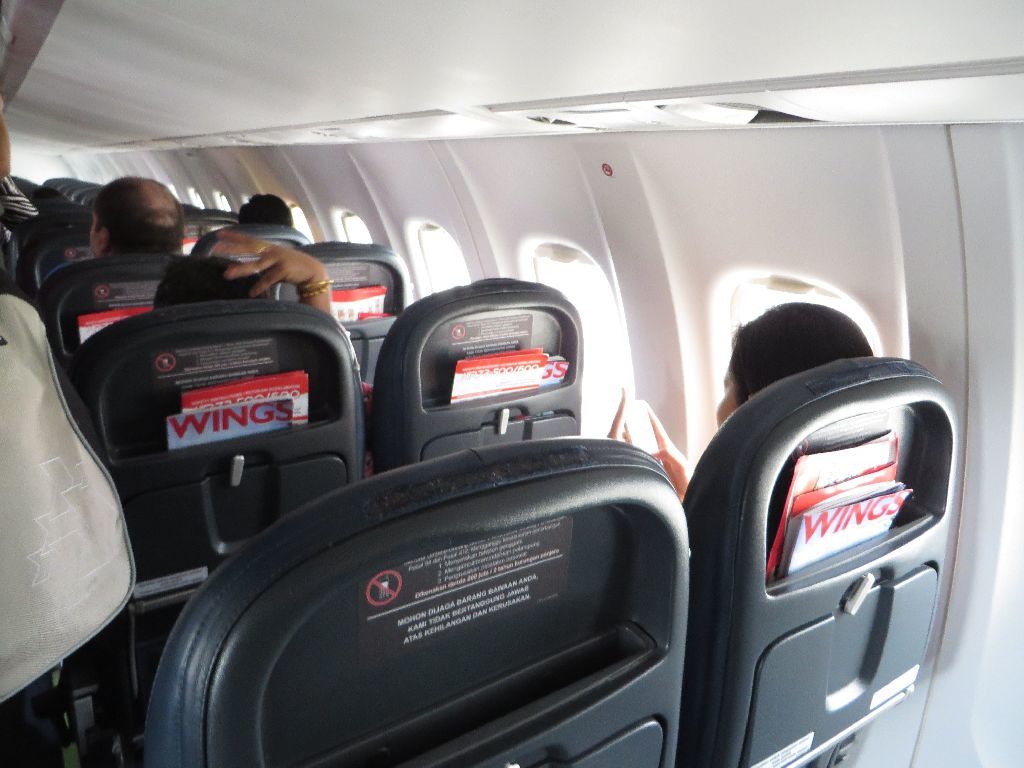
… with a decent seat pitch
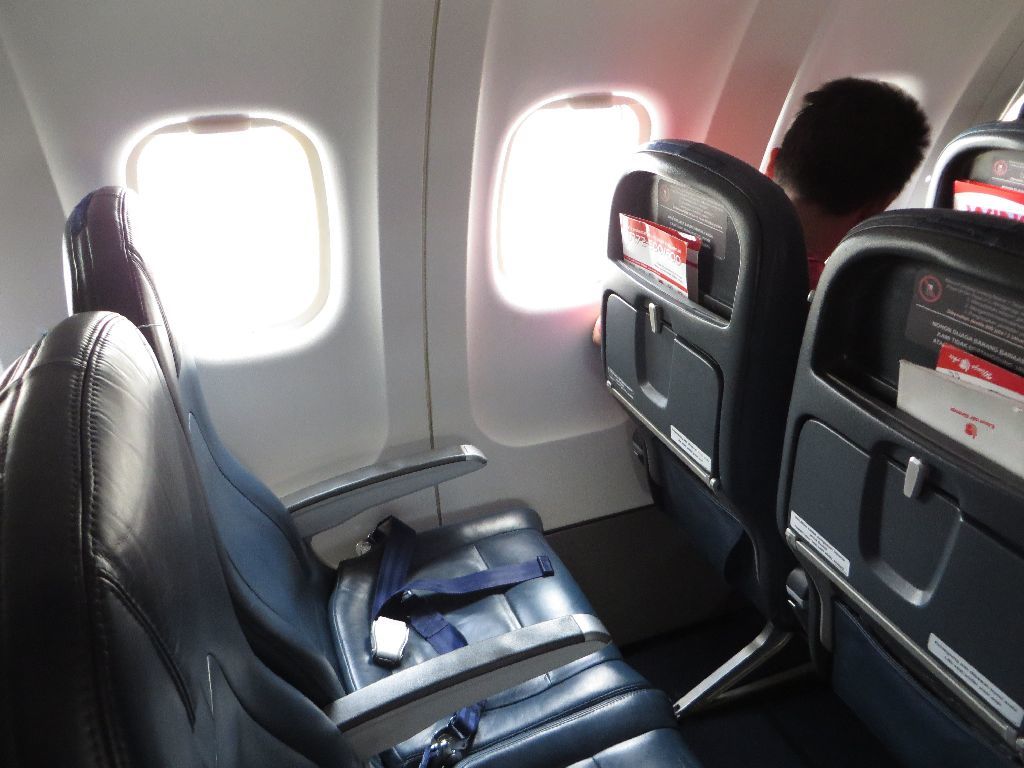

On the other hand, there is a poorly placed seat support which hinders the placing of a hand luggage under the window seat.
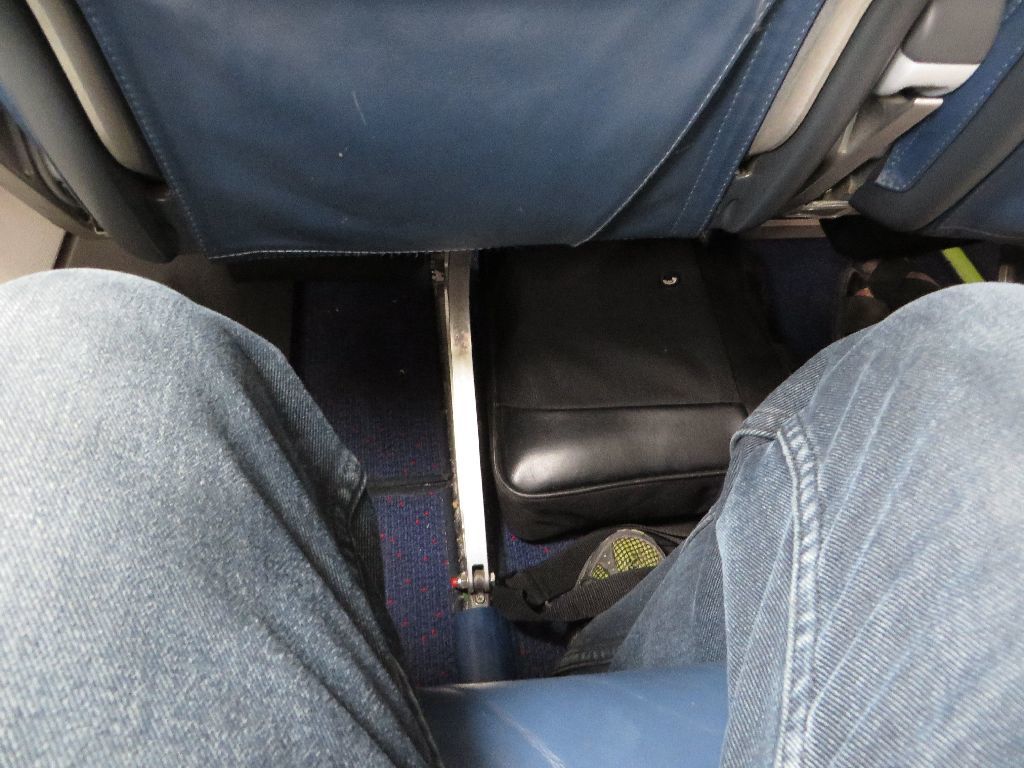
The width between armrests would be uncomfortable on a long haul flight, but is OK for a one hour flight.
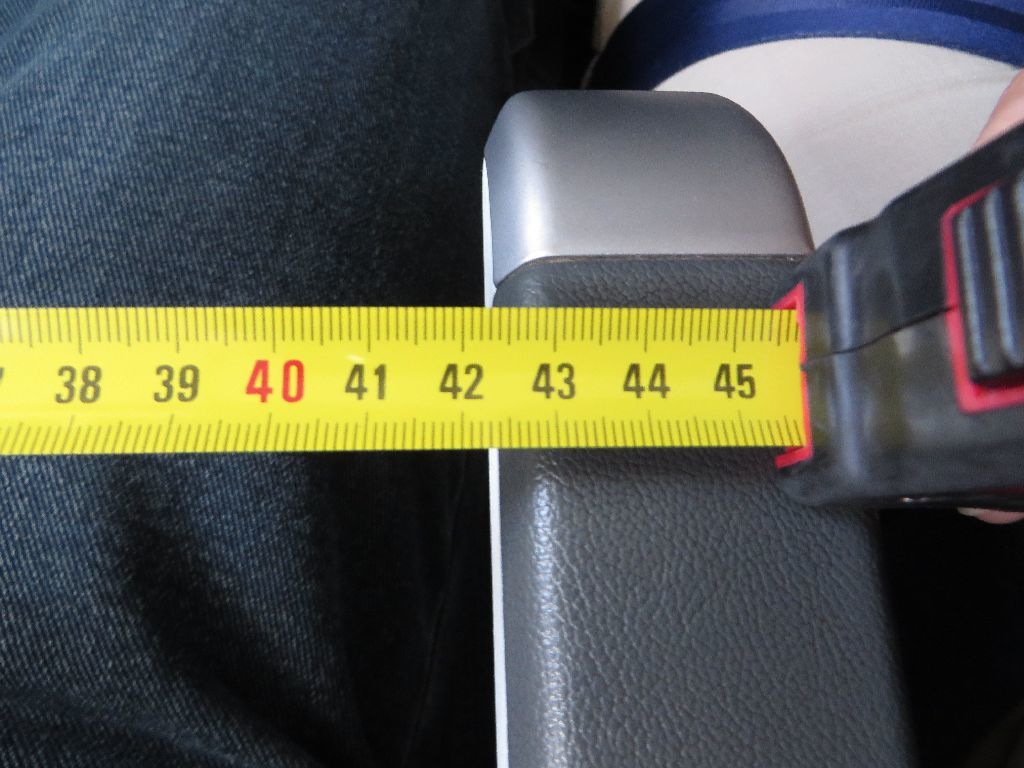
The seat reclines a little, by roughly two seat back's width, with this button at the tip of the armrest.

The seat numbering is unusual: there is no row 13 (bad omen in the West) and no row 14 (the number 4 is bad omen in the Chinese and Japanese civilizations, because 四 [4] is pronounced in both languages like 死 , which means death)
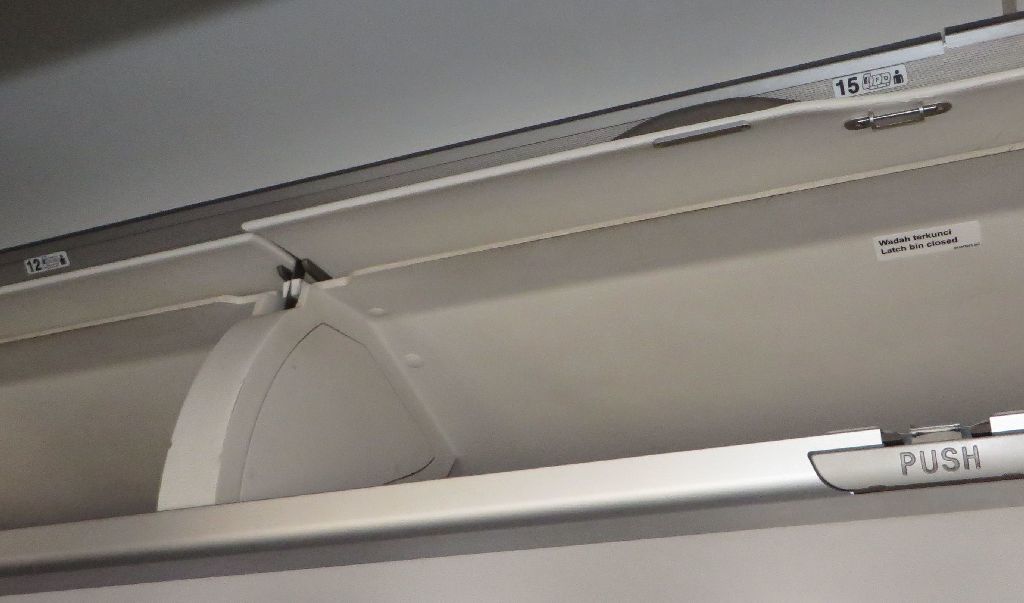
… but there is a row 4! The rationale is beyond by Asian understanding.

Less than two years in commercial operation, and the pocket in the lower part of the seat back already shows its wear, in front of both my seat and that of my wife.
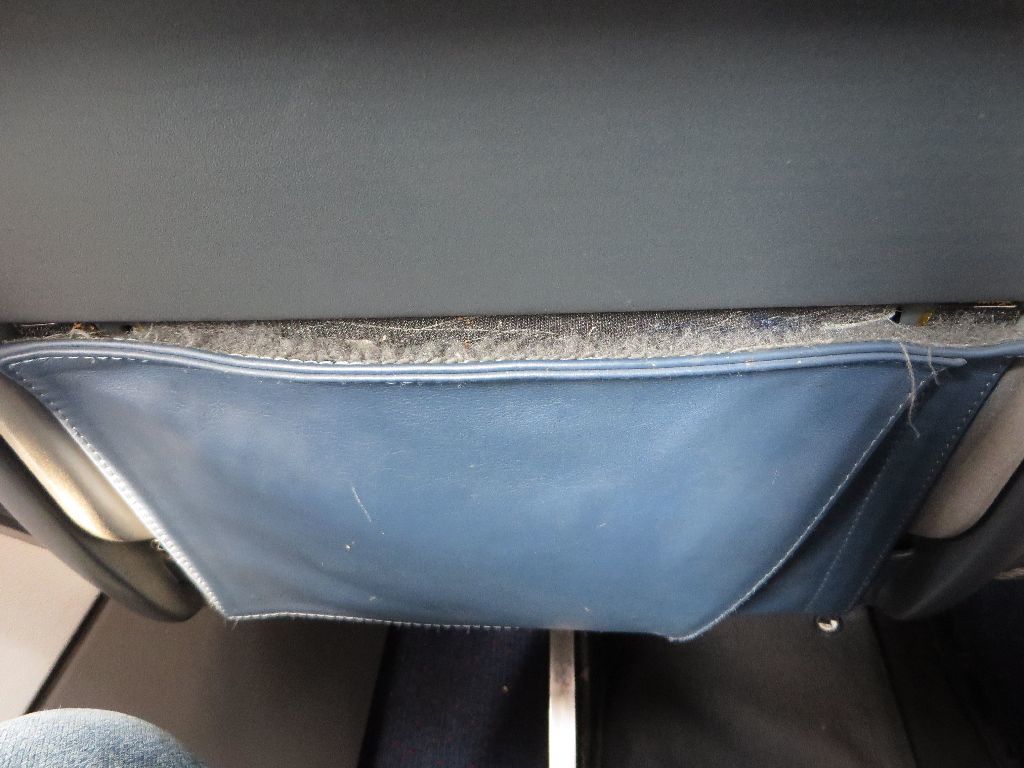
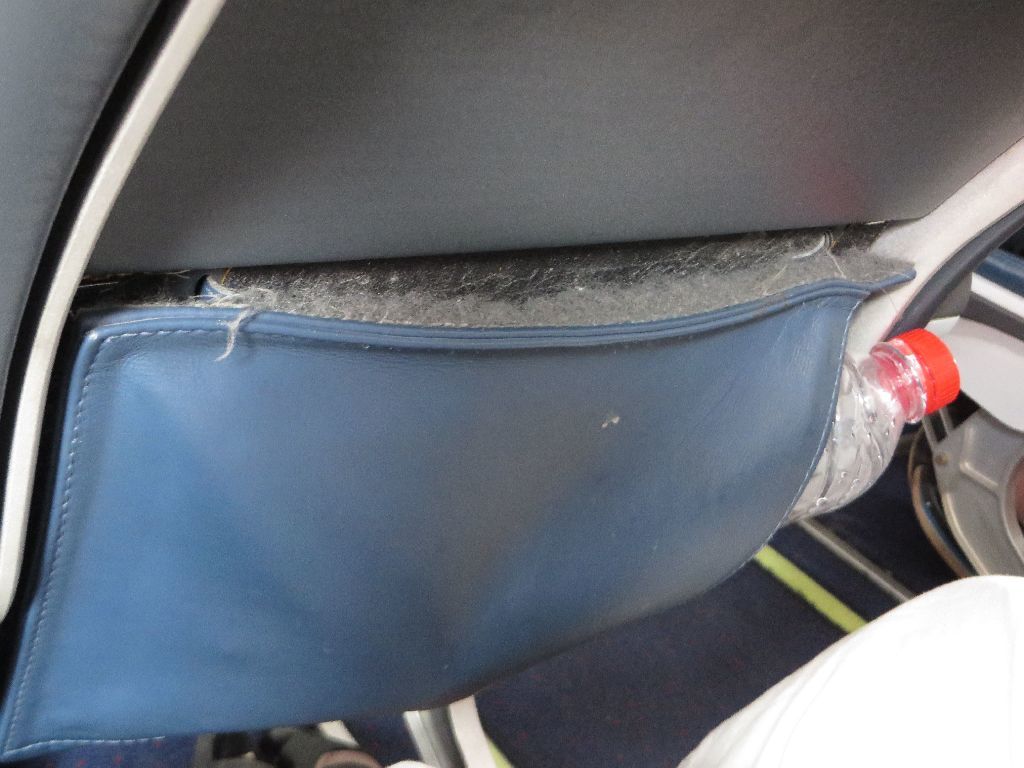
-You don't mean to take a picture of that?
- What do mean, I wouldn't!
- The comfort rating of Wings Air is going to take a beating !
That was the chewing gum neatly disposed of in the folded safety card of my seat, an undetermined number of flights before our own.

Yuck !
The much cleaner safety card of my wife, both sides :
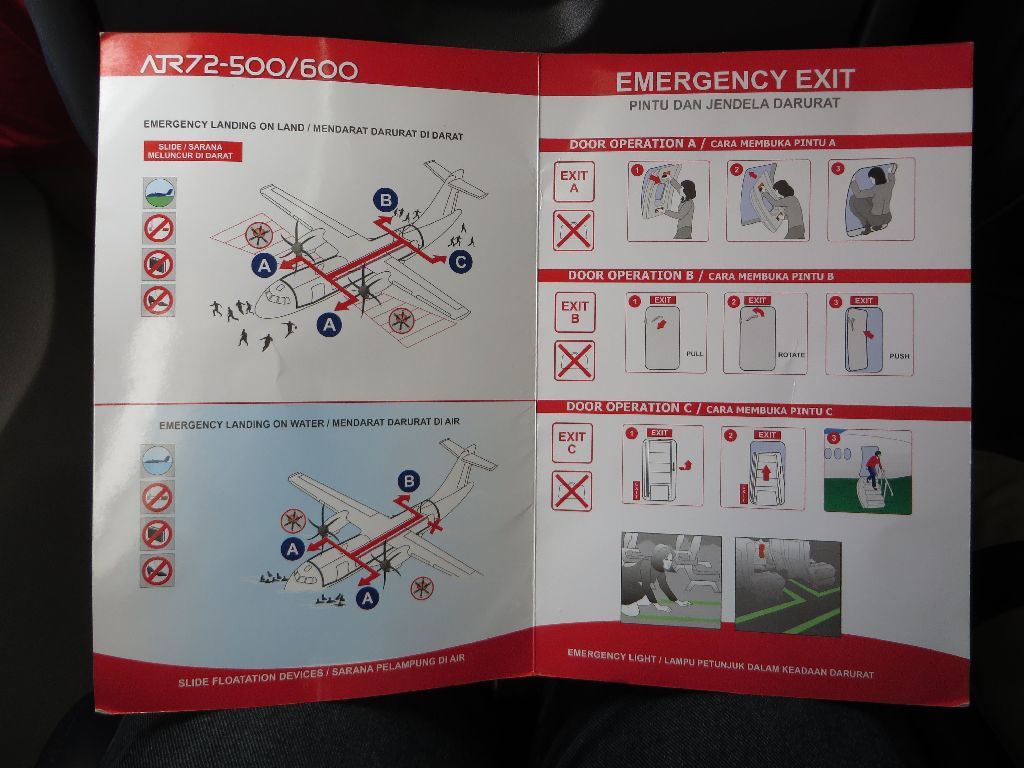
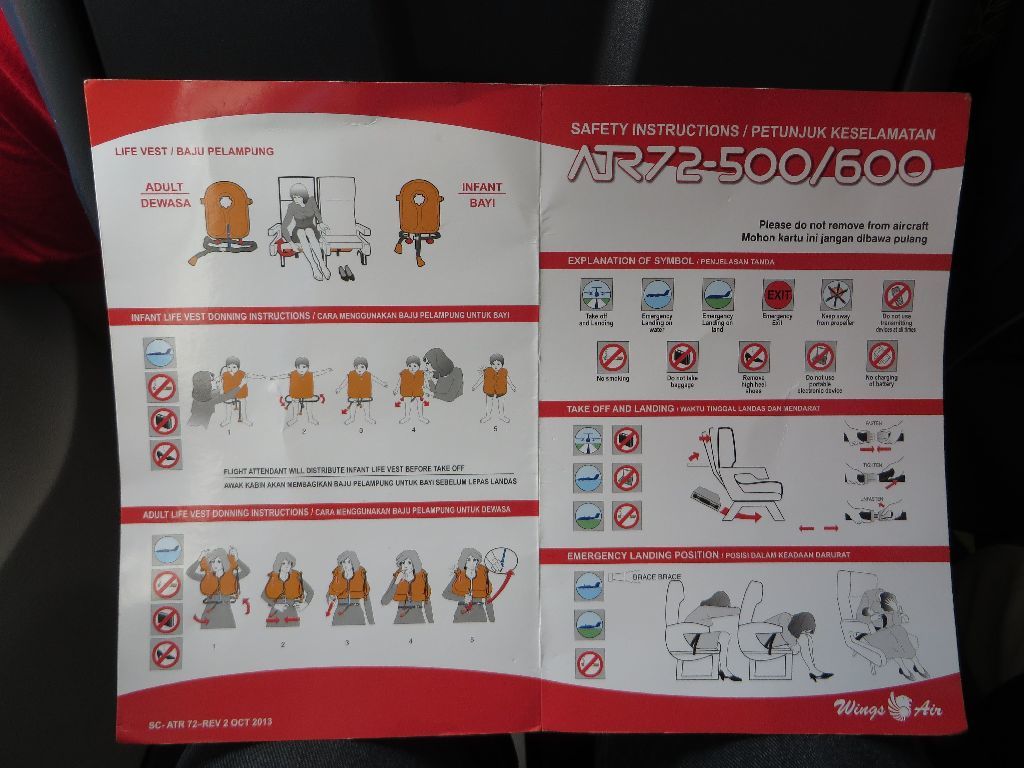
There is also a card with the same prayers as with GA and SJ


And a slightly crumpled (but clean) vomit bag, lower right
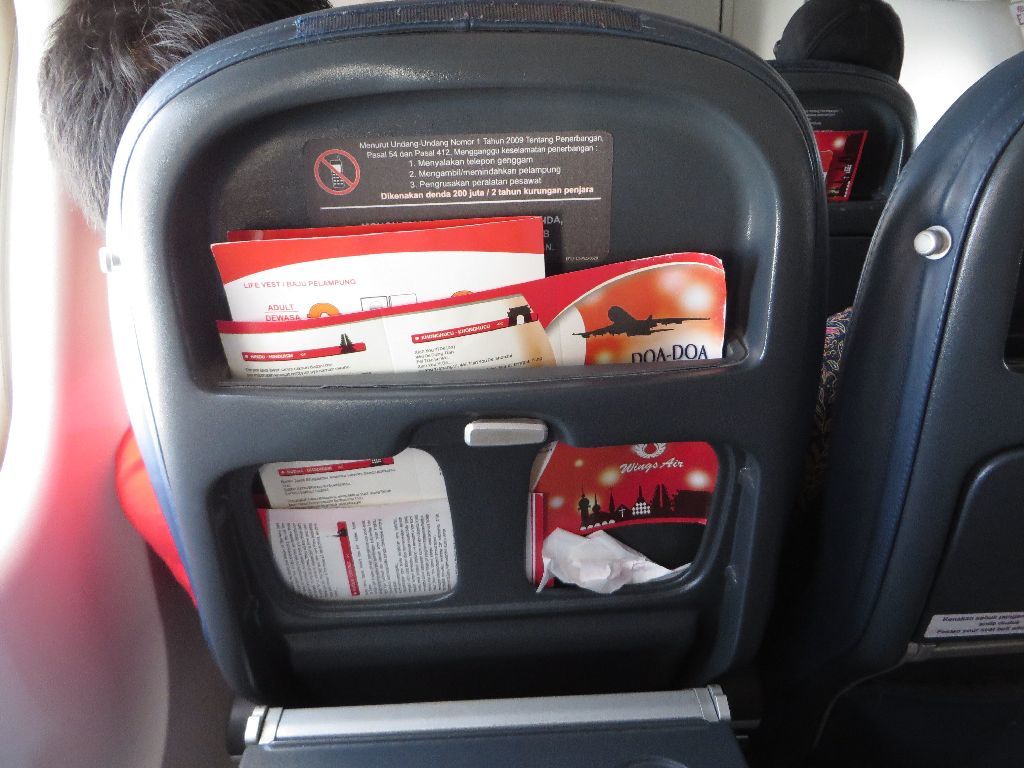
Wings Air's network illustrates its strategy of providing short hops between the numerous Indonesian islands.
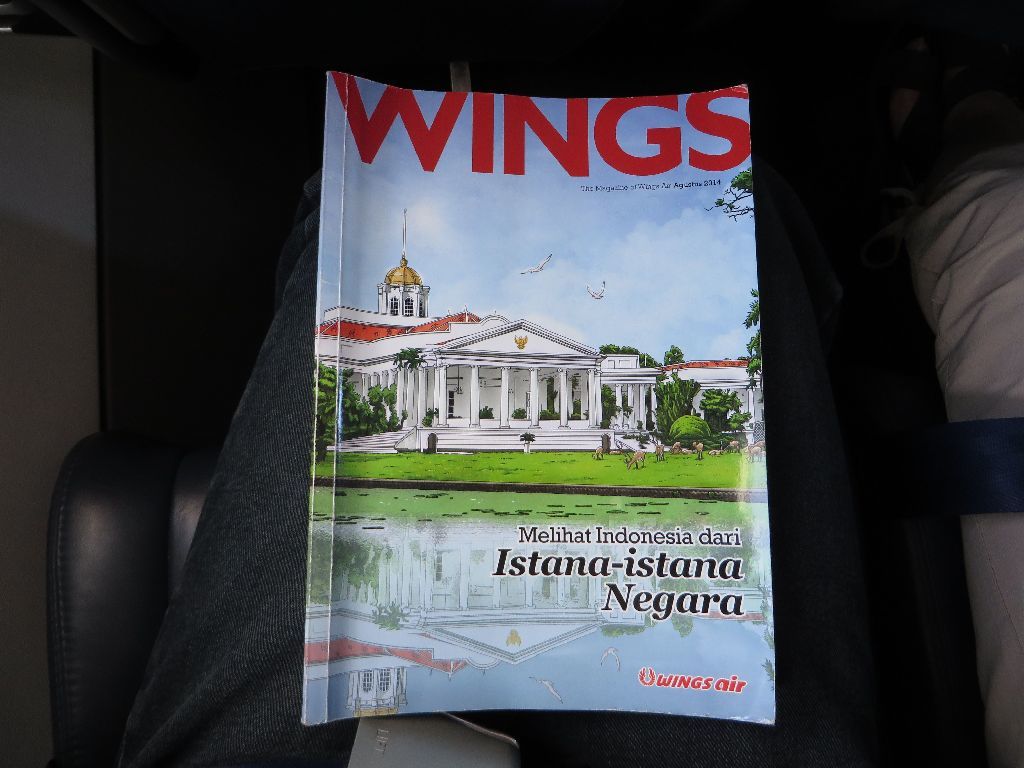
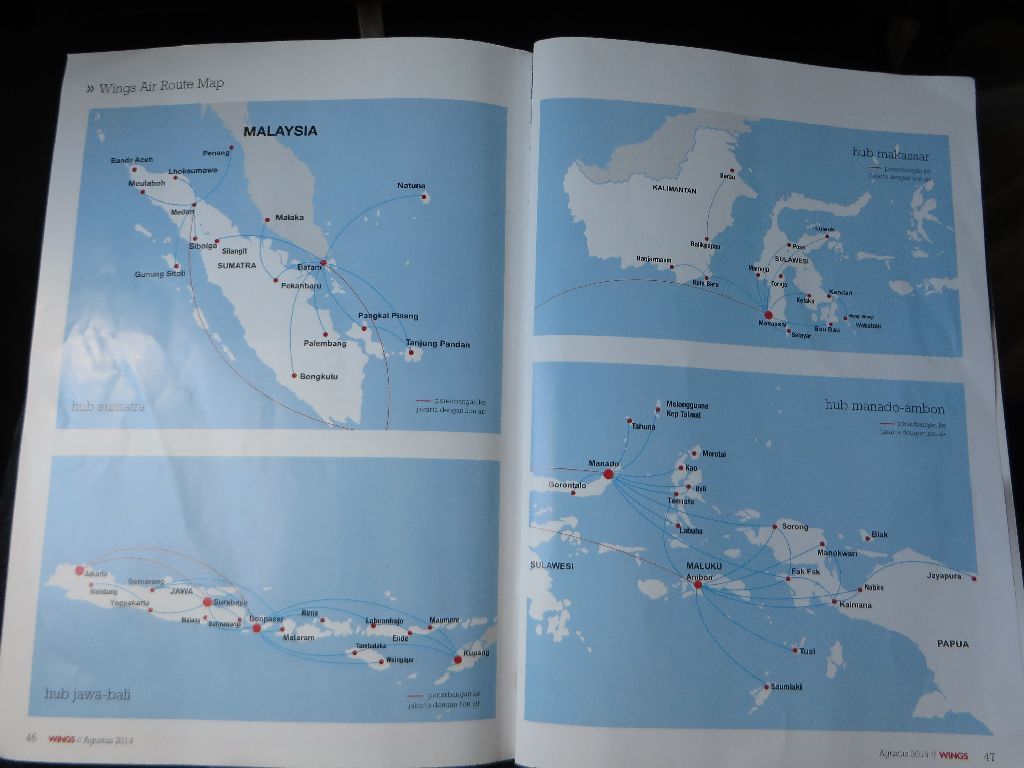
The No electronic equipment light betrays the young age of the aircraft
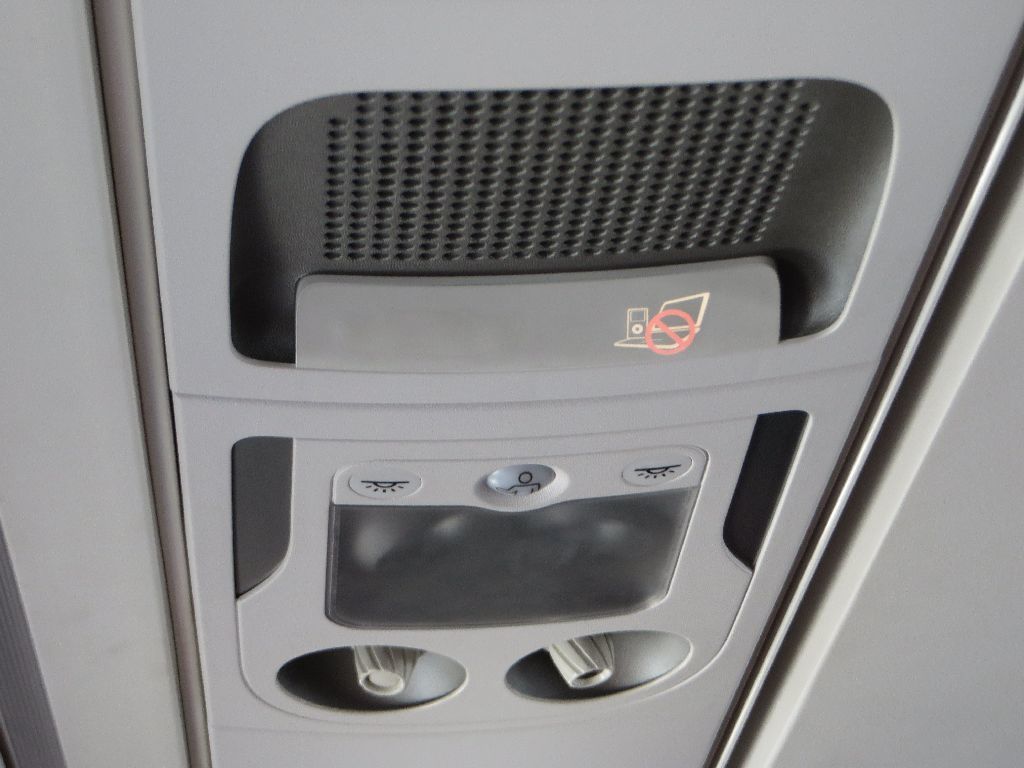
A FA delivers the standard information to passengers seated at the front emergency exits.
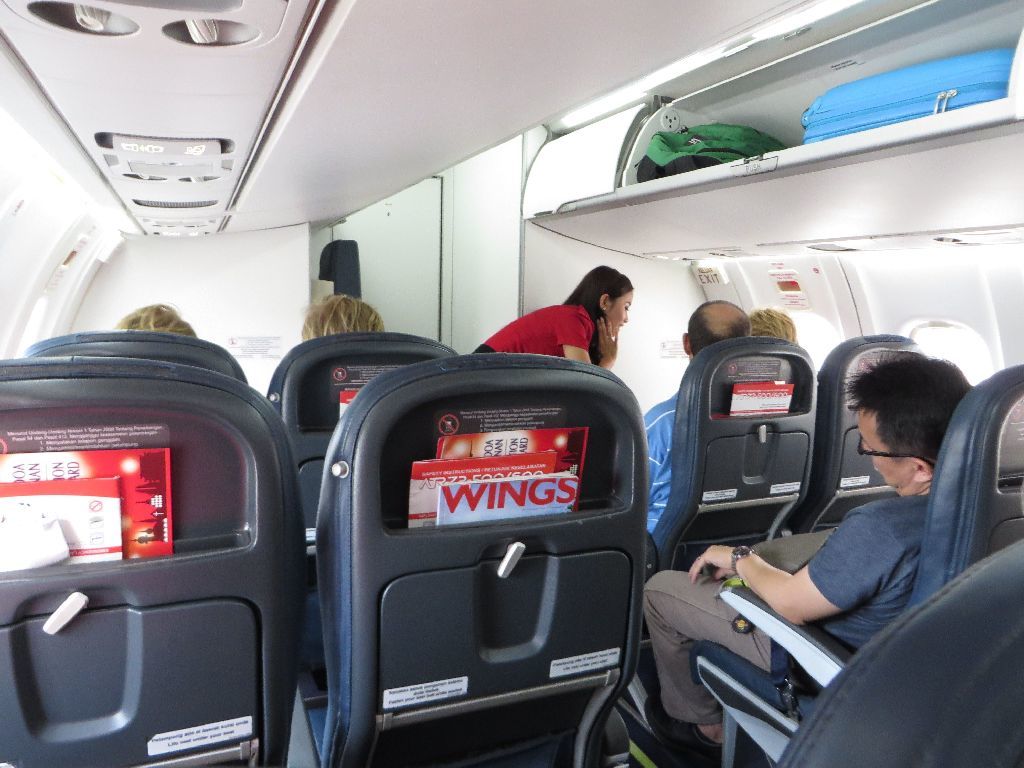
Keluar means Exit in Indonesian
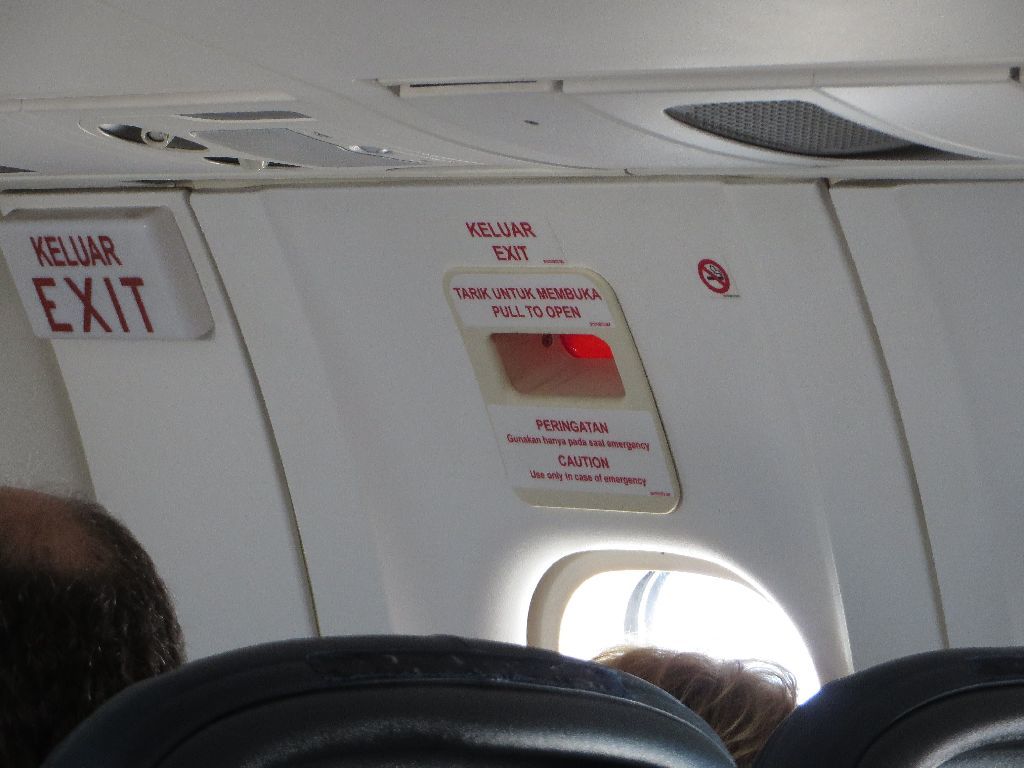
The Wings Air flight attendants…. Their uniform is as skin tight as that of SQ, they have more of what they should have where they should have, and their looks are the best guarantee that all male passengers watch the safety demonstration carefully.
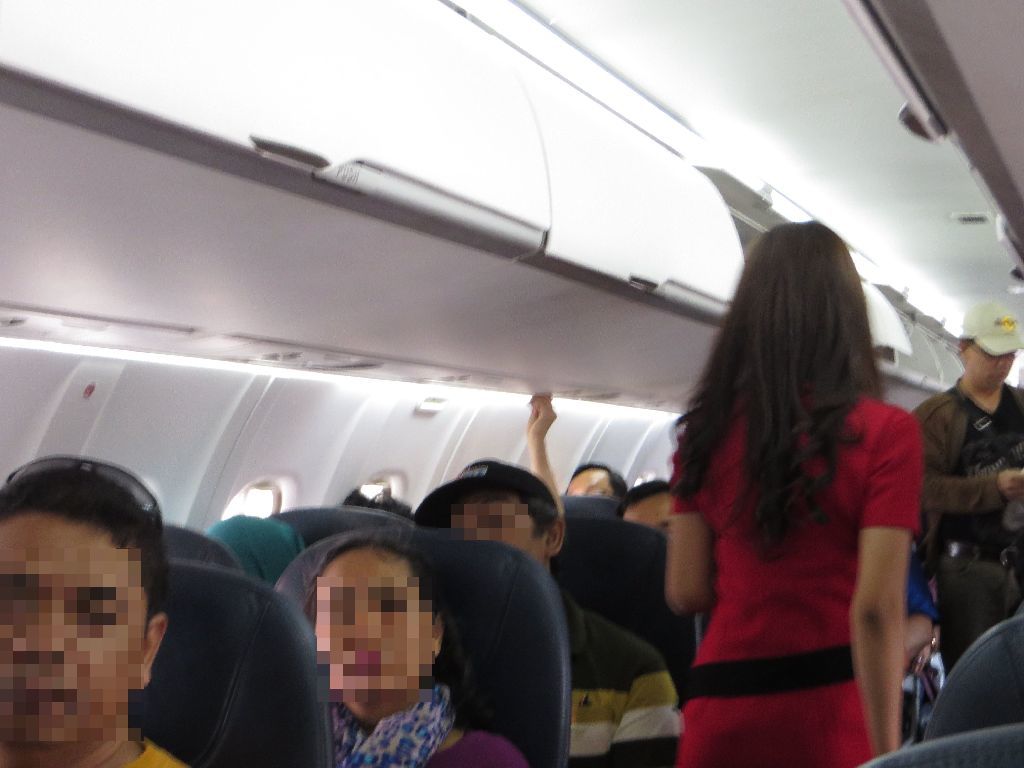
Better admire their looks then, because there is neither catering nor BOB, and this table will remain empty. In other words, they disappear until the cabin check before landing.
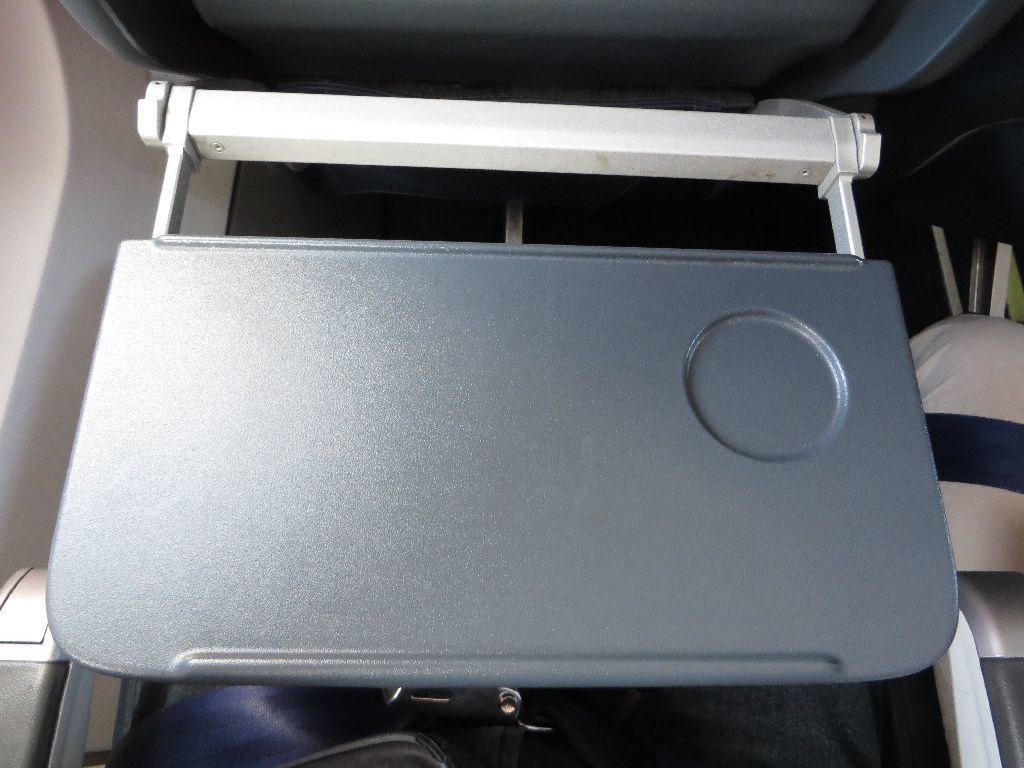
Row 5 in an ATR72 is for turboprop addicts, with an ideal view on the engine, close enough to have the mellow sound of a real aircraft engine (not some propeller-less ersatz), and a good view towards the front on the external IFE, a.k.a landscape.

Fewer than 25 minutes elapsed between the arrival in and departure from MLG: that is low cost airline efficiency. A last look at the SJ 737.
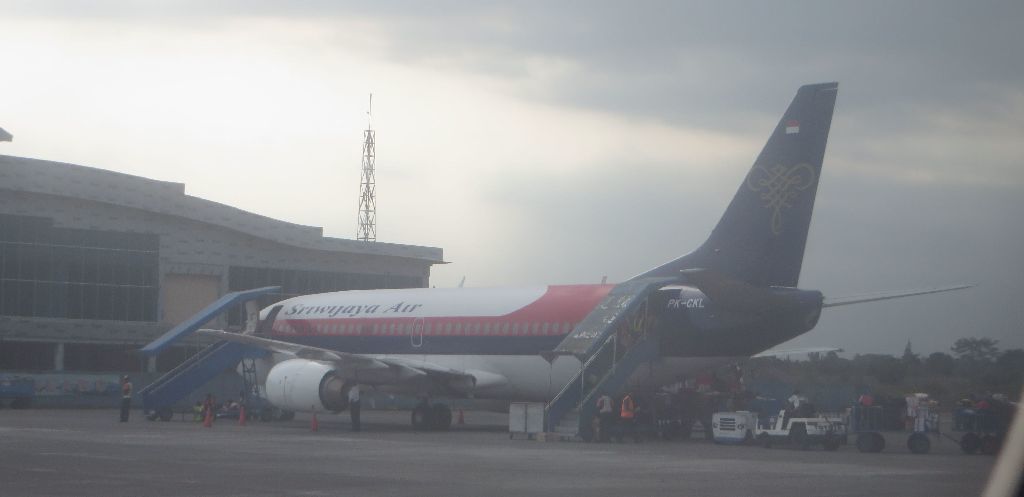
And take-off, with a brief view of an airbase with four military transport aircraft on the tarmac.

The weather is overcast, and nothing much can be expected of the view out on Java island of the window
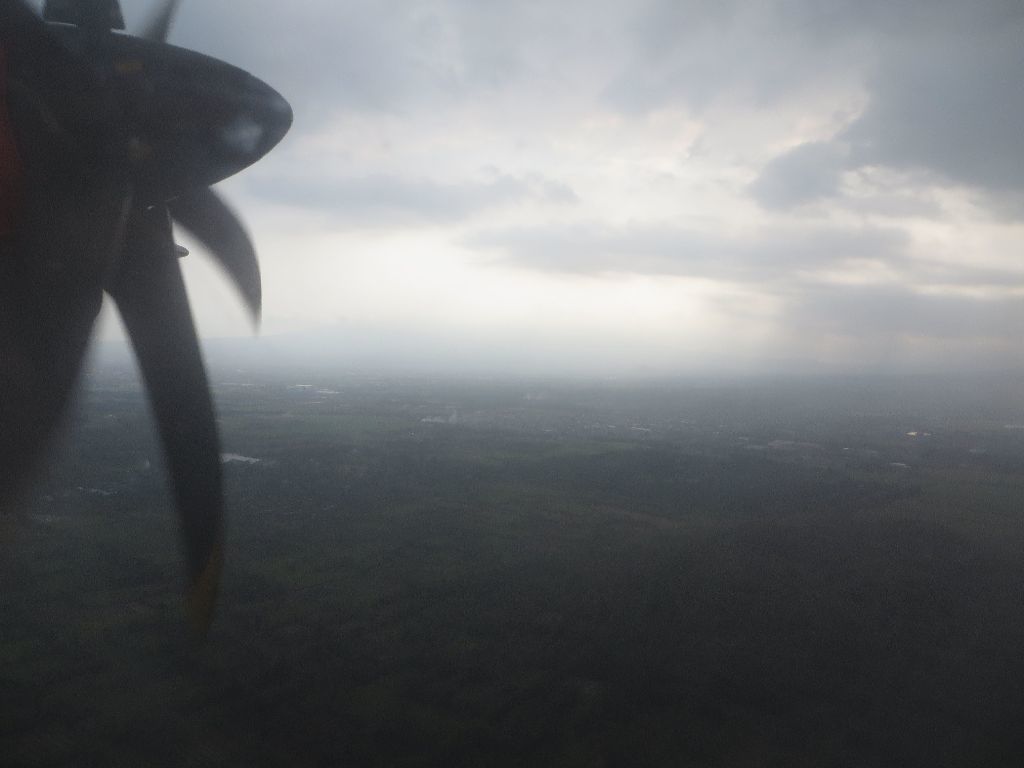
The sky becomes blue behind the turboprop as the plane gains altitude

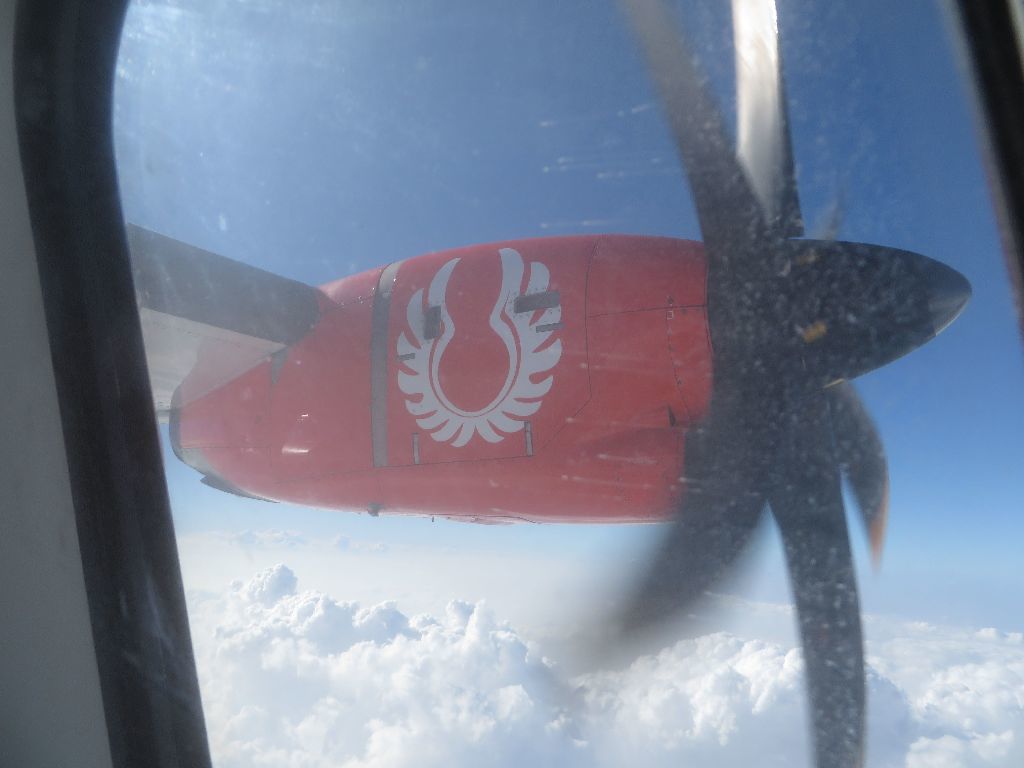
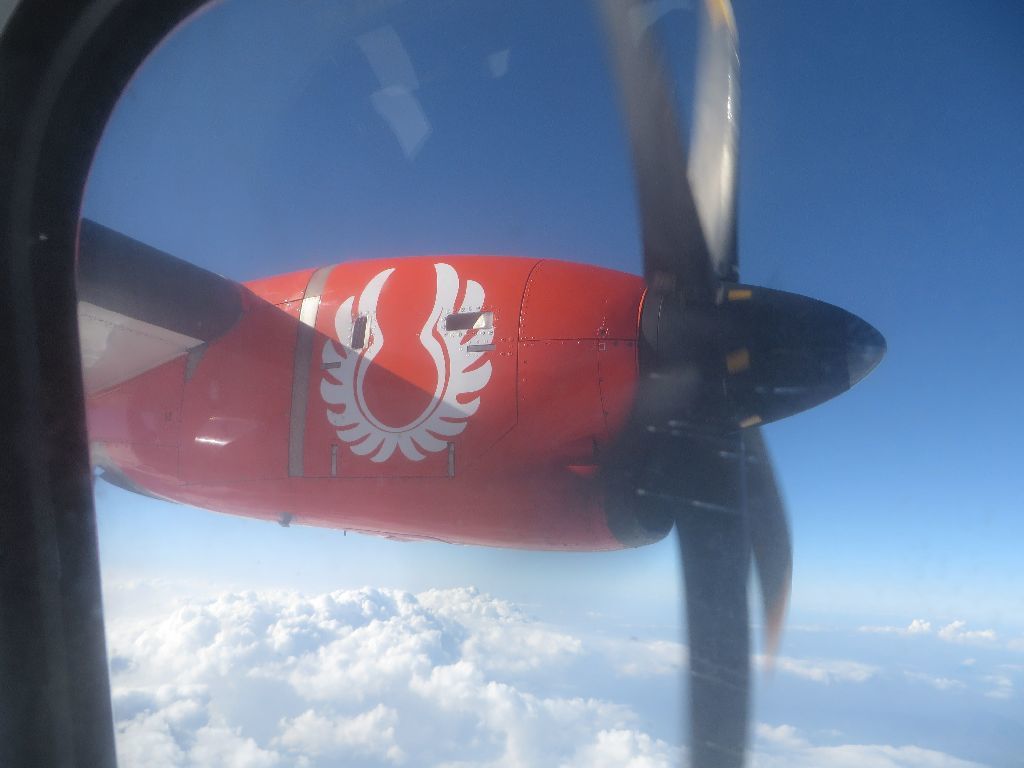
Some Javanese volcanoes

With some image processing and a lot of goodwill, you can see here the western tip of Bali island, which is very close to Java. The Balinese are strongly opposed to any bridge project linking both islands.
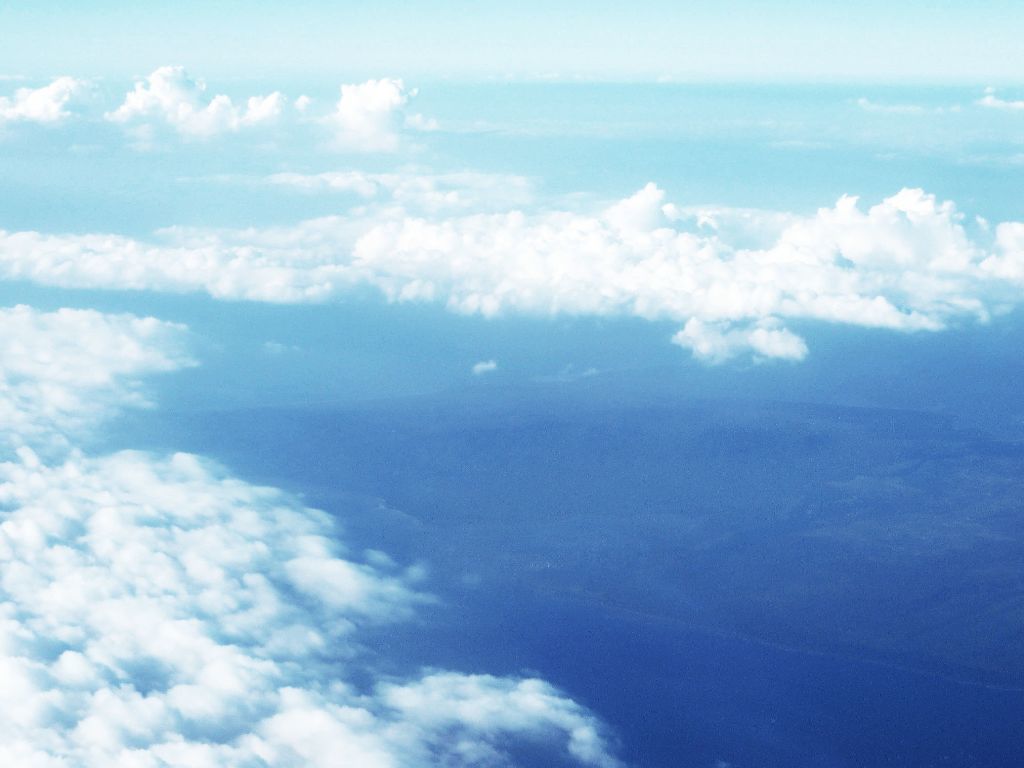
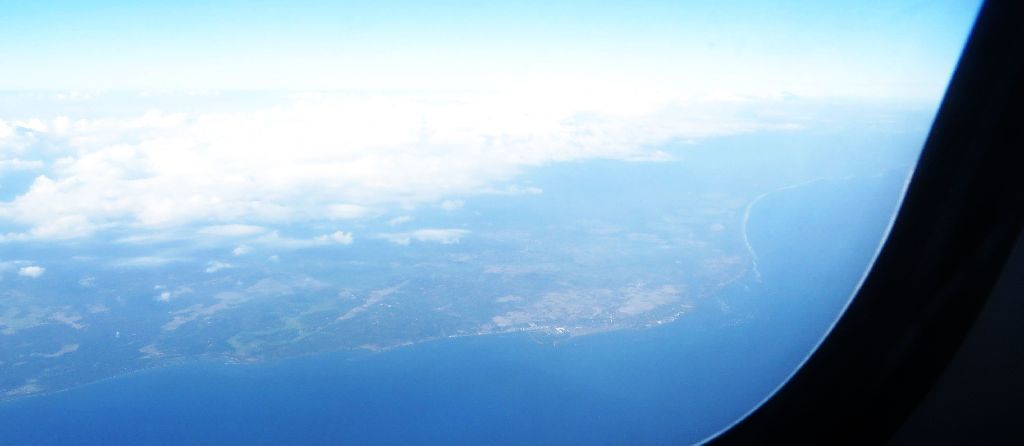
The southwest coast of Bali, very undeveloped, and patronized mostly by surfers.

The runway in DPS has been extended into the sea, which give the impression that we are going to ditch.
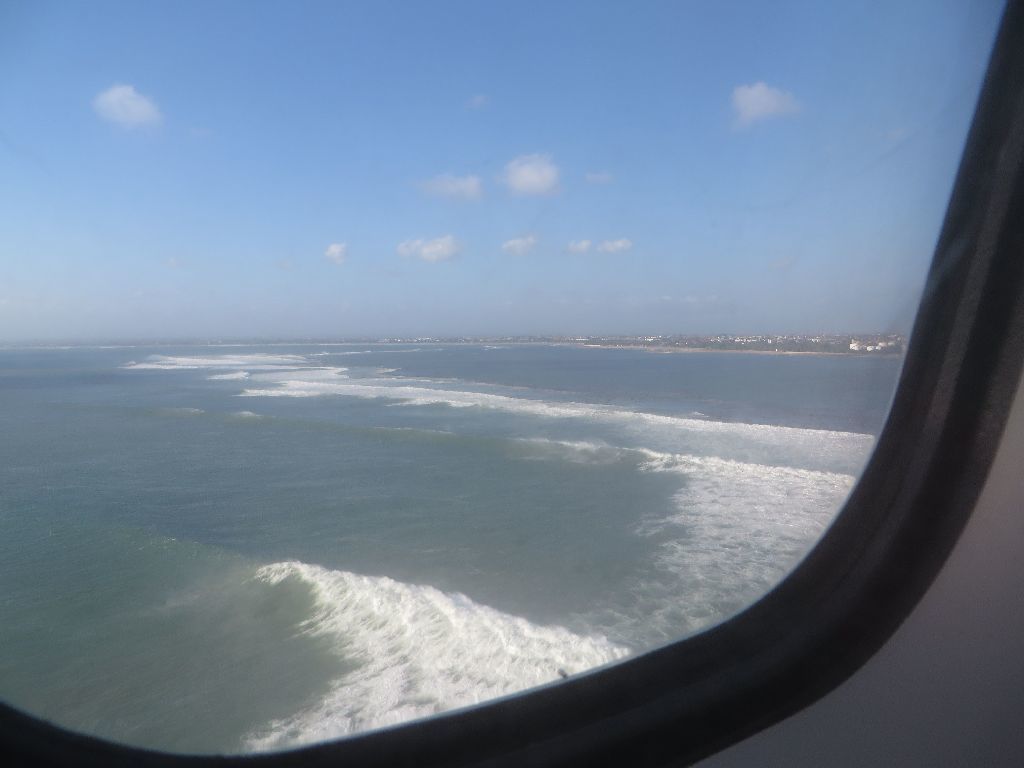
… but we can see the runway in the right hand side of the window
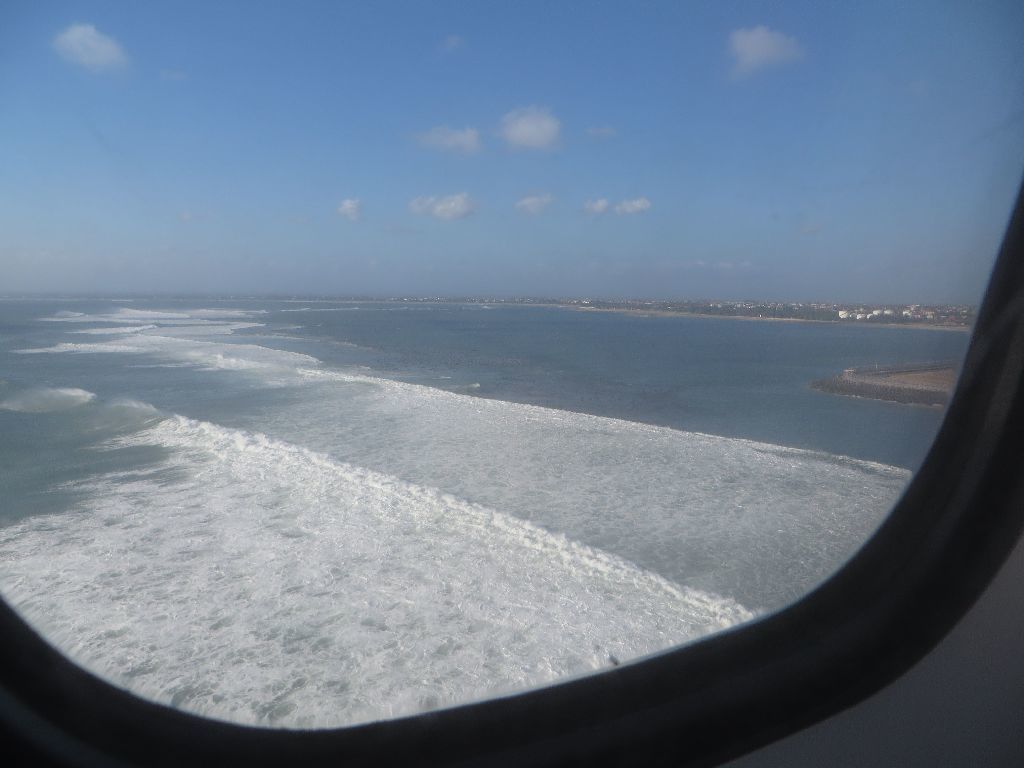
Another Wings Air ATR72 is waiting for takeoff
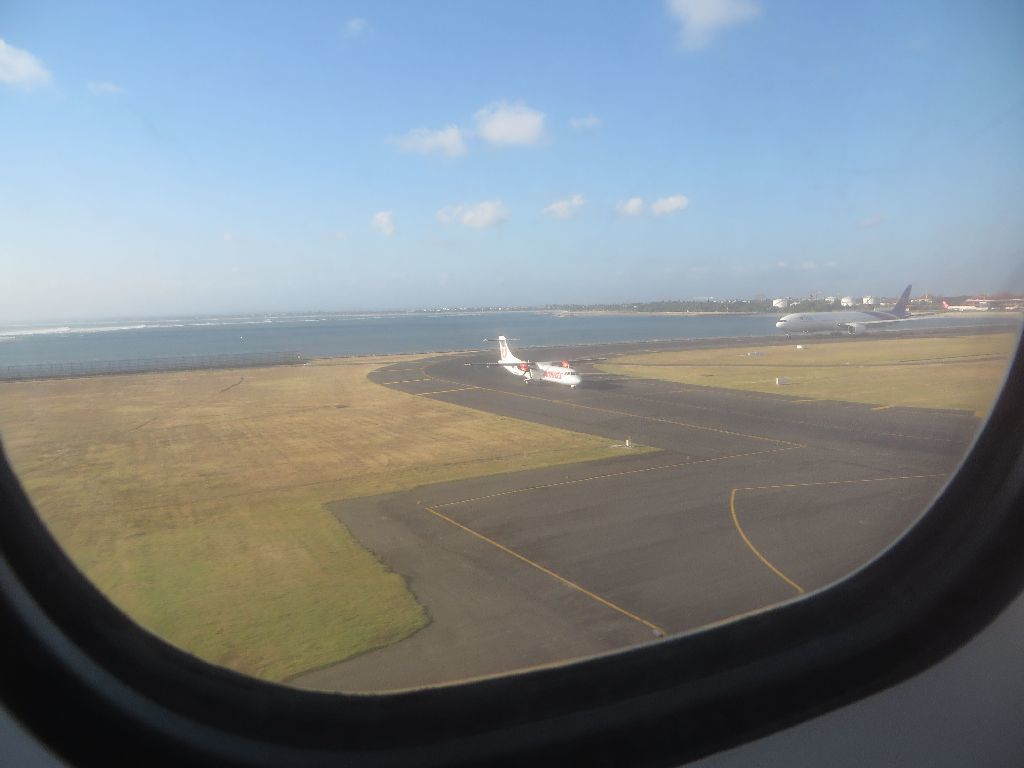
… followed by a TG aircraft
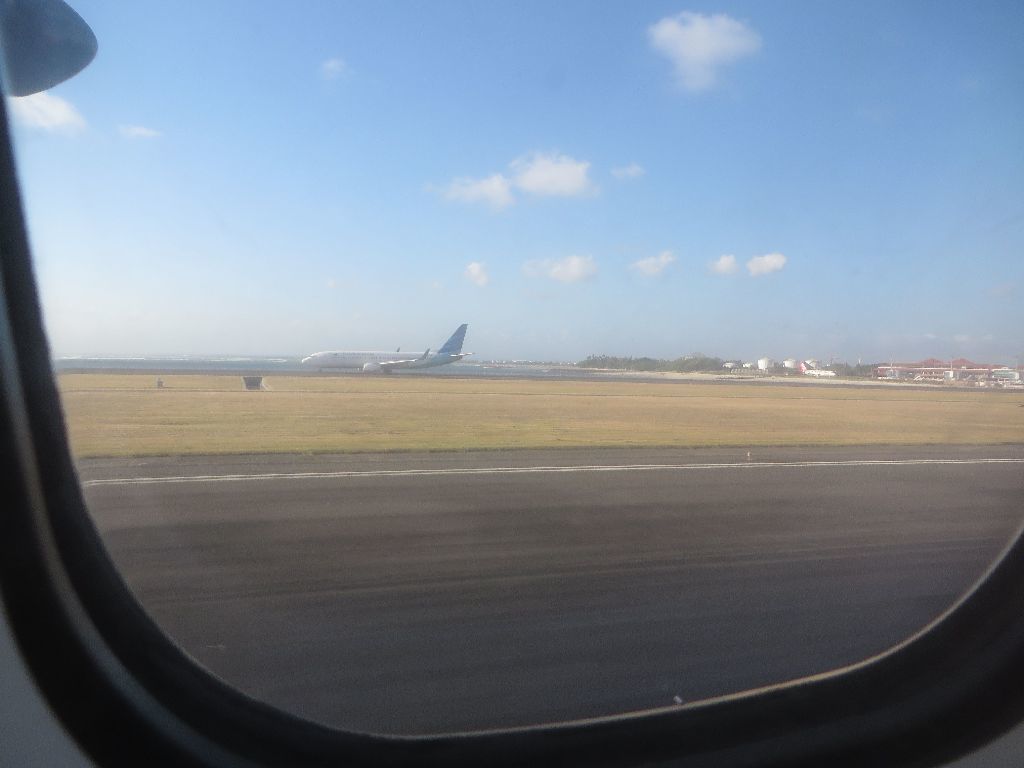
Many airlines serve DPS; the lighting did not help identifying their aircraft. On the far, this is the red and white livery of Air Asia.

I know where this one is from!
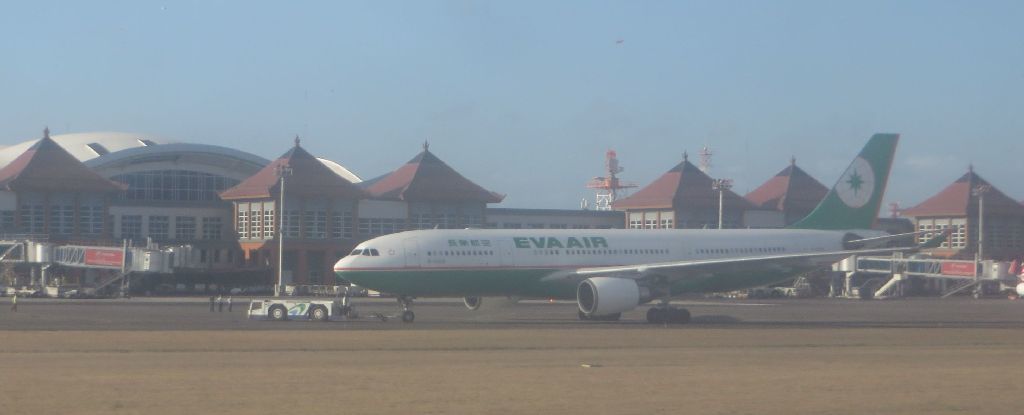
The left engine is going to be stopped
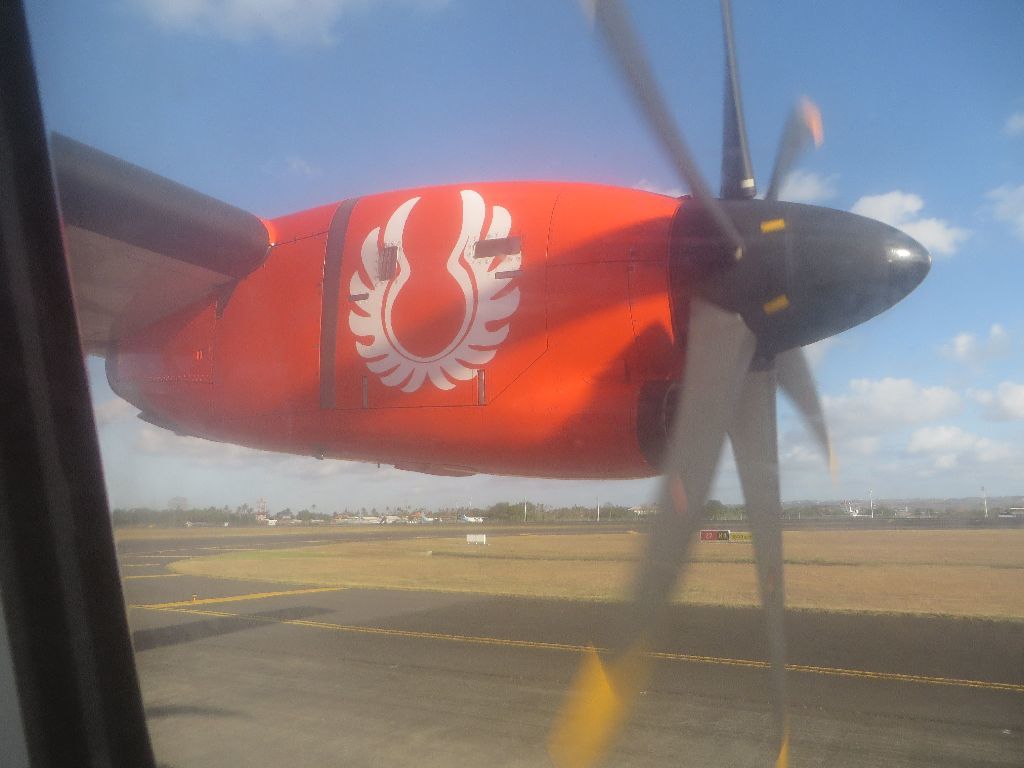
A Merpati Xi'an MA-60 and a Garuda ATR72 parked in the distance
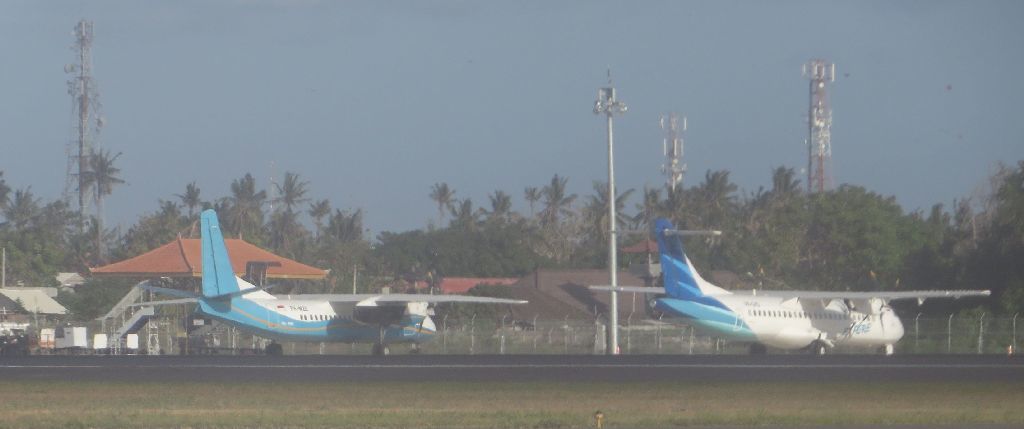
Leaving the aircraft
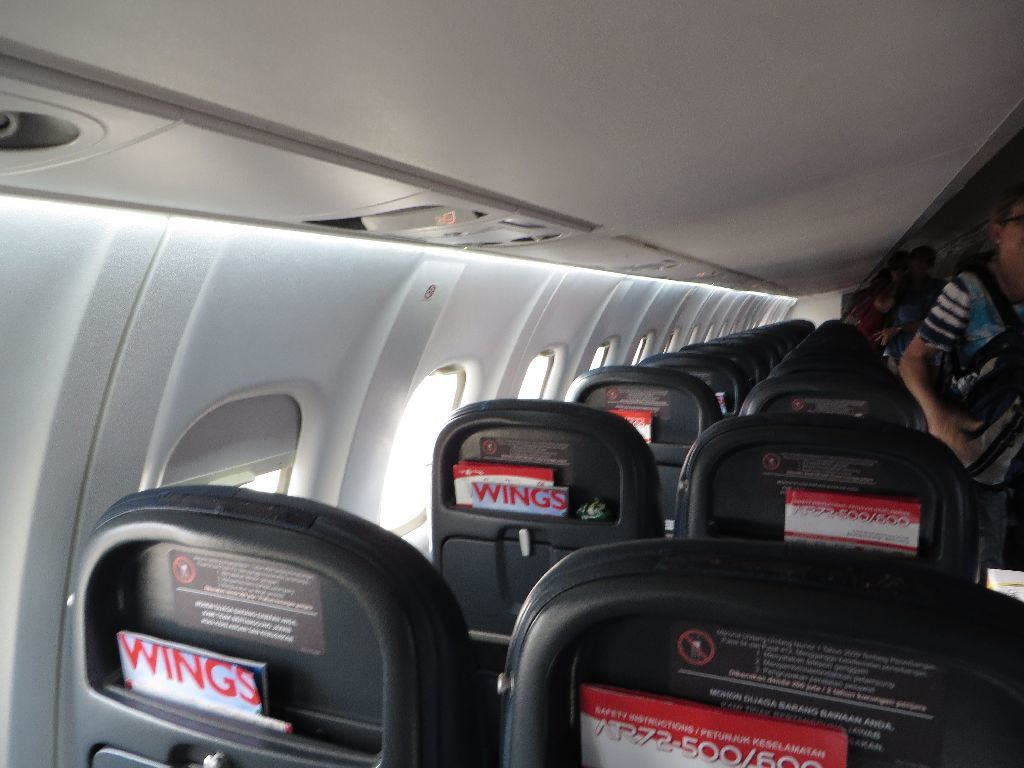
We parked very close to a terminal entrance

In DPS too, walking under the wing is OK.
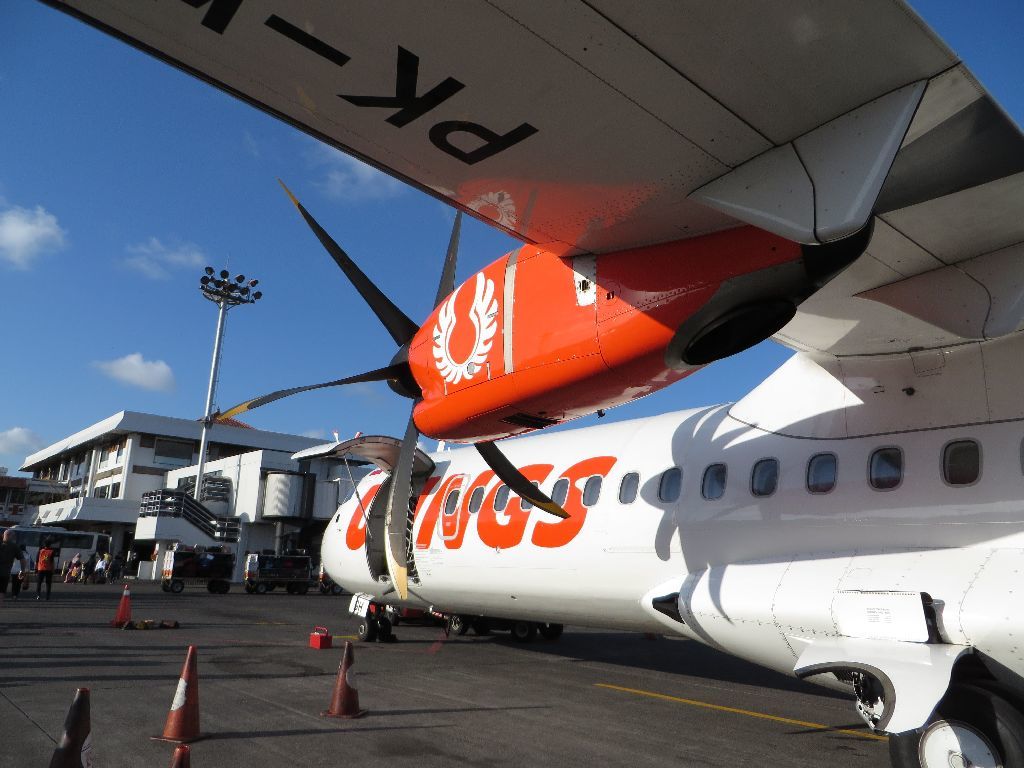
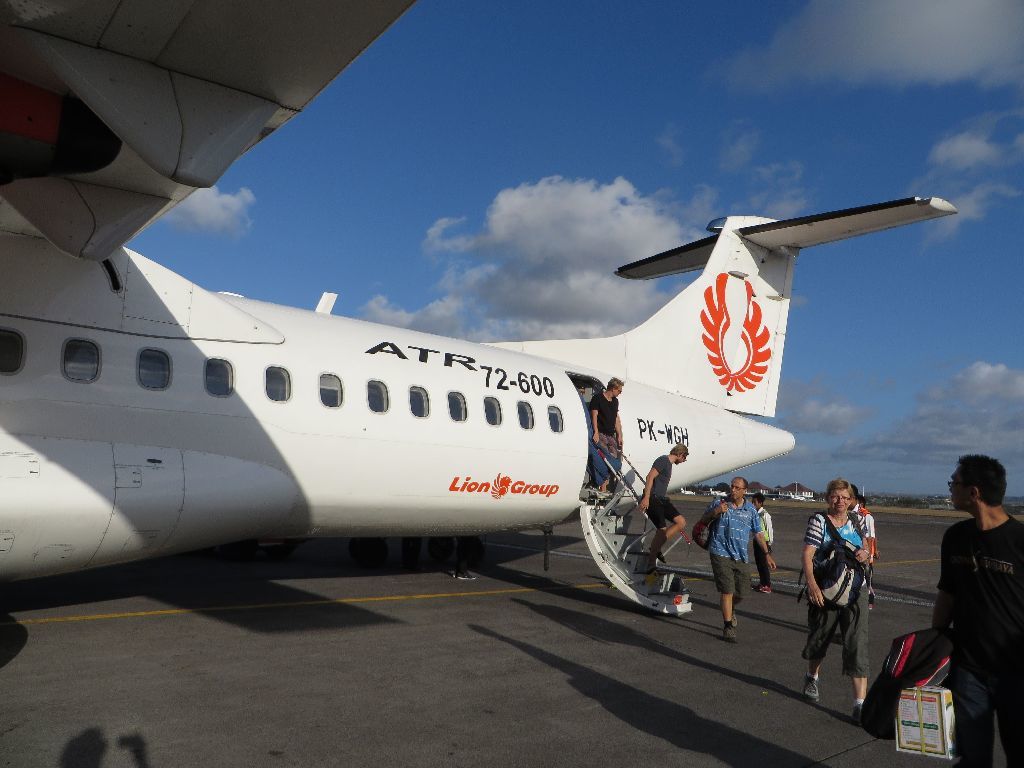
The luggage hold

The typical Hindu (and therefore Balinese) decoration of the terminal
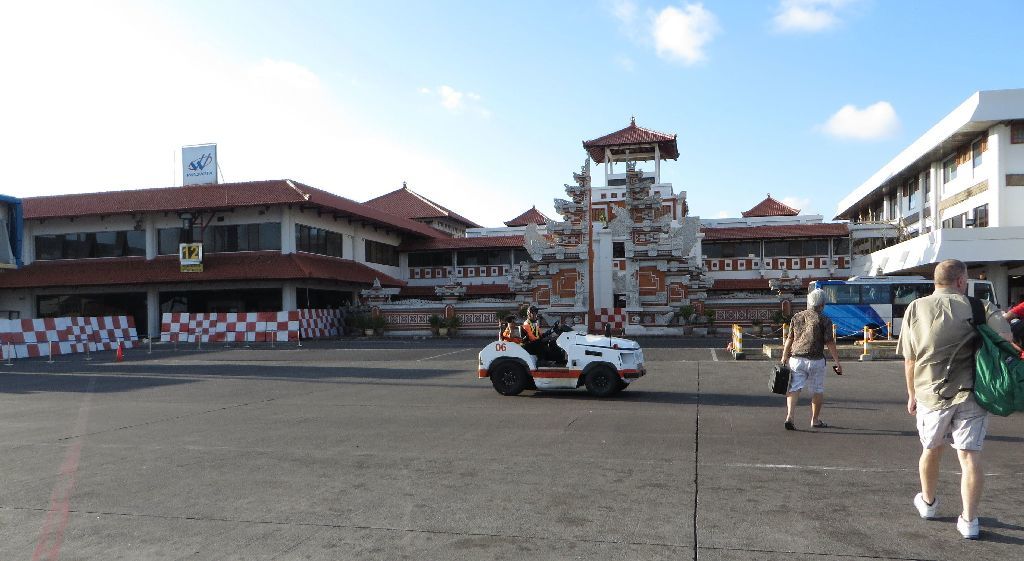
A Lion Air 737 taxies by
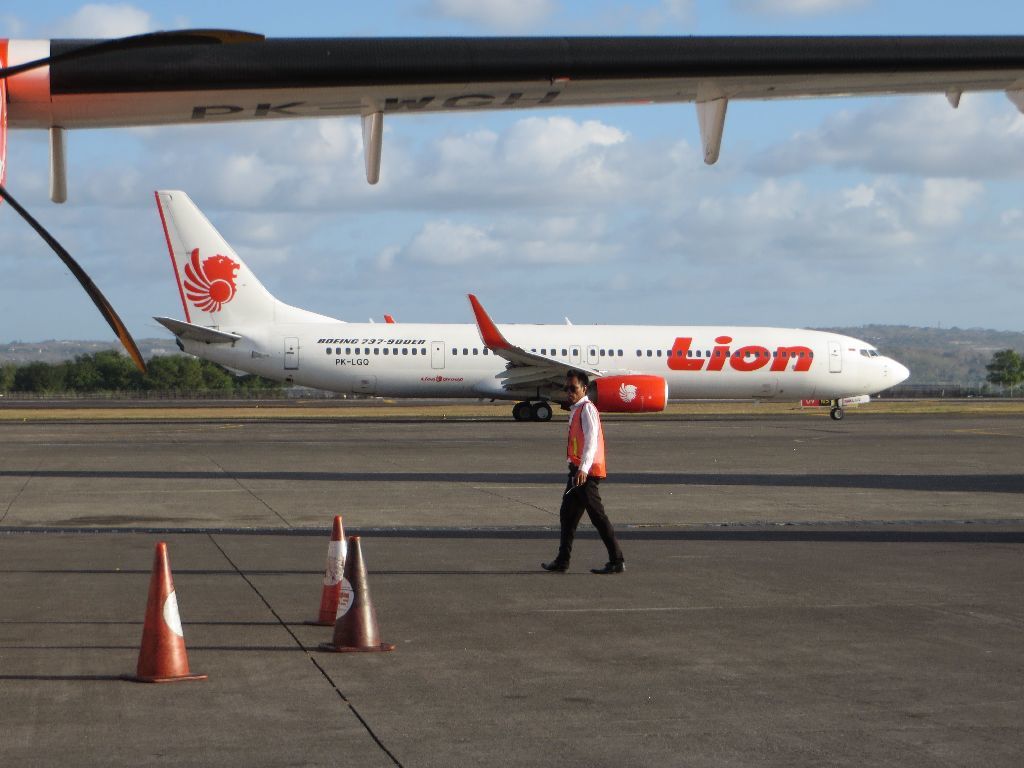
A GA 738 parked next to our ATR72
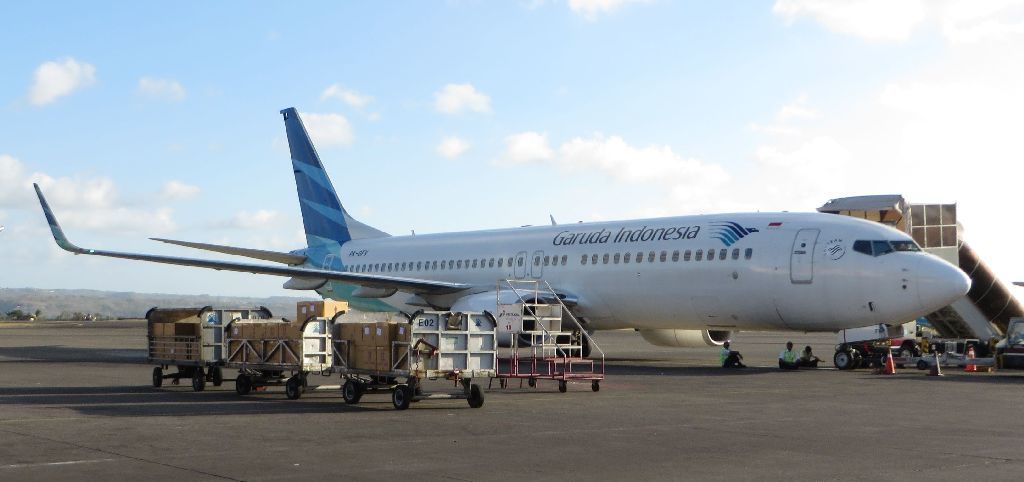
Last views of the ATR72 before entering the terminal
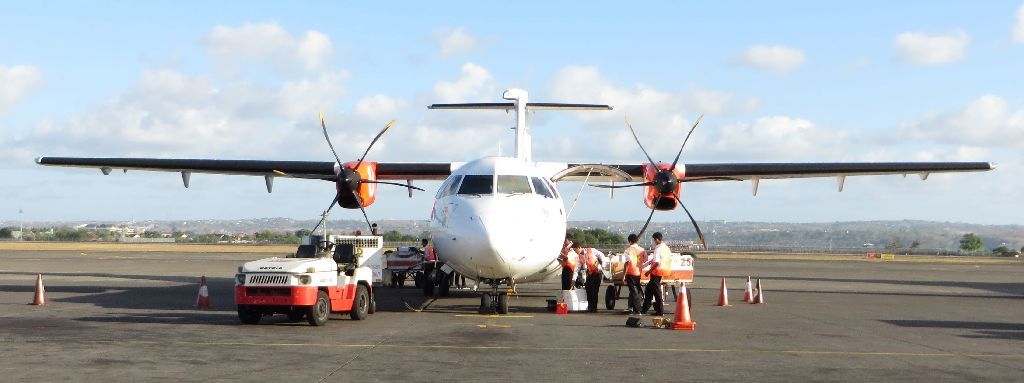

The luggage delivery room; note the presence of a woman wearing a niqab, which is rare in Java and extremely rare in Bali. There were quite a lot of passengers waiting there…
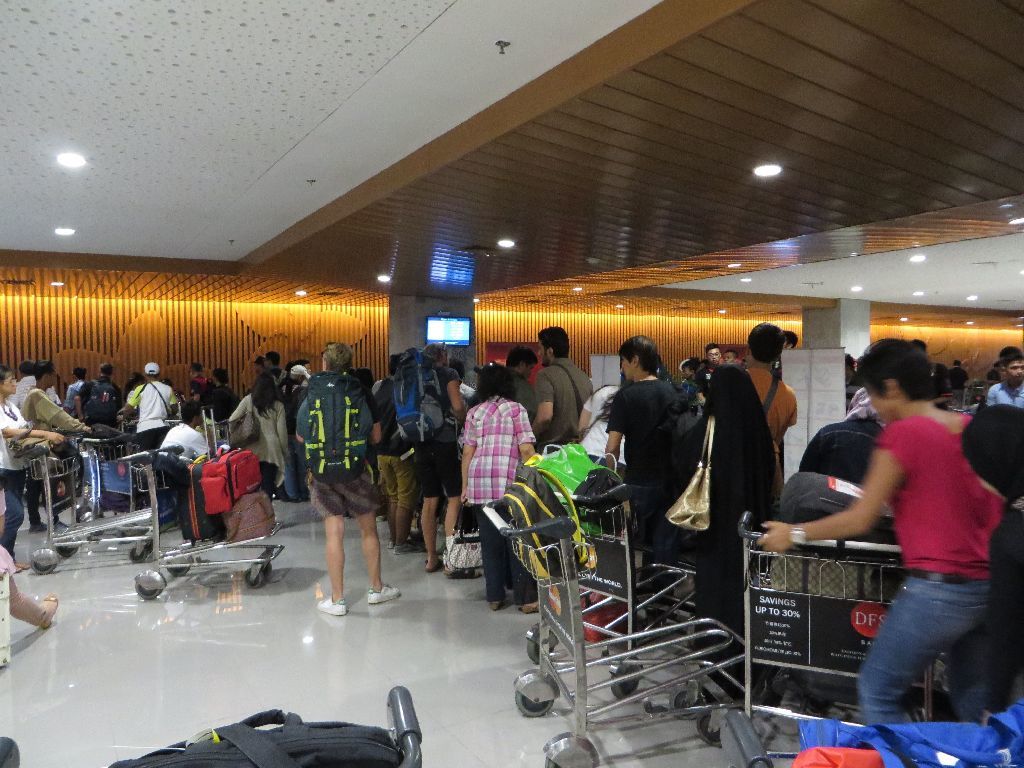
… because the luggage of three flights were being delivered at the same place
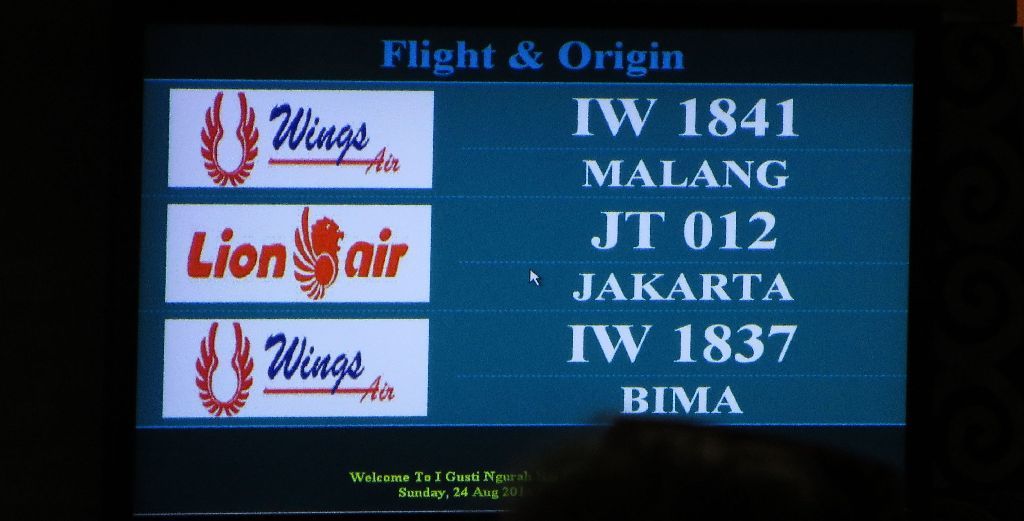
Arrival landside, and not a trace of the Avis employee who should welcome us. Avis does not have facilities in DPS (too expensive, according to the employee), and you need a rendez-vous upon arrival and departure. Two years ago, everything went well, and this time it doesn't. Could he be waiting for us at the international arrivals, despite the fact that he has our flight number ?
I leave my wife and our luggage there, and go to the new international terminal, where there is a crowd of hotel and company staff all showing their signs to the incoming passengers, out of view of the general public like me. It will be difficult… but I eventually spot a man with a red cap: bingo, he is indeed the Avis man!
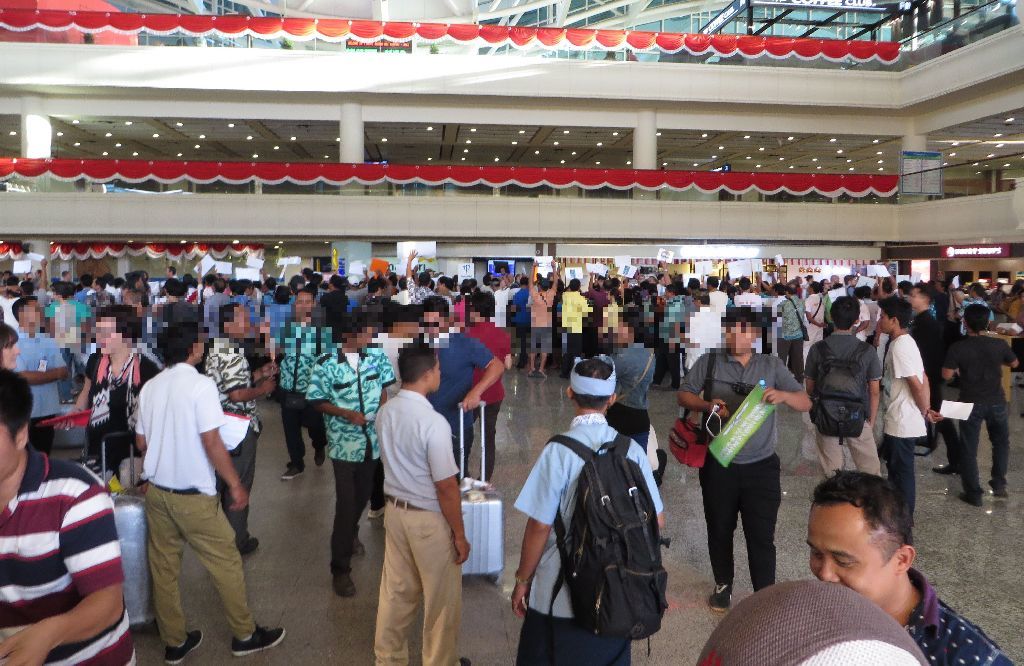
The paperwork is quickly done on a ledge, and he drives me to fetch my wife, who was wondering if I was trying again to dispose of her like in URC. This is a decoration seen on the way between both terminals.
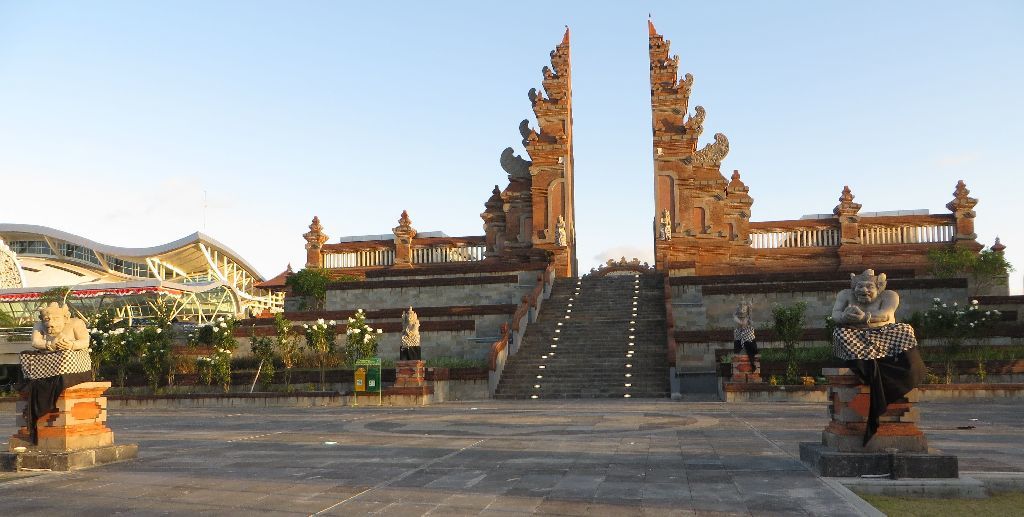
(A word of warning: we are shifting towards the tourist bonus. You can skip to the conclusion if you are not interested)
Why rent a car with Avis, although
- The logistics at the airport are more complicated
- The local car rentals are cheaper
- Avis only rents in DPS wide or very wide vans, to be driven on narrow or very narrow roads ?

Because:
- my company has very good negotiated fares with Avis
-the deductible in case of problem was 500,000 IDR, or 50 USD, which reduces worries when you drive on the left side of a narrow or very narrow road a wide or very wide van.

I took a wrong turn there, and the ensuing U-turn was a tricky business
But in Java, I chose to rent cars with drivers because
- there was a lot of driving, and I would rather get some rest between visits
- it was very affordable
- we could be dropped hours of driving away from where we started
- directions can be difficult to find
- driving in Java obey to special rules
This last reason is the easiest to illustrate. A few dozen hours on the Javanese roads reminded me of some of my best memories of Mainland China, when I always chose to sit next to the driver to enjoy the video game – correction, the driving. In Java, a main road has on both sides of an often continuous center line:
- a main lane for cars and trucks
- a much narrower lane for numerous 125cc motorcycles and much fewer bicycles
- a shoulder of variable width
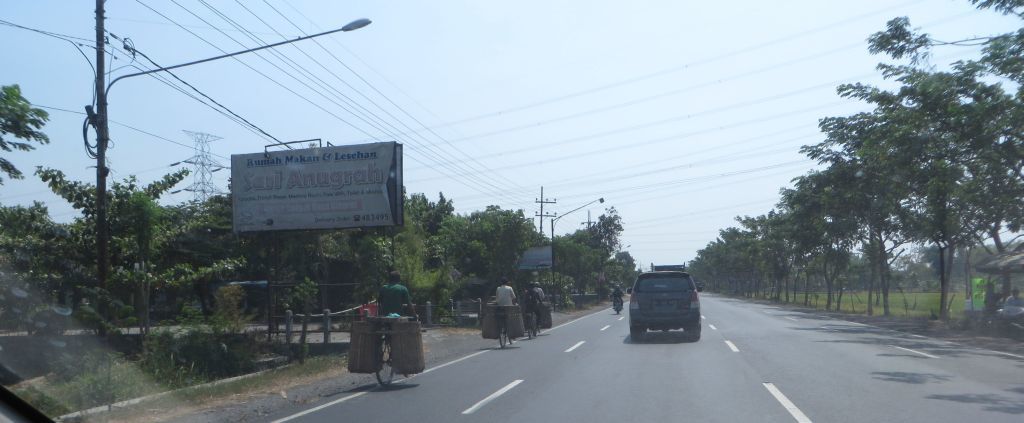
Since the main lane is often used chock a block by trucks in both directions, passing is only on the left, i.e. the wrong side. We have here an interesting synthesis:
- Our driver passes a line of trucks, using as usual the motorcycles' lane
- He is being passed by more aggressive drivers on his left, driving on the shoulder
- The latter are passed on the far left part of the shoulder by a couple on their motorcycle, because where there is a Javanese motorcycle, there is a way
- the shoulder width suddenly shrinks because of a power pole
All that with the sun right in front, because it wouldn't be as much fun otherwise
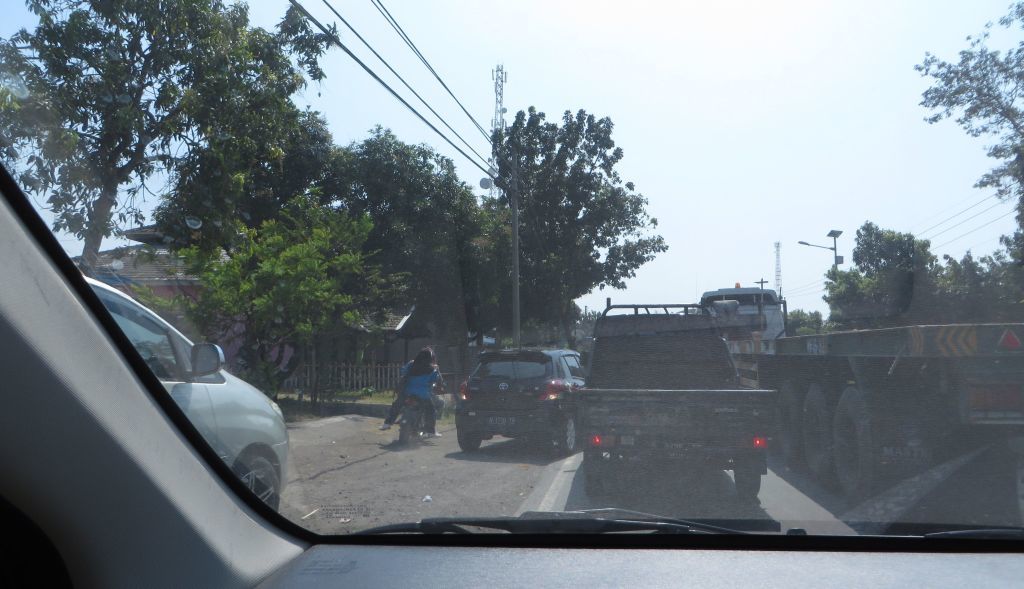
All that to reach two of the most famous volcanoes on Java Island, for which Malang is an ideal logistic base.
Dawn on Mt Bromo is one of the must see in Java. I can ensure you that even though we had reached the place an hour in advance, we battled to keep our meter-wide quasi-ideal viewing space until sunrise.
Dawn comes on the caldeira filled to the brim with clouds.

Mt Batur in front of Mt Bromo with its smoke plume
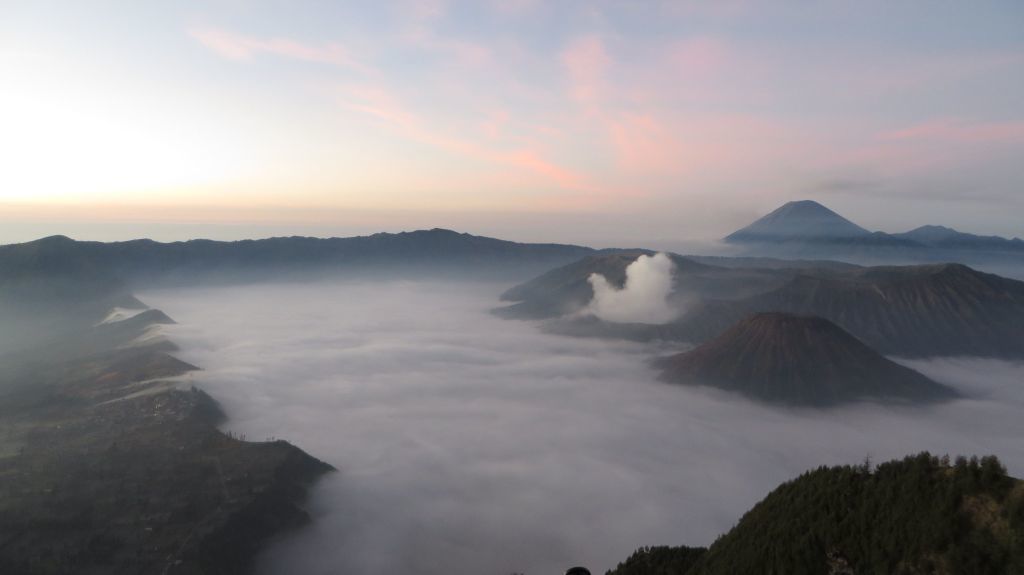
And Mt Semeru in the background – the highest volcano in Java, which is active too.
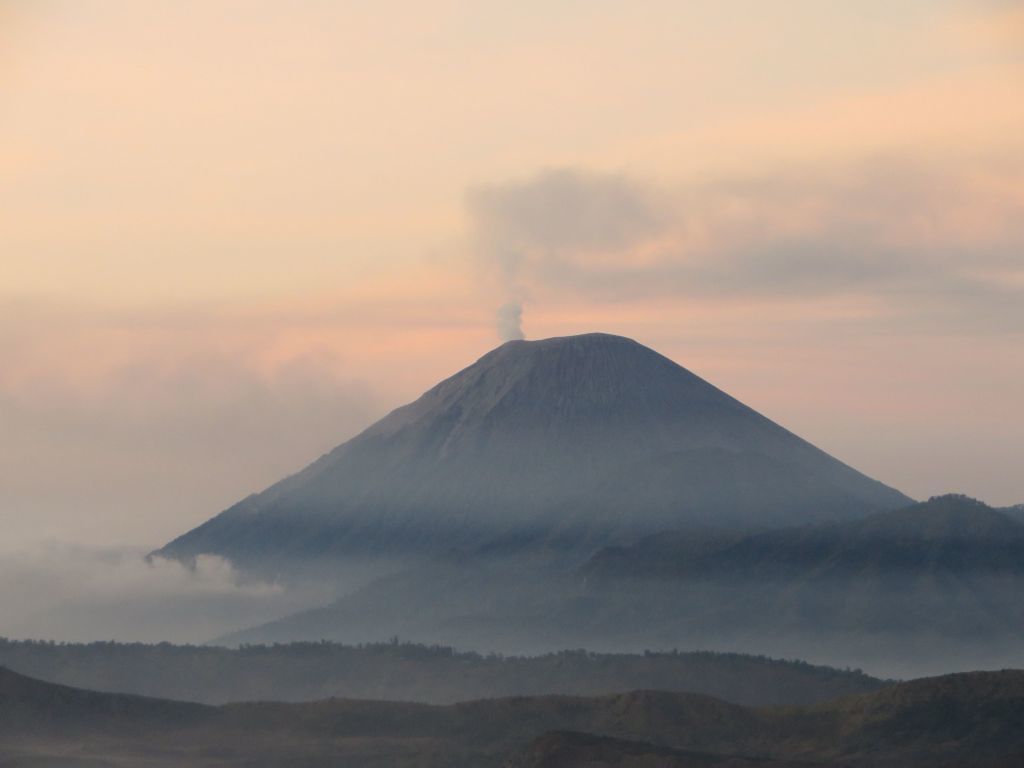
The sun rises at last
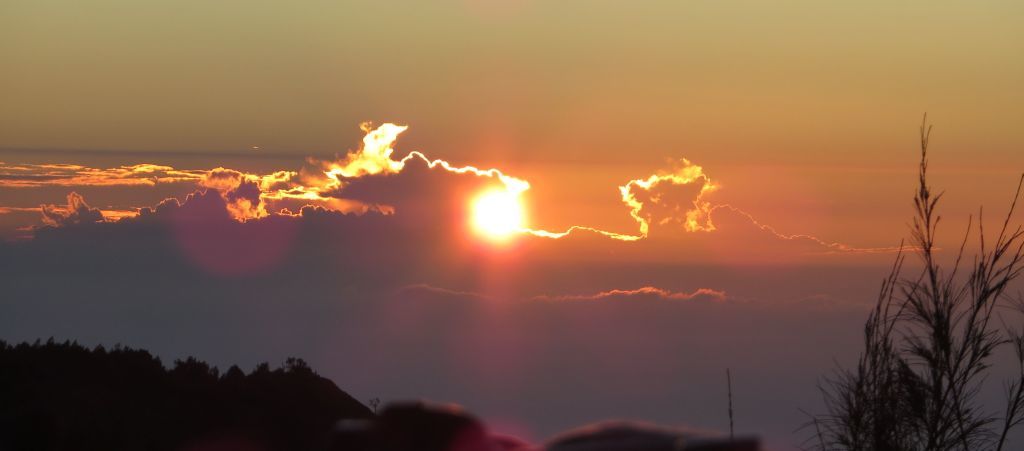
… and lights up this landscape for which the alarm clock rang at 2:45 that morning.


Mt Batur above the morning mist, shot later from the slopes of Mt Bromo.

Mt Bromo's crater

Mt Batur. The first pictures have been taken three hours earlier from the summit in the background.
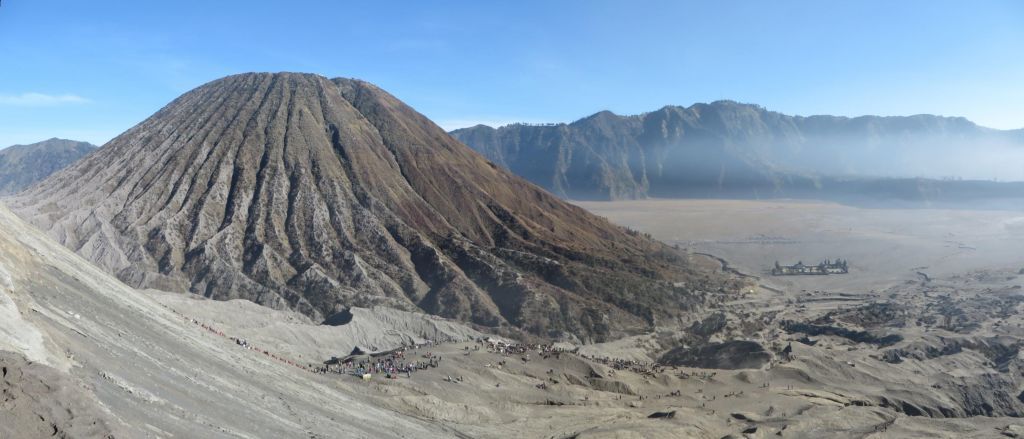
The other must see in the region is the Kawah Ijen, located at the eastern end of Java island. The alarm clock rang at 23:30 this time, because there were two hours of driving followed by a two hour hike, and we needed to be there at night. The Kawah Ijen is an active volcano which continuously sends a friendly 1100° F gas mixture of sulfur, sulfur dioxide, hydrogen sulfide, sulfuric acid and hydrochloric acid (the crater lake is deemed to be the most acidic on earth). The gaseous sulfur becomes liquid, then solid as it cools down.
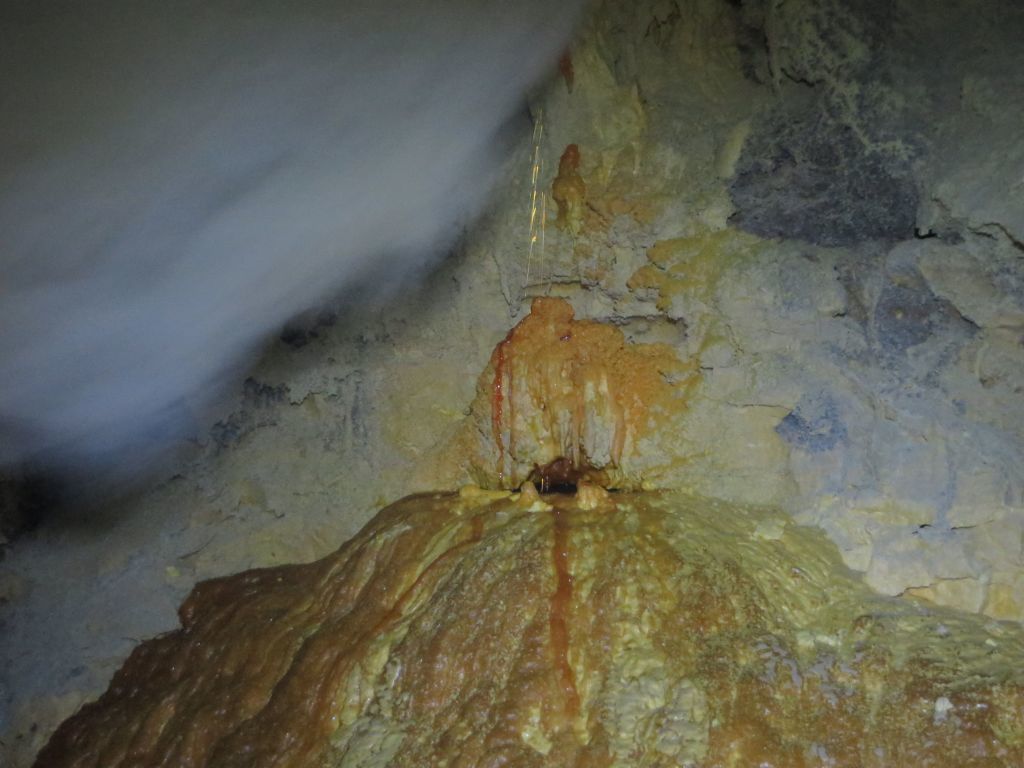
Hydrogen sulfide burns spontaneously, yielding spectacular blue flames visible in the night only.
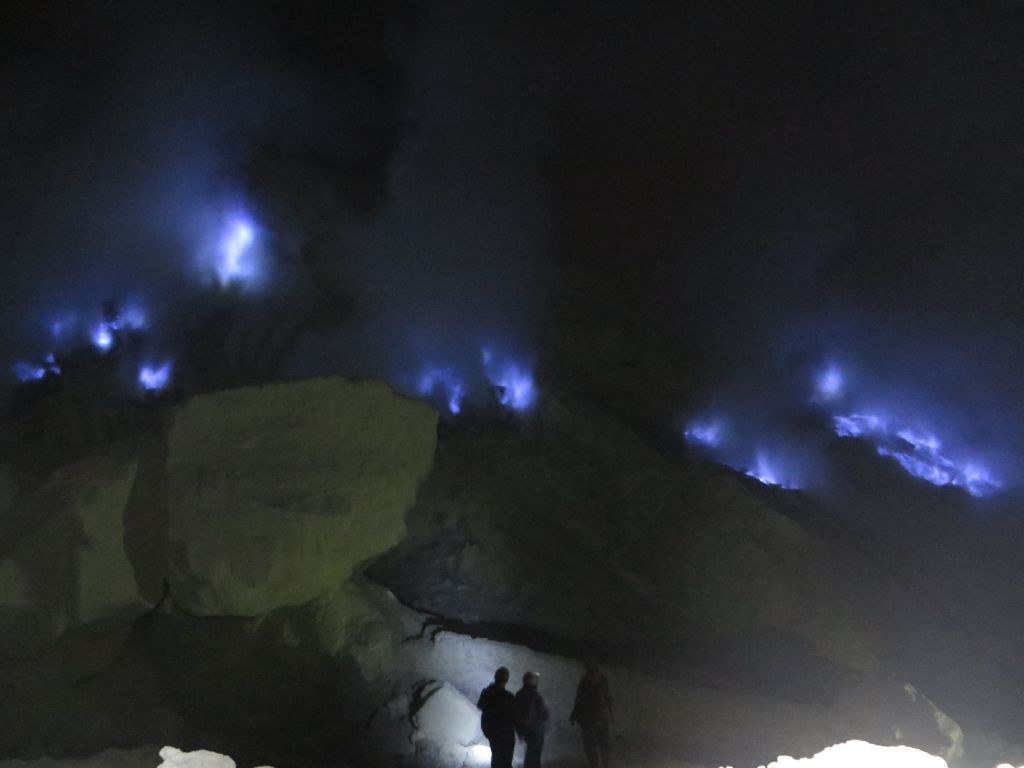
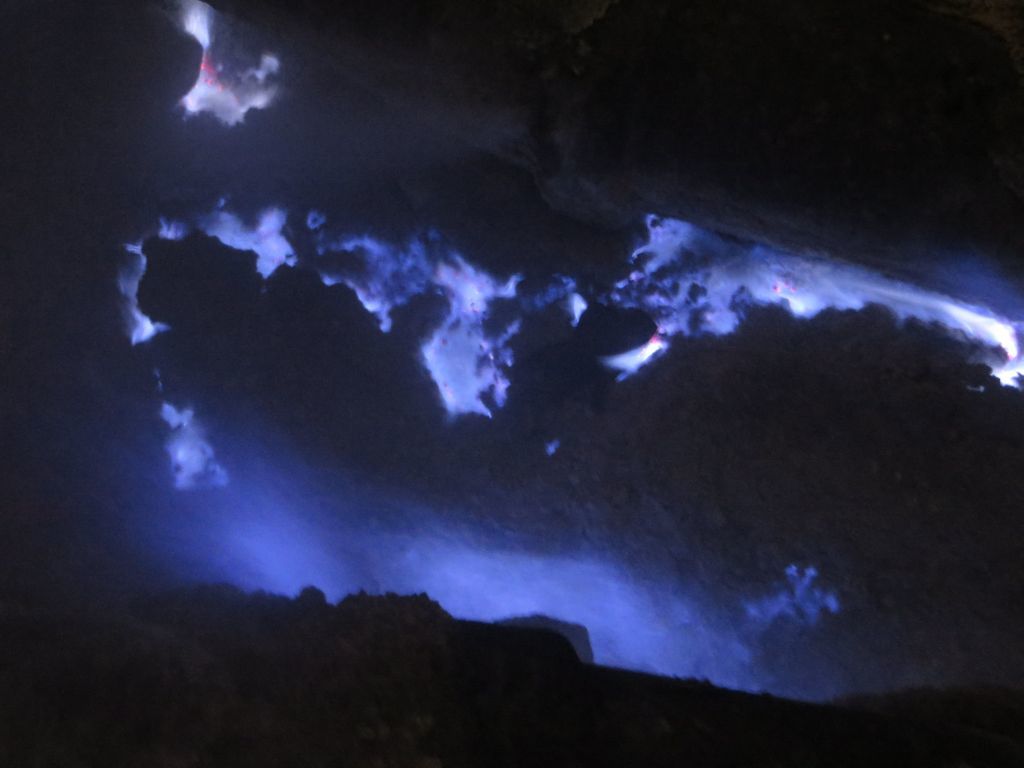
The scenery fades away at dawn.
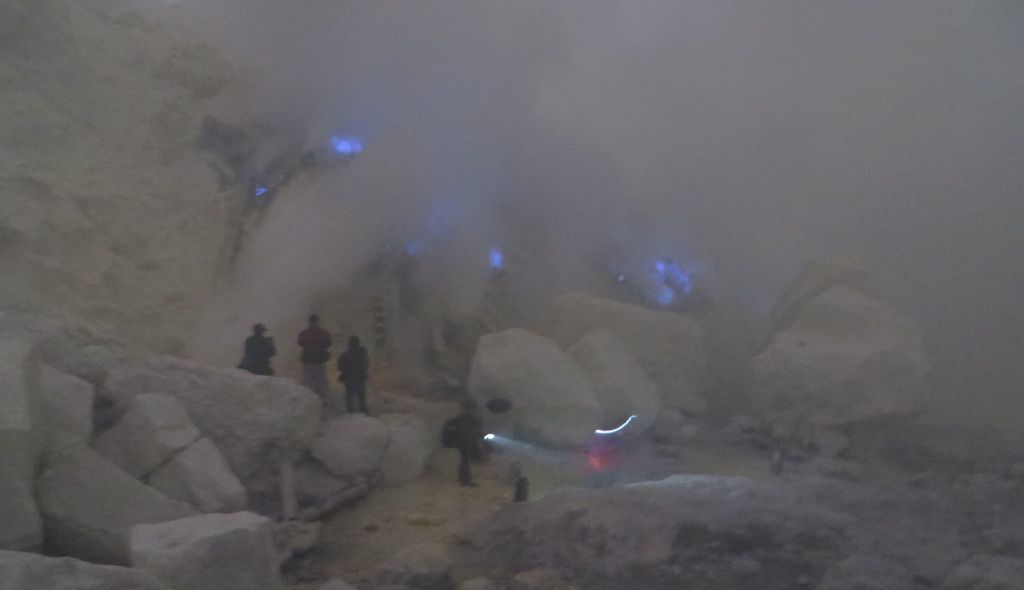
The unstable wind pushes unpredictably the above mentioned friendly gas mixture towards whoever is in the crater or on the rim. Most visitors try to protect themselves with inefficient scarves or surgical masks and cough agonizingly. Few have been wise enough to have procured a professional gas mask in their home country, like we did.
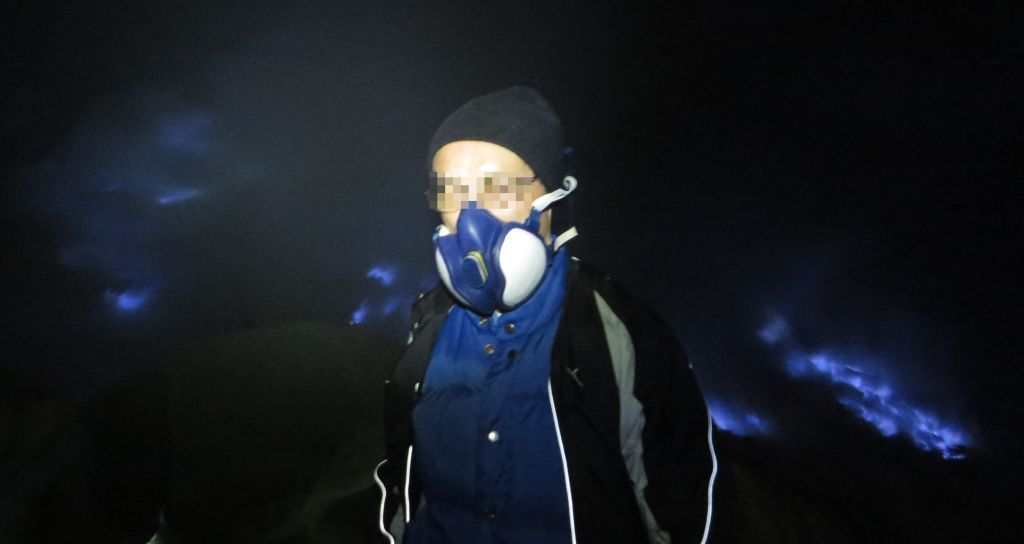
There are tourists, there are their guides, and there are the sulfur miners. Wretched souls do work in the hellish environment of the Kawah Ijen: pipes capture the gaseous sulfur which condenses,


… and the solidified sulfur is broken up with crowbars to be carried up from the crater deep, then down the steep trail to the road, over three kilometers away.
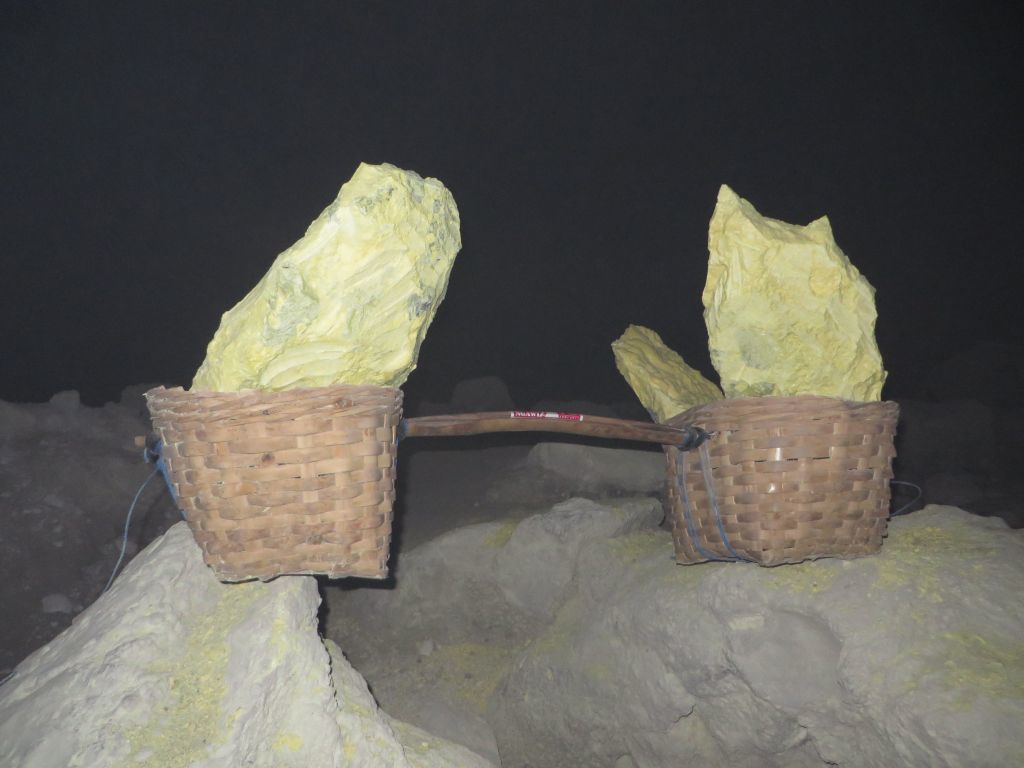
These miners make four round trips per day, in the morning to avoid the heat
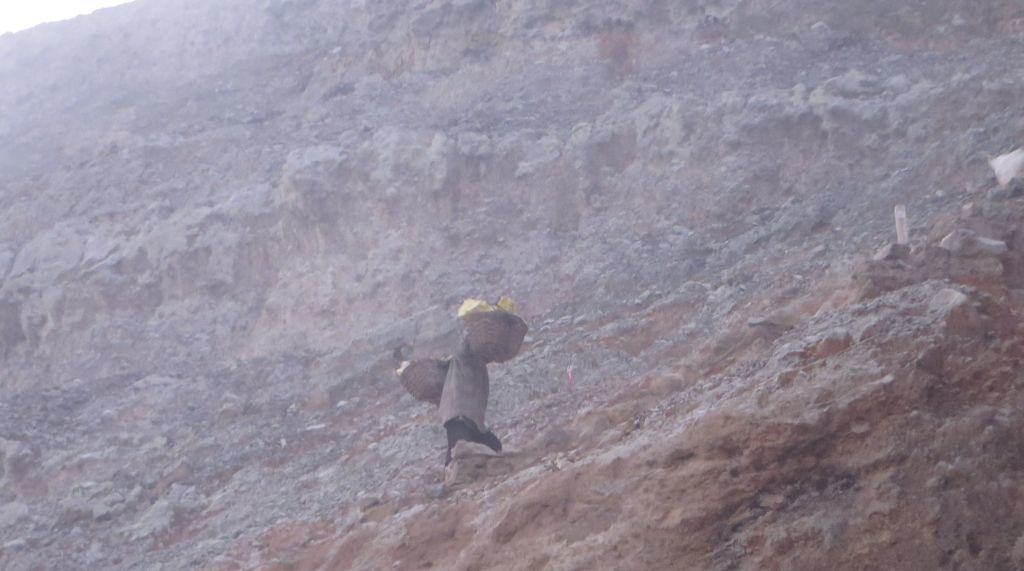
They carry between 55 kg and 75 kg each time
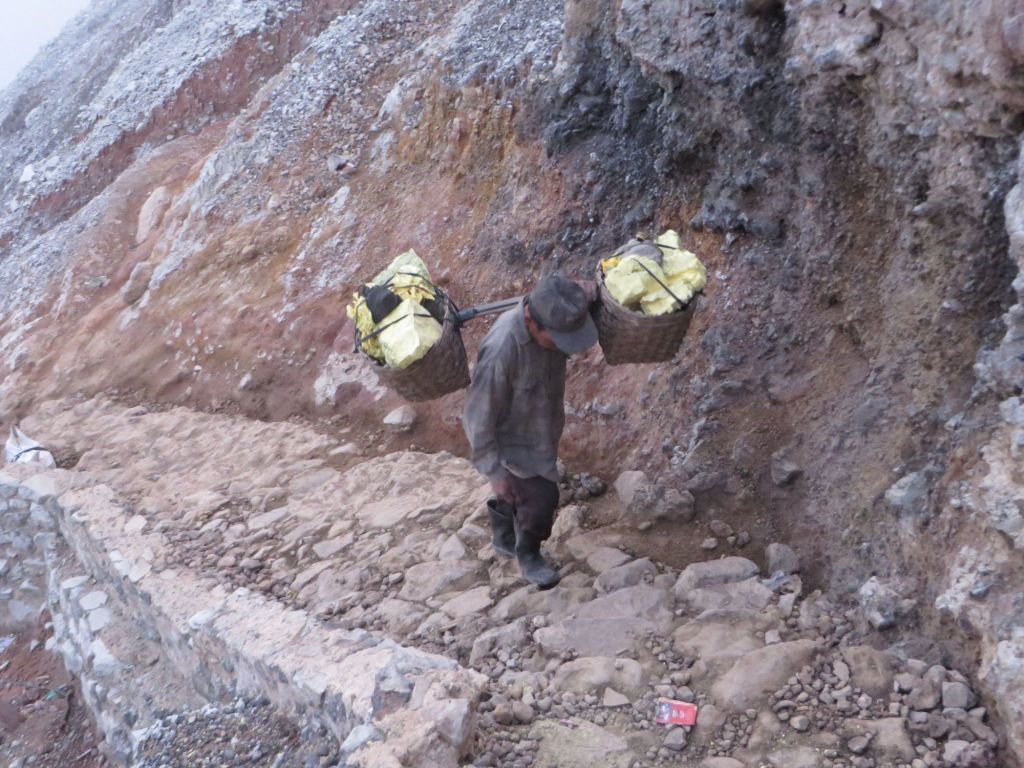
… and are paid 800 rupiah per kilo, i.e. 6.5 US cents.

They make three times as much as if they worked in the fields, but the toxic gases burn their lungs and the excess loads that they carry dislocate their bodies, so that many do not survive beyond the age of forty.
Our guide – also a sulfur miner the rest of the day – was overjoyed to receive our excellent gas masks. His lungs will get a respite while these masks last, but his shoulders will continue to be blistering wounds. As long as Indonesia has not developed enough, men will keep ruining their health in the hell of the Kawah Ijen sulfur mine.
